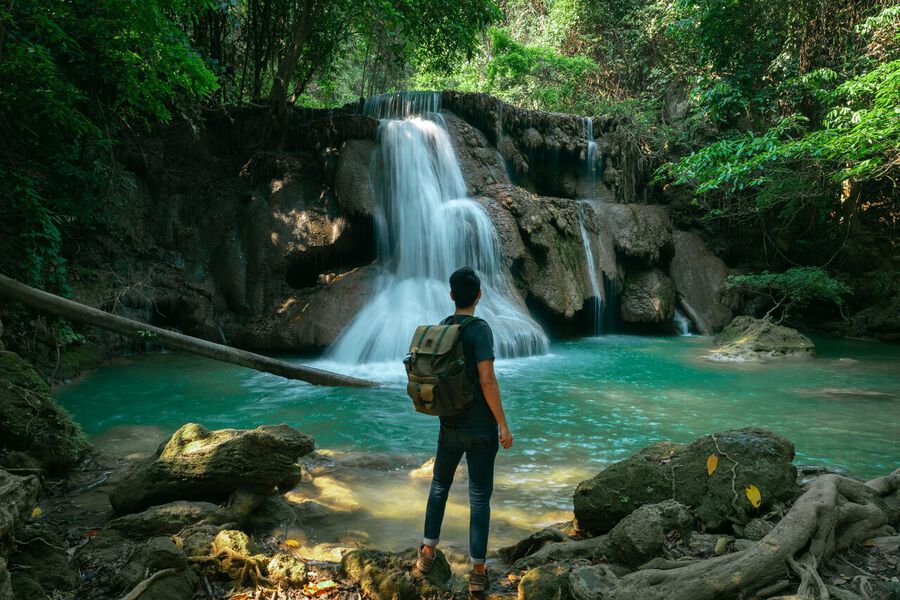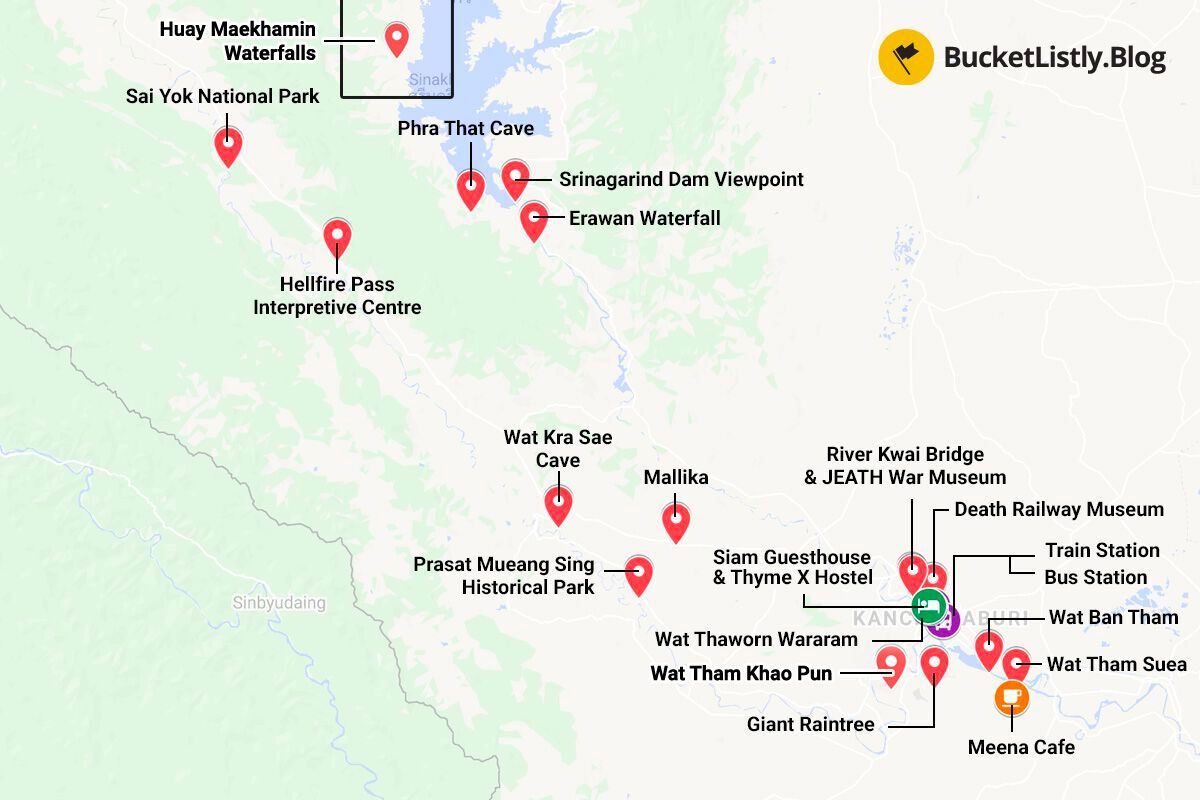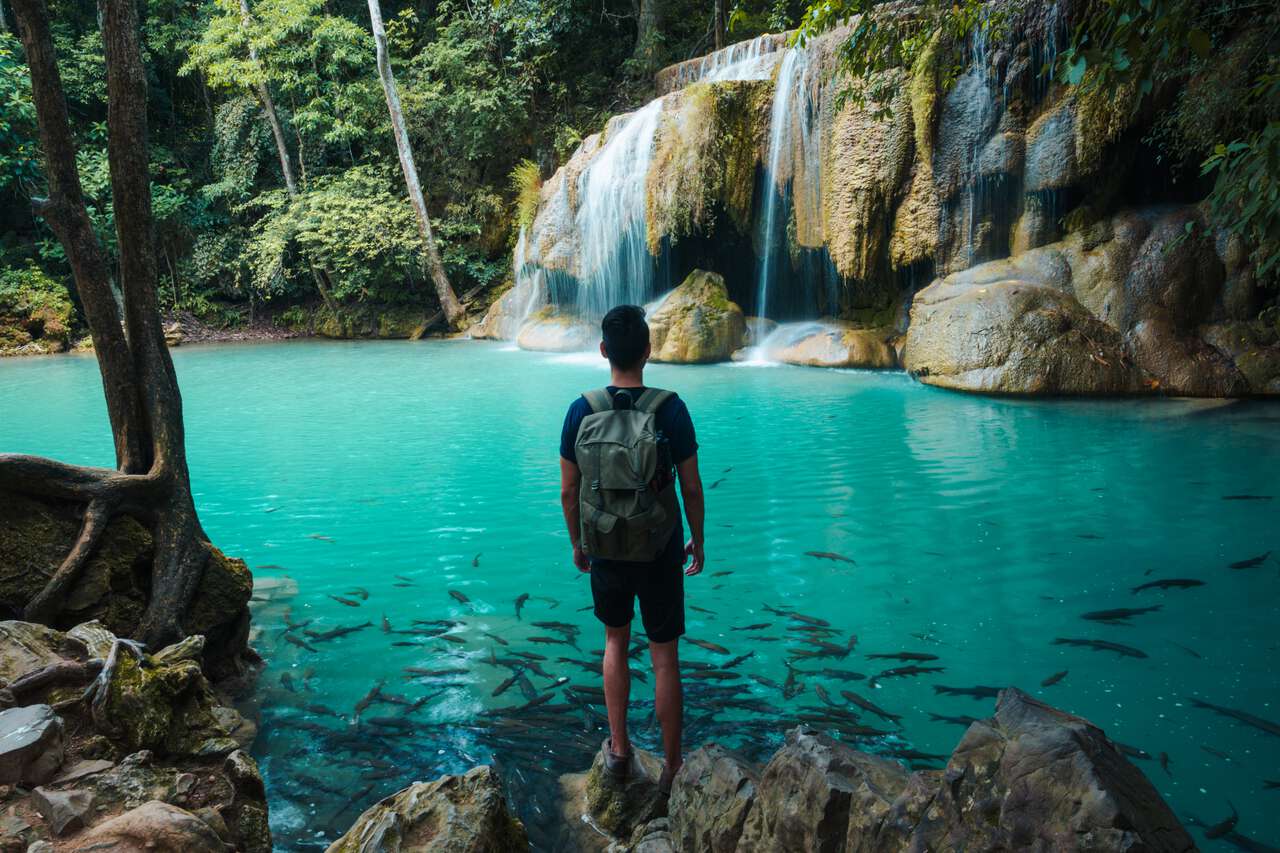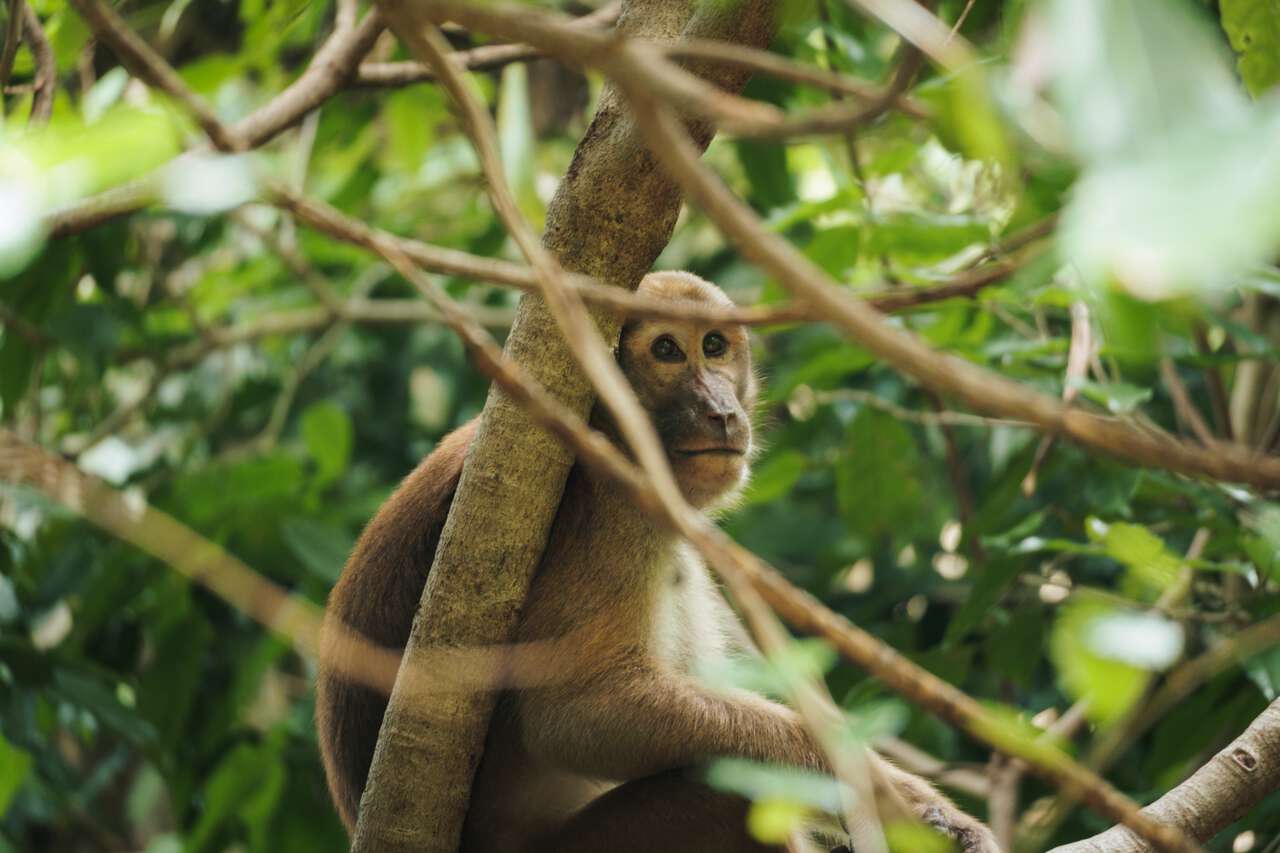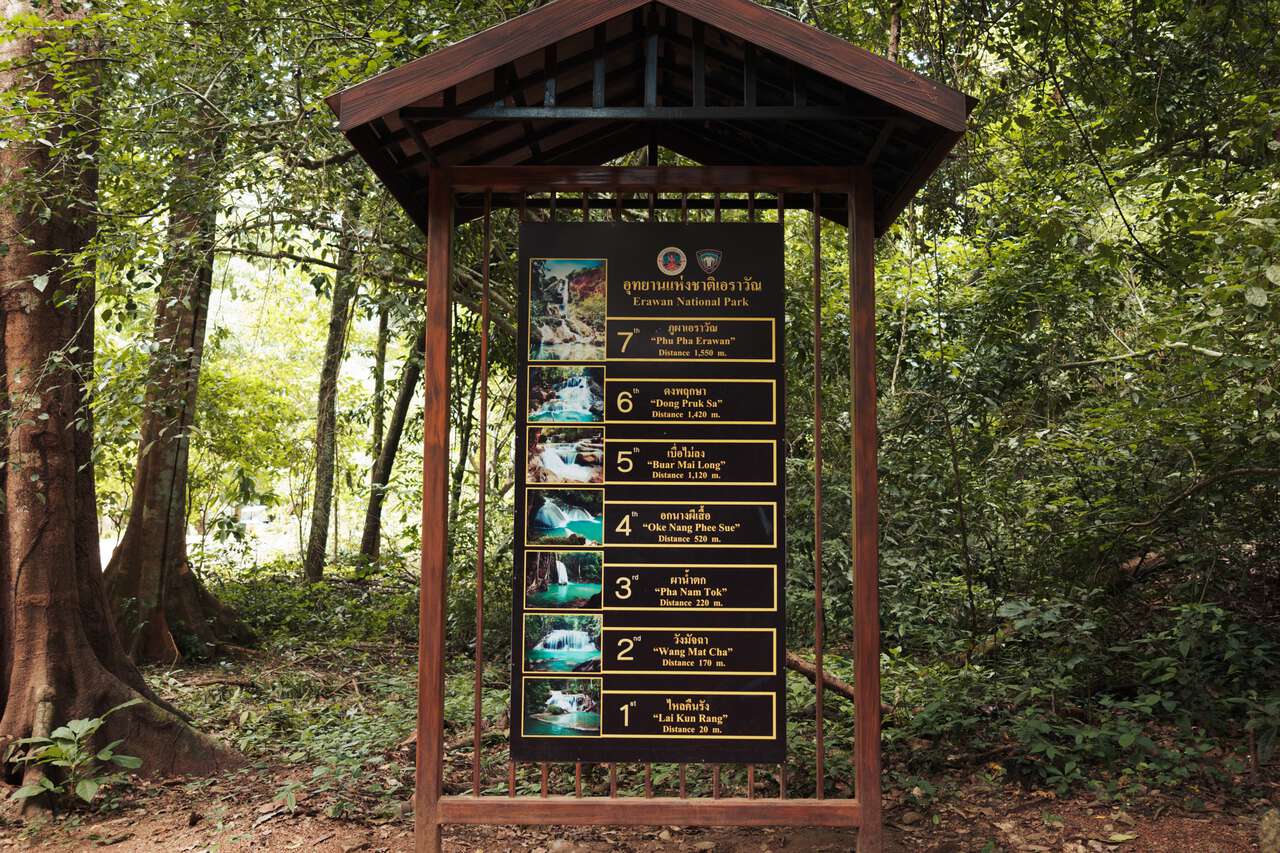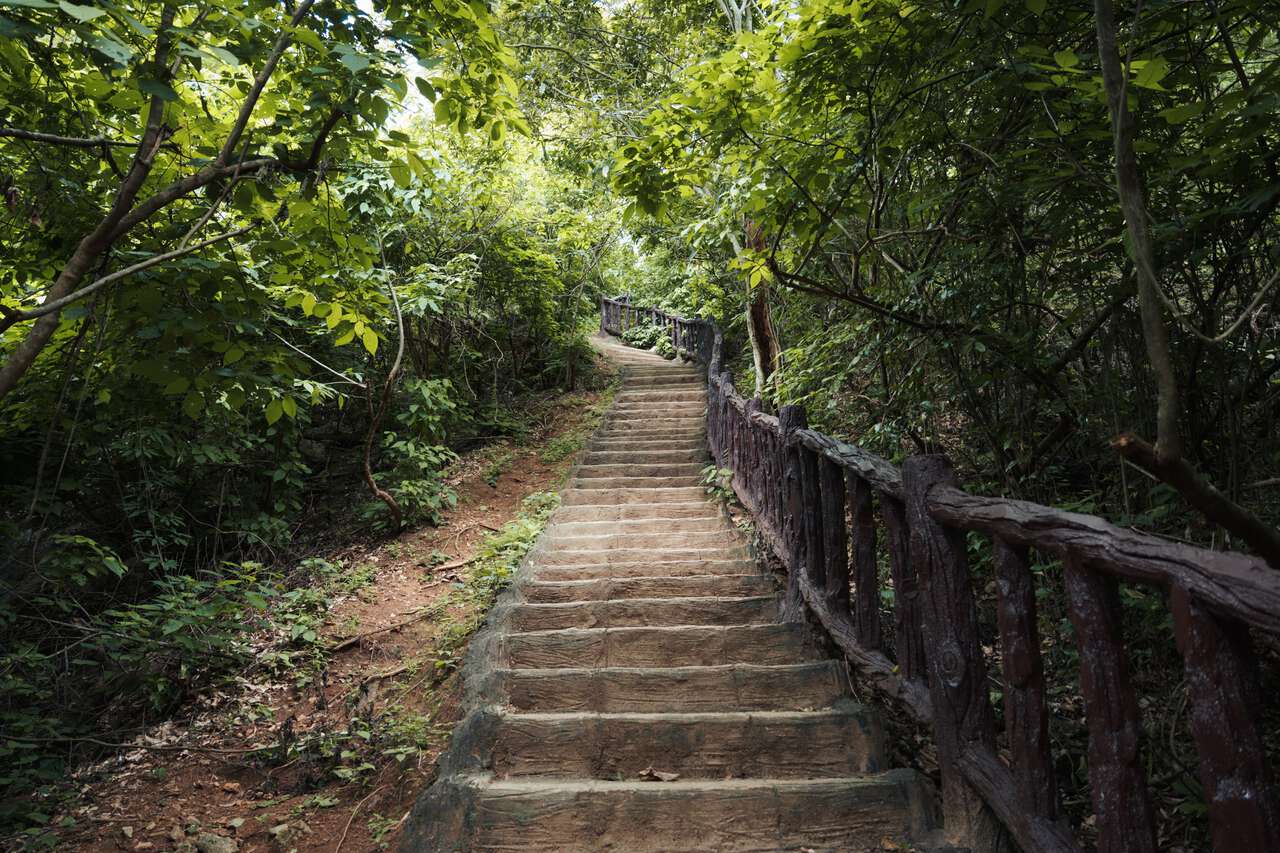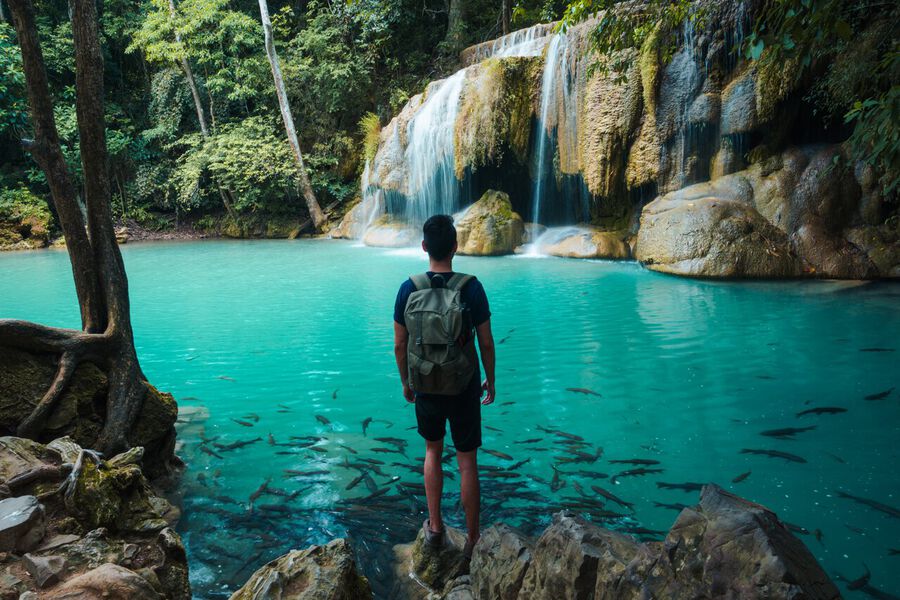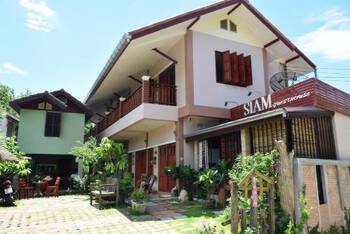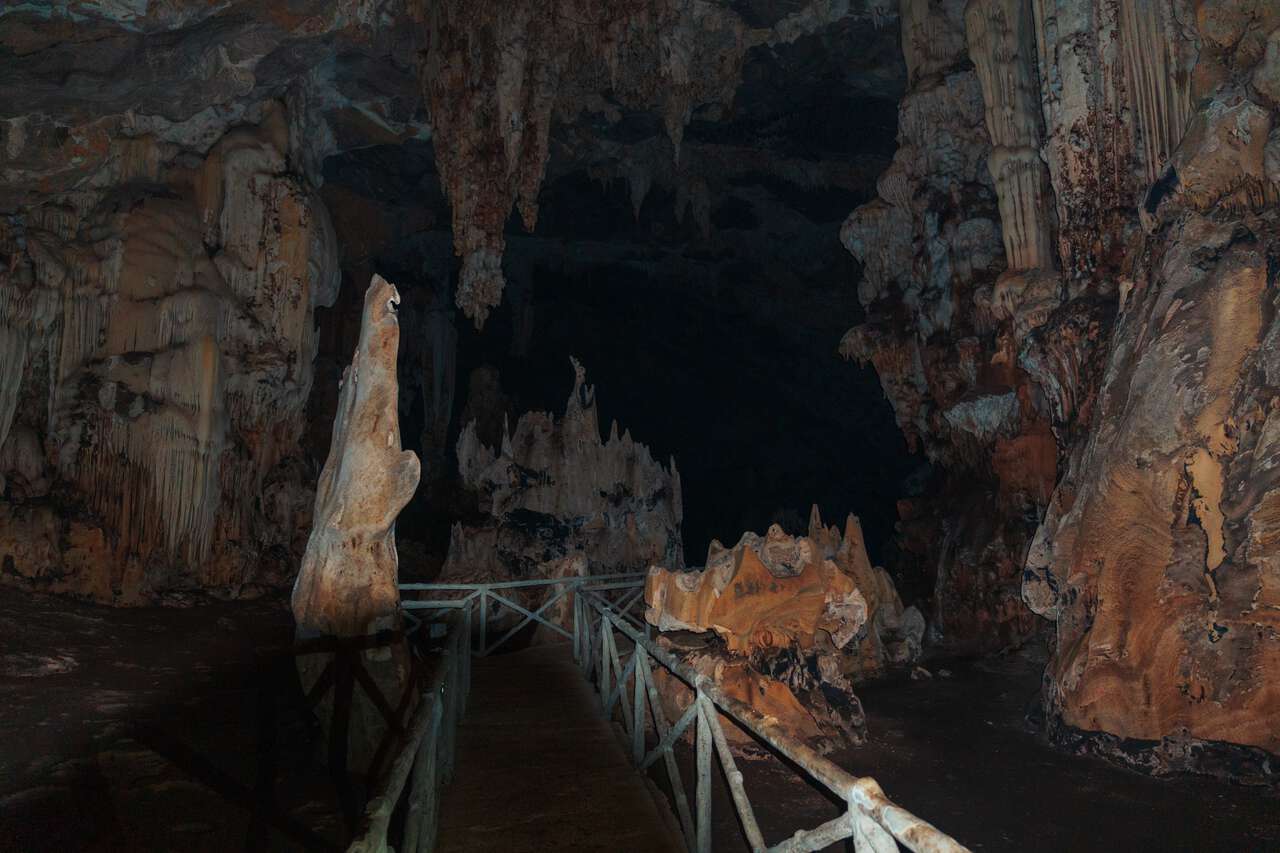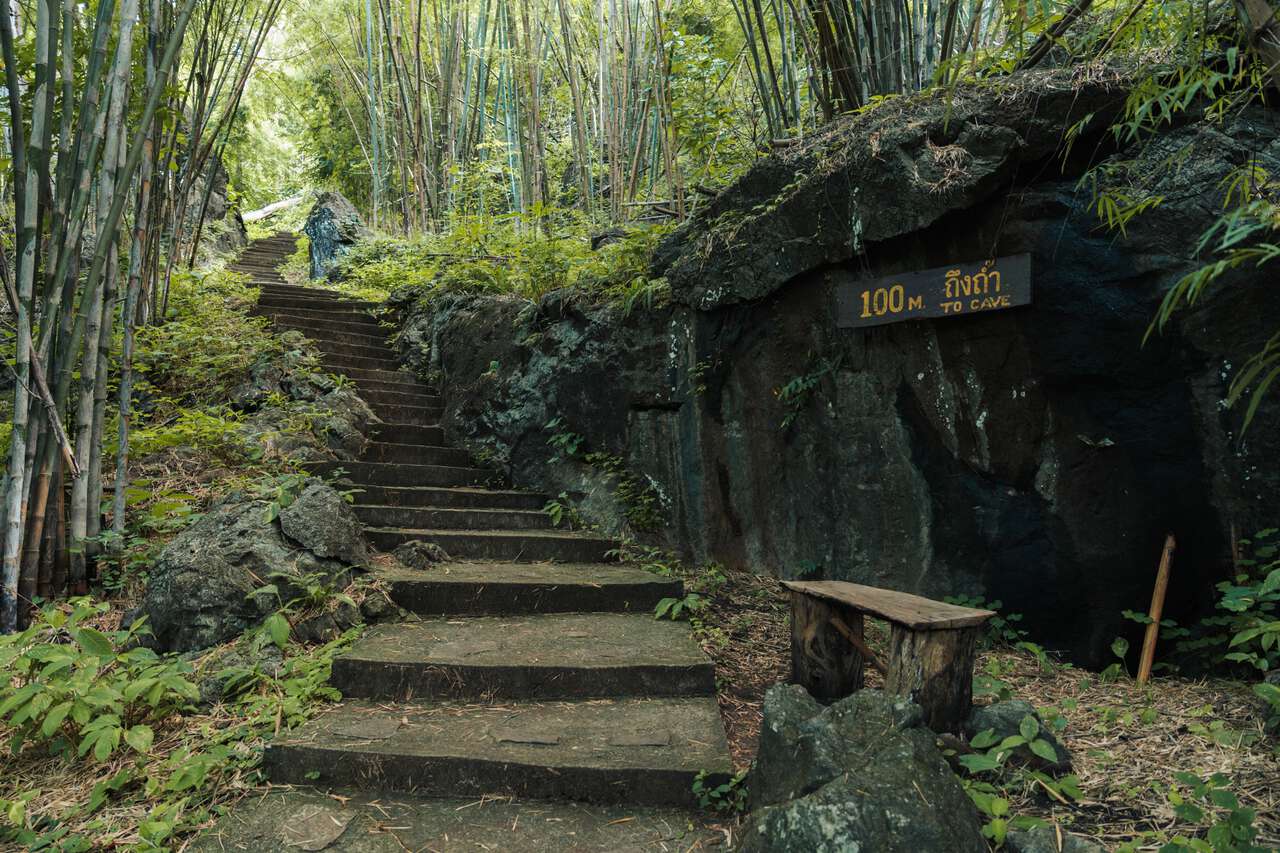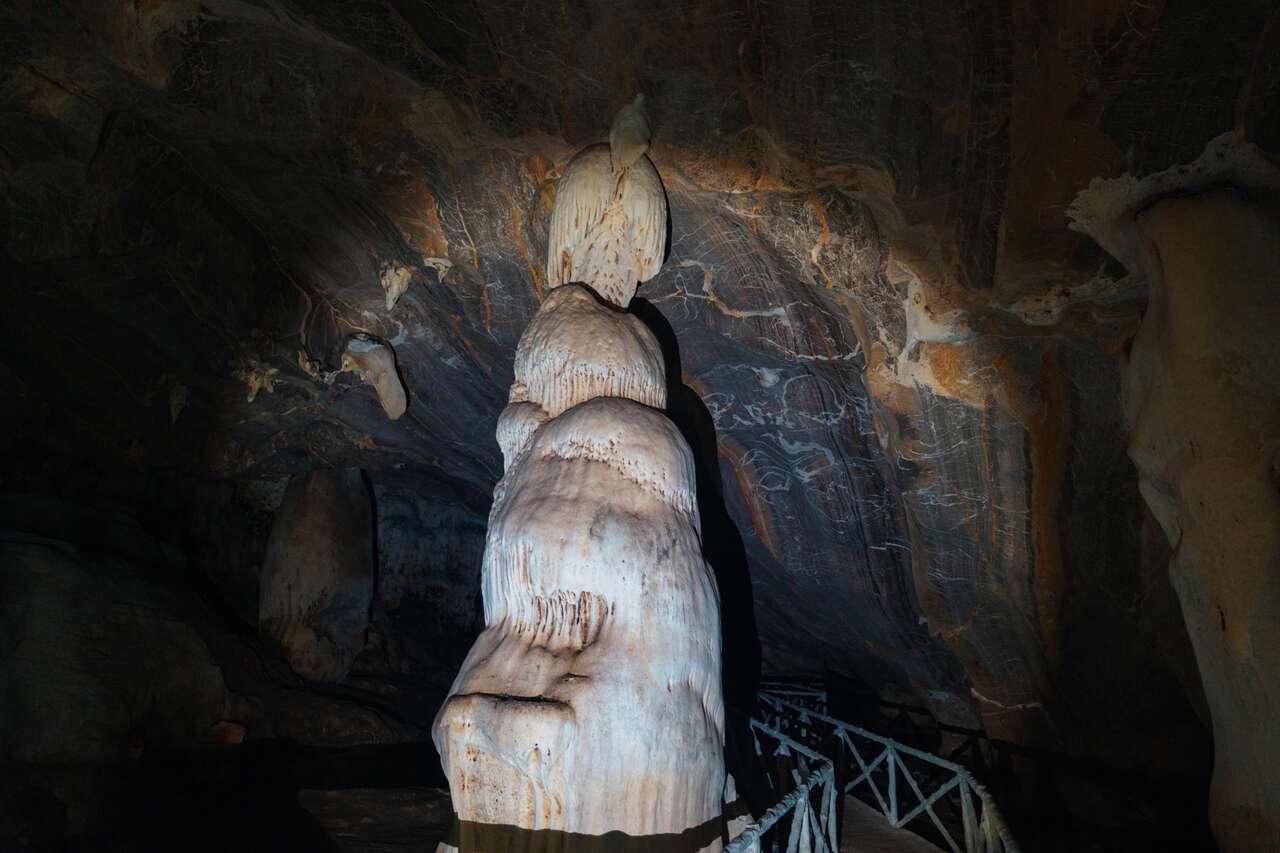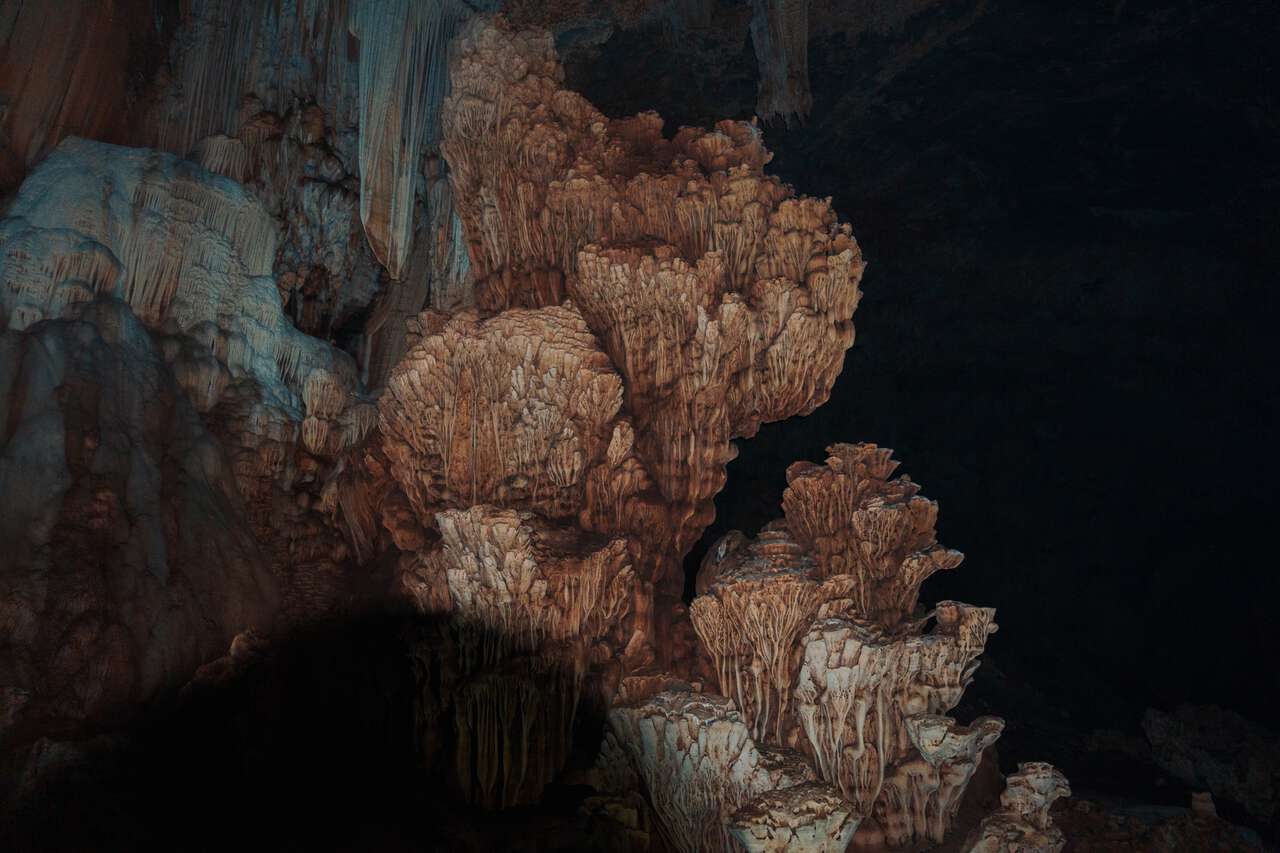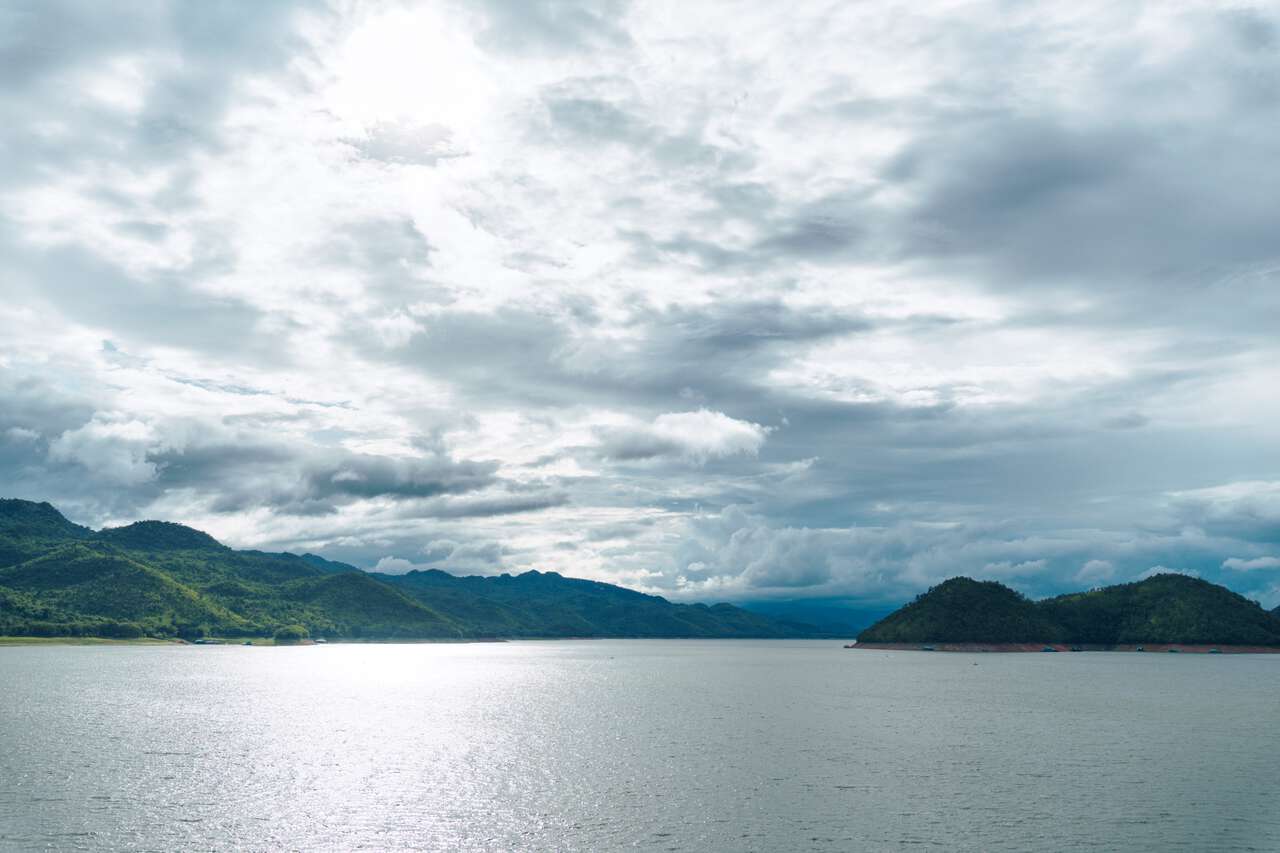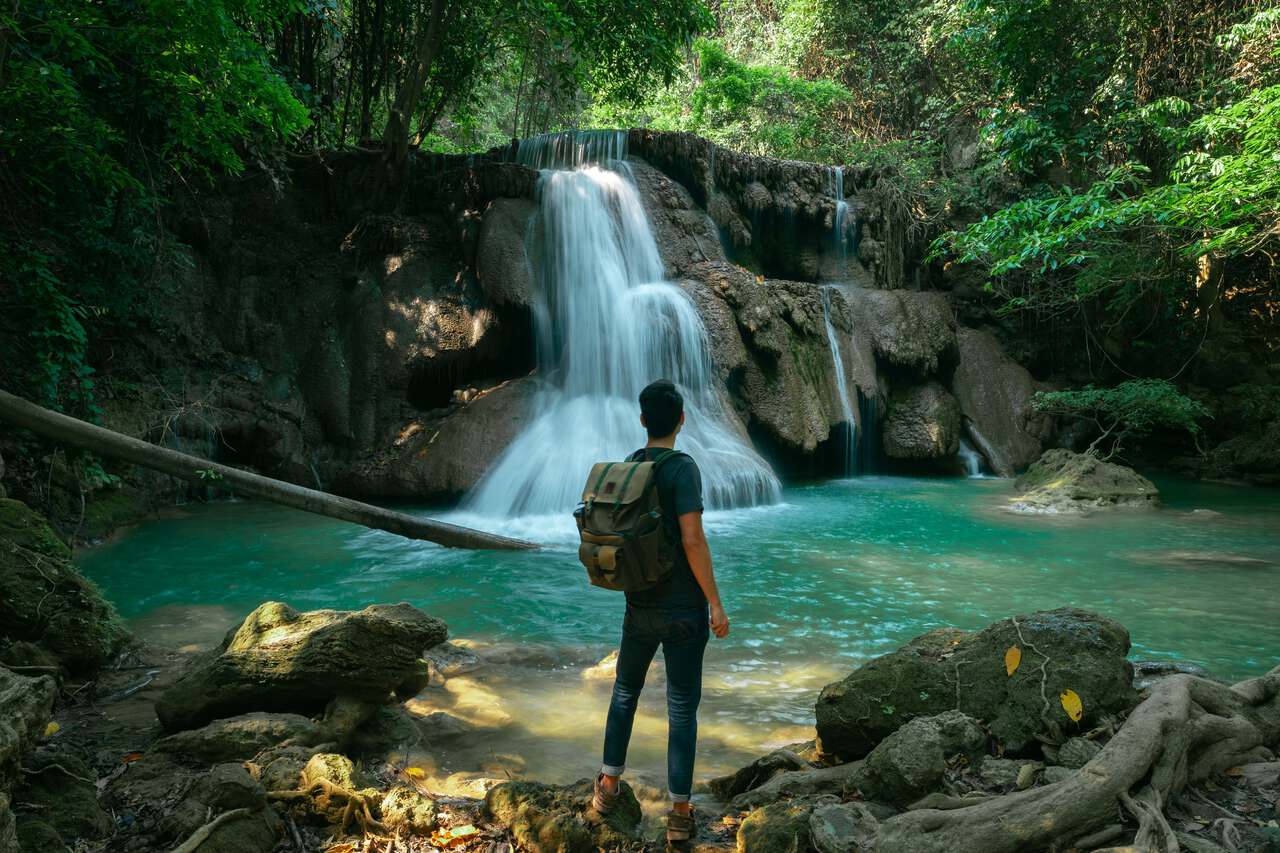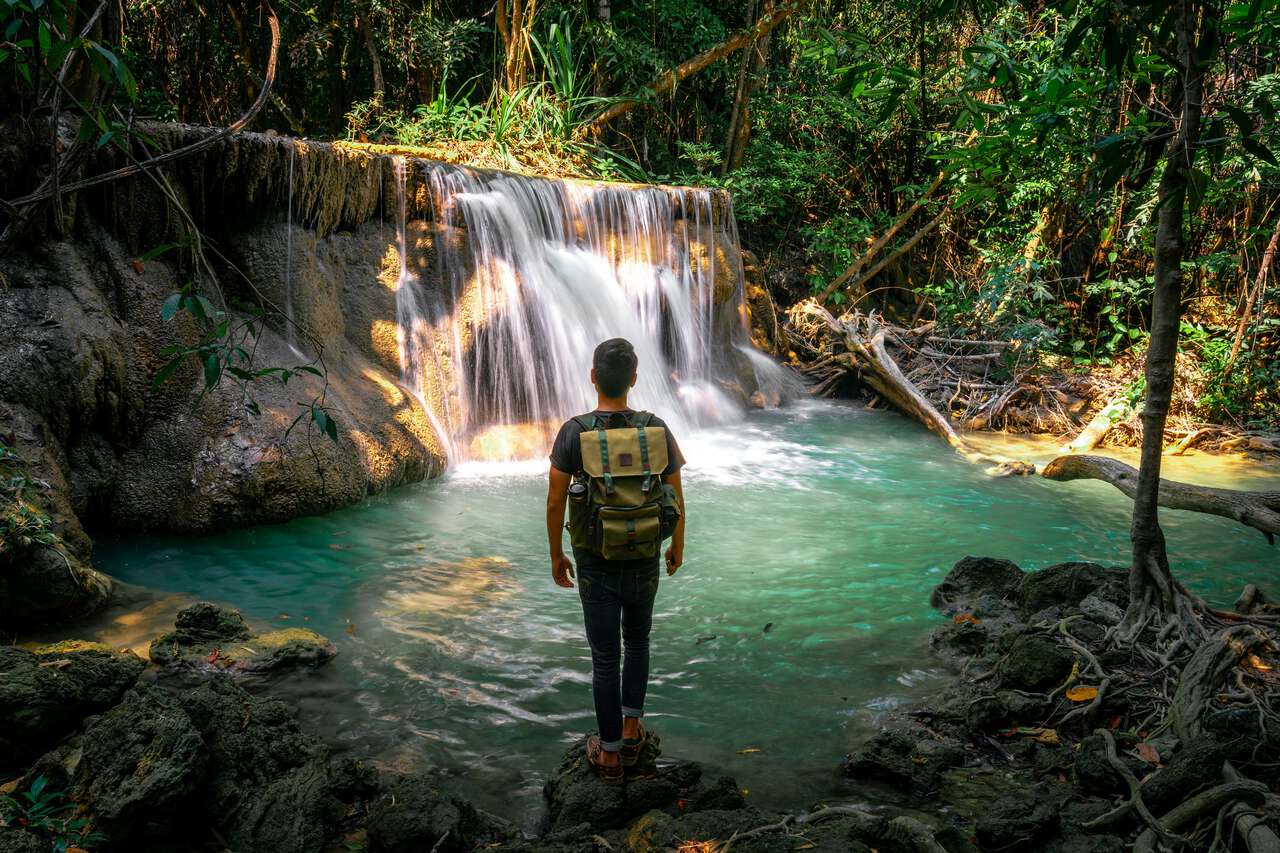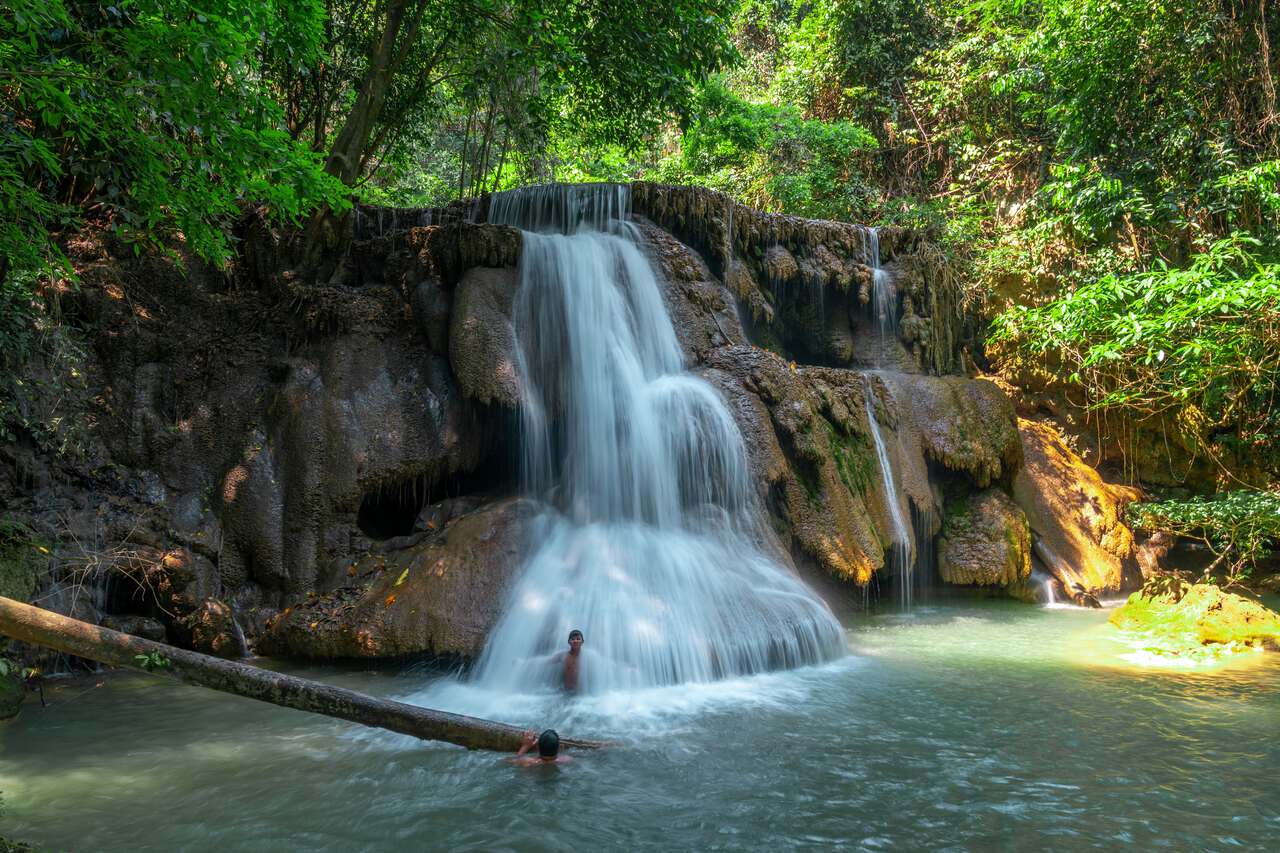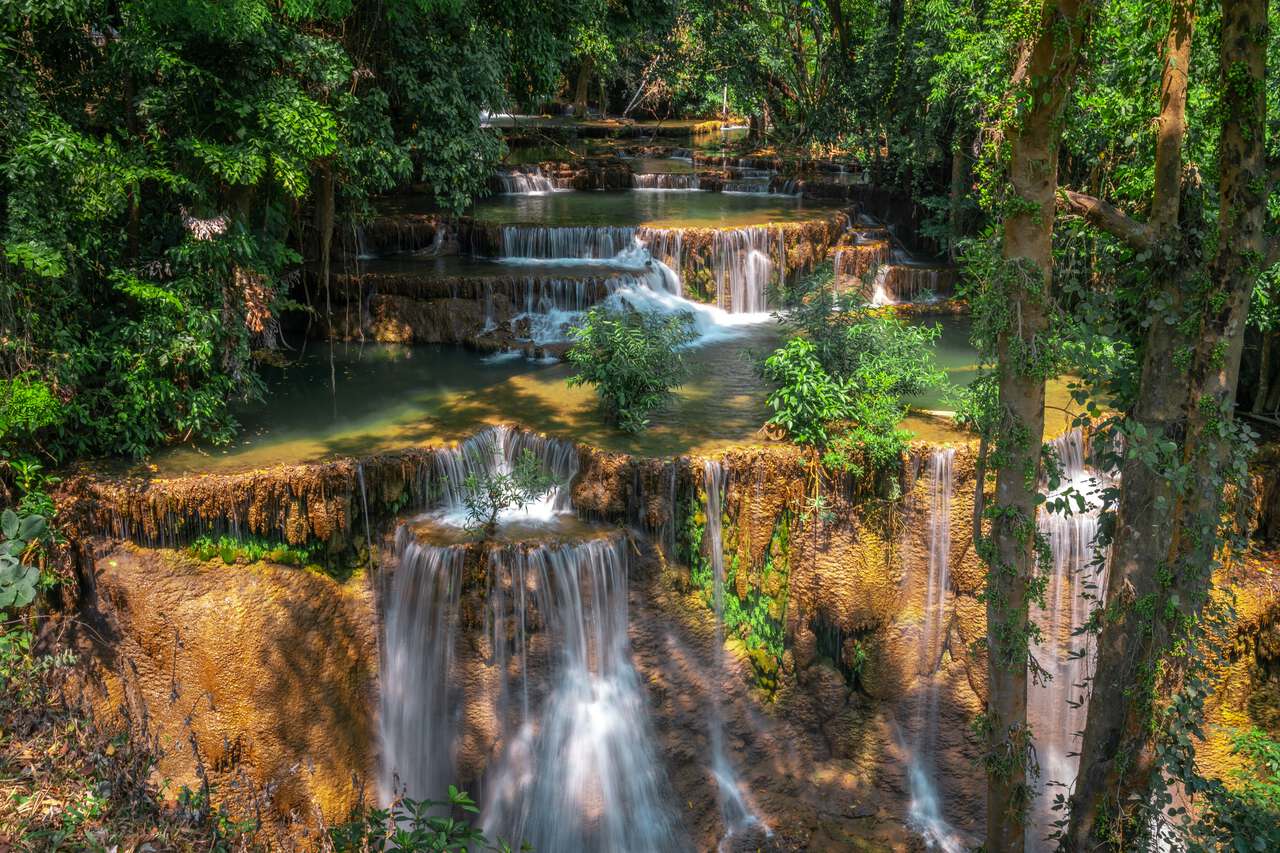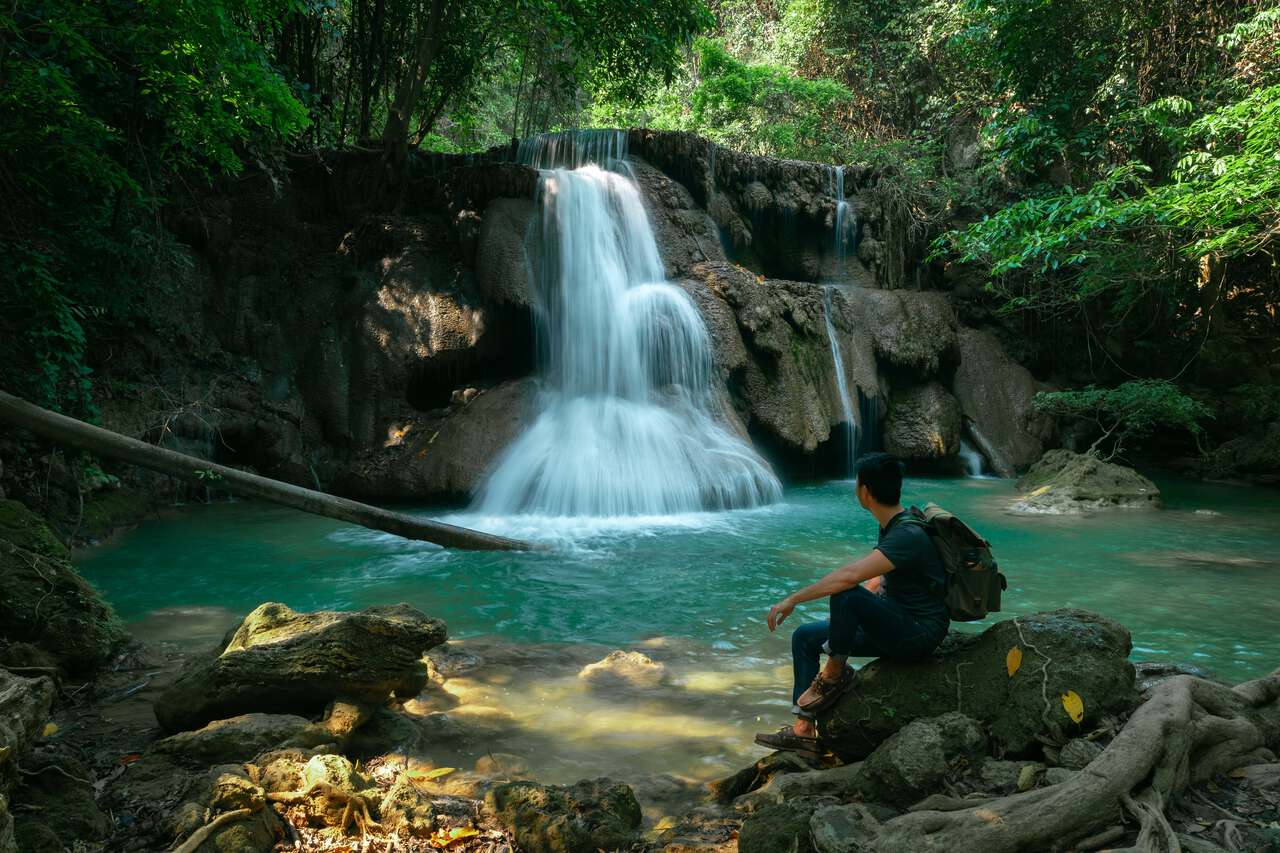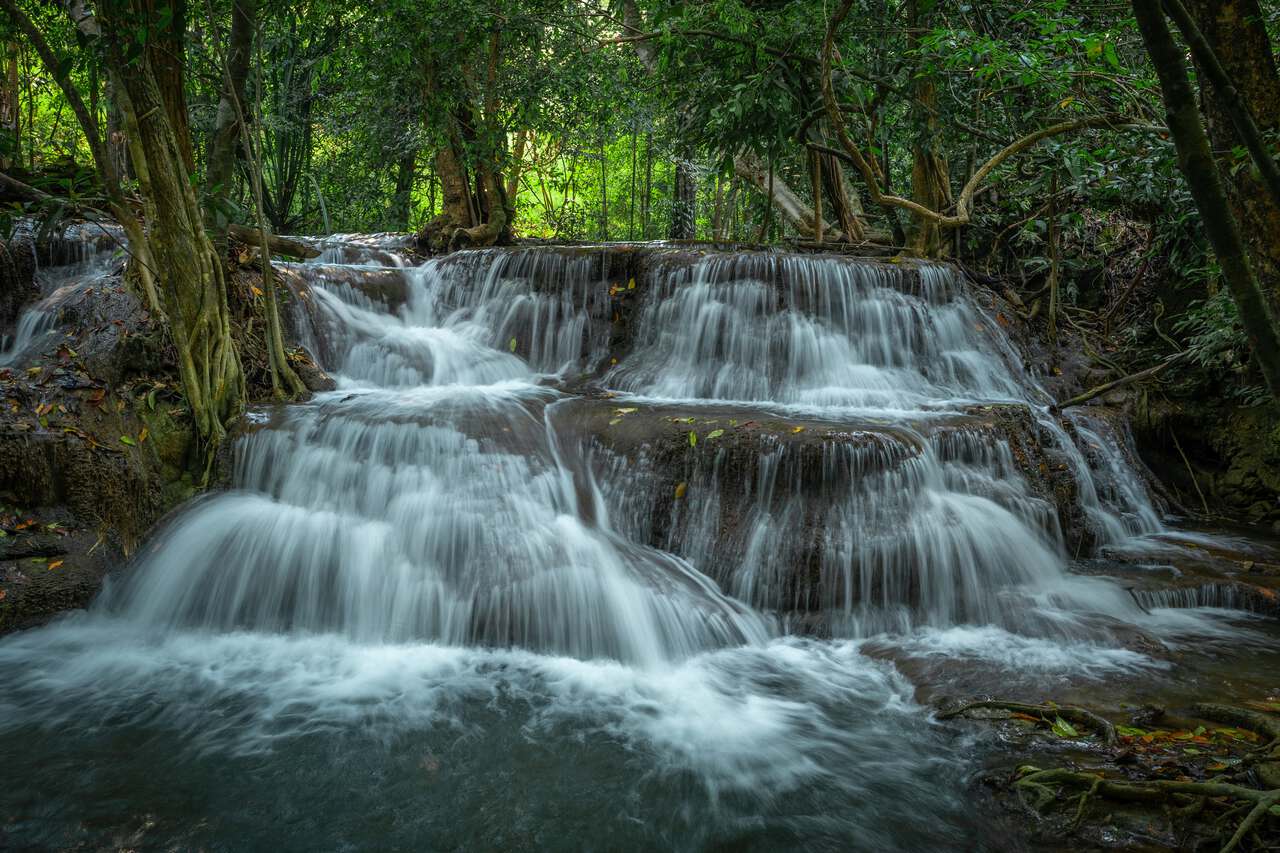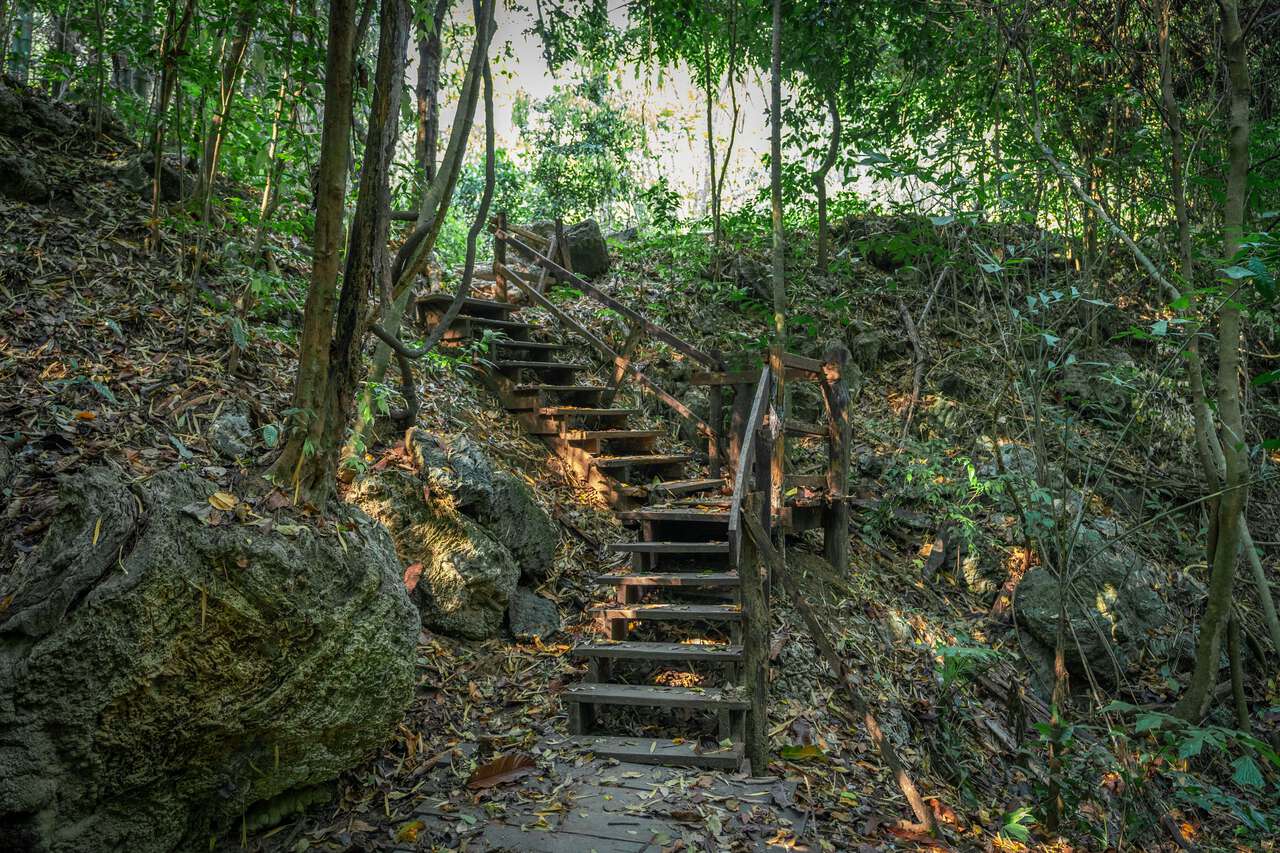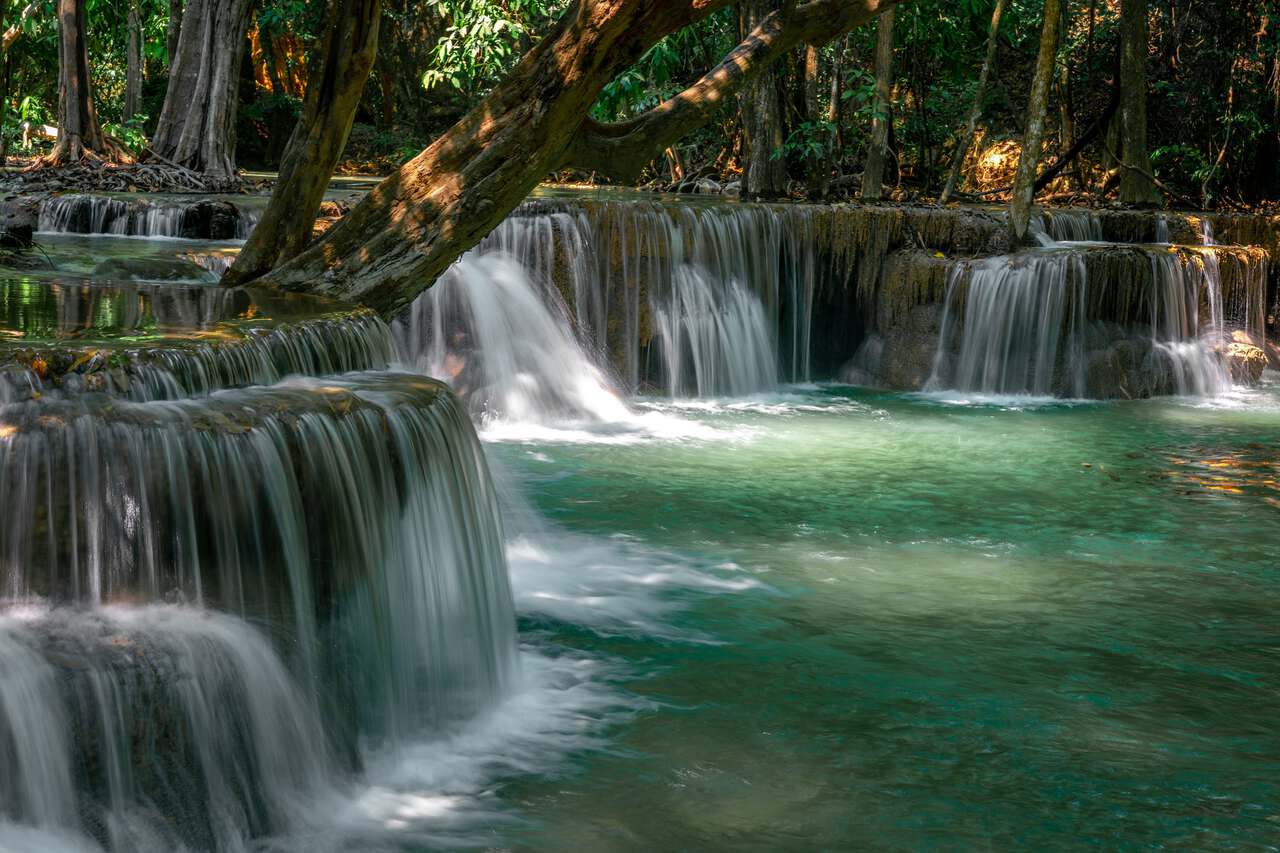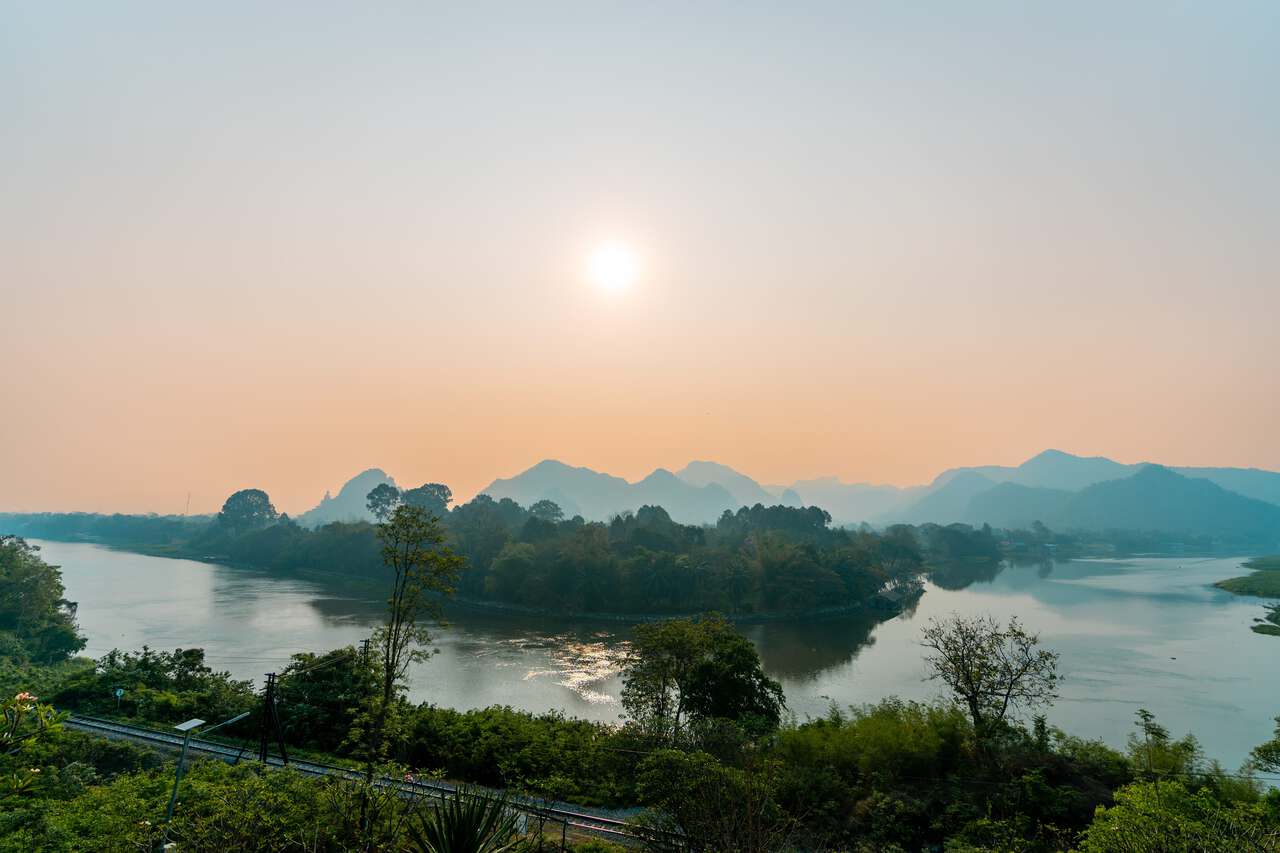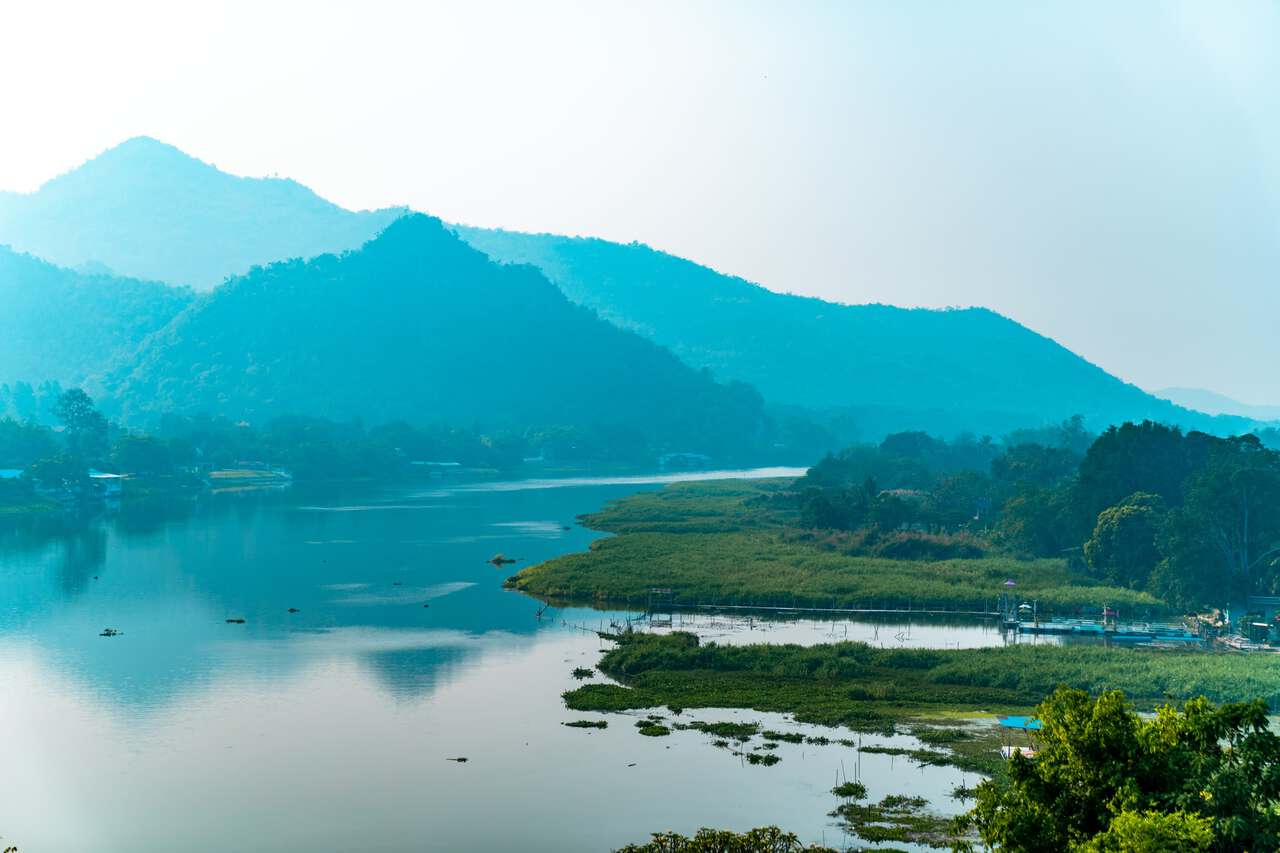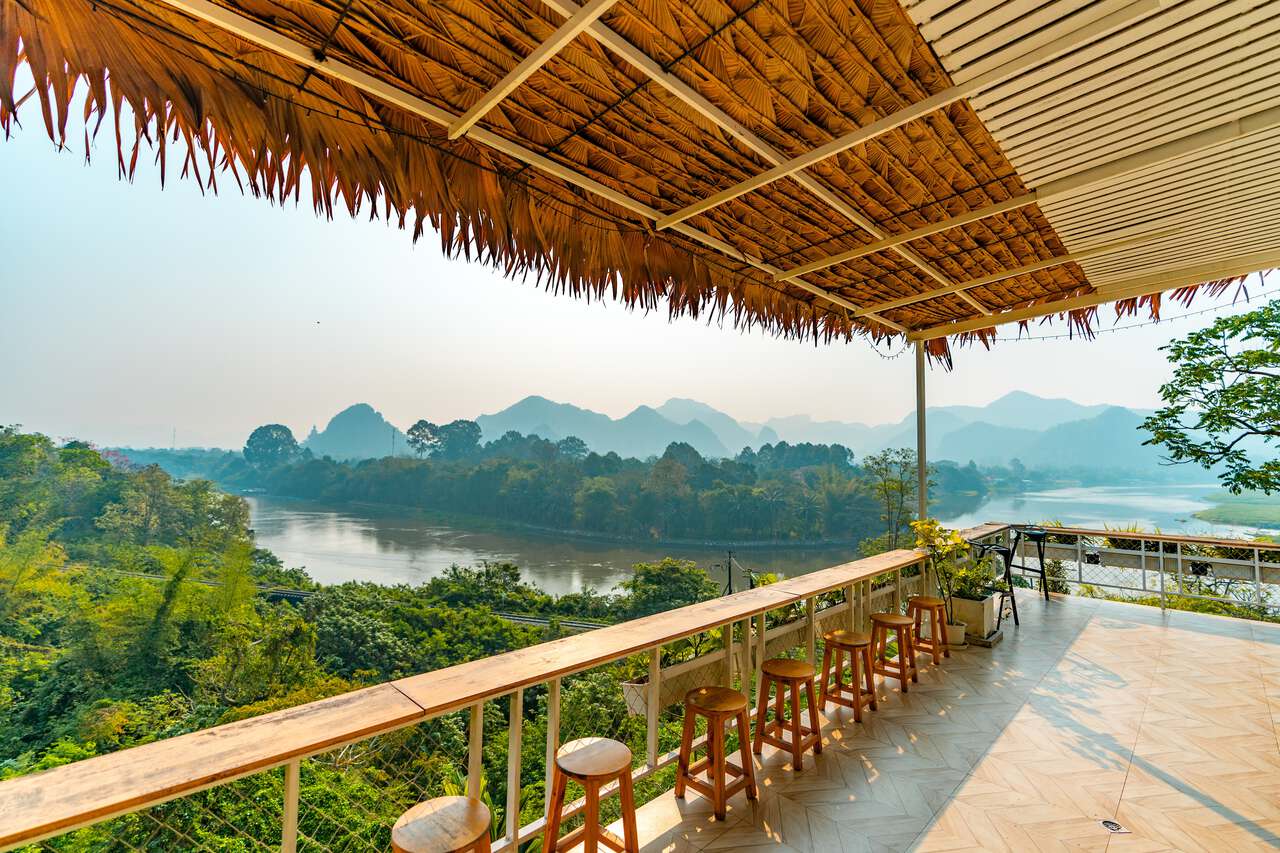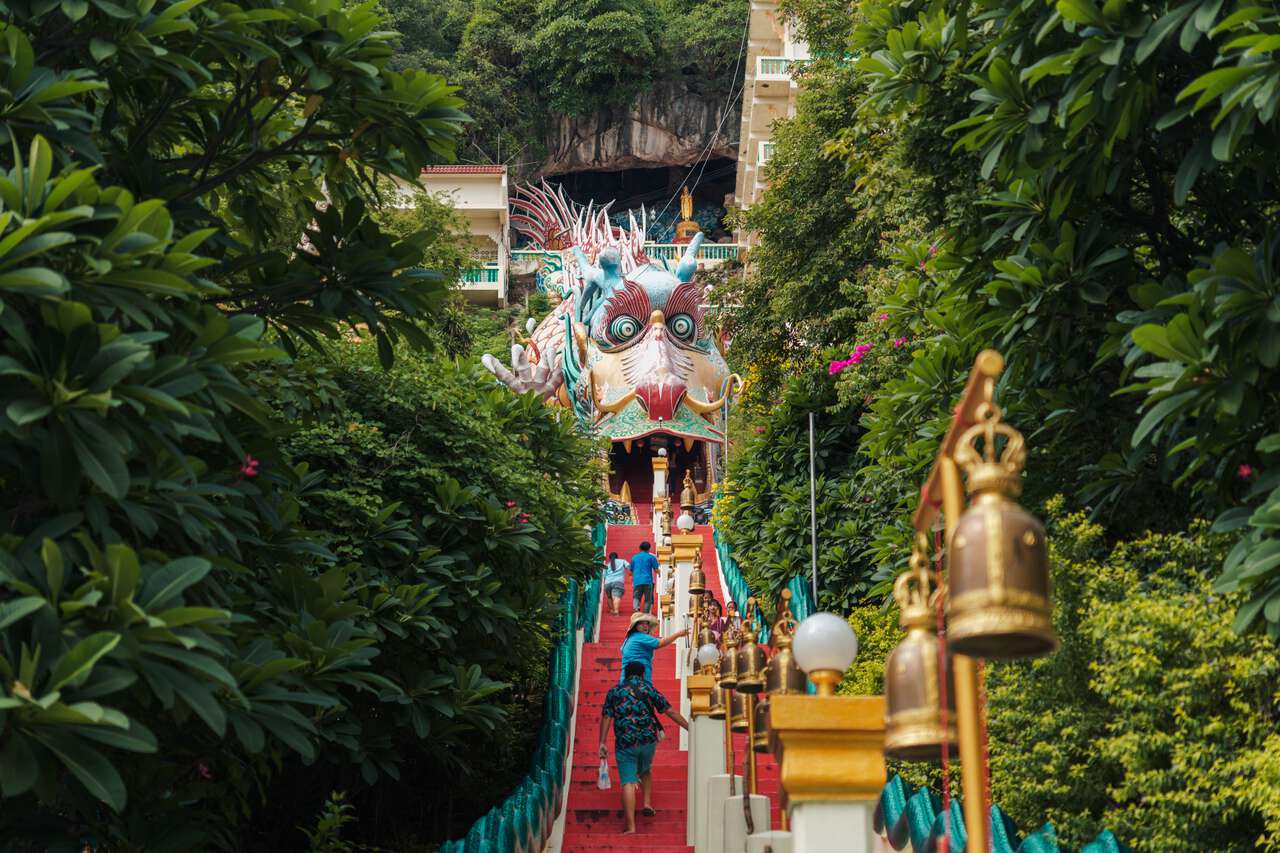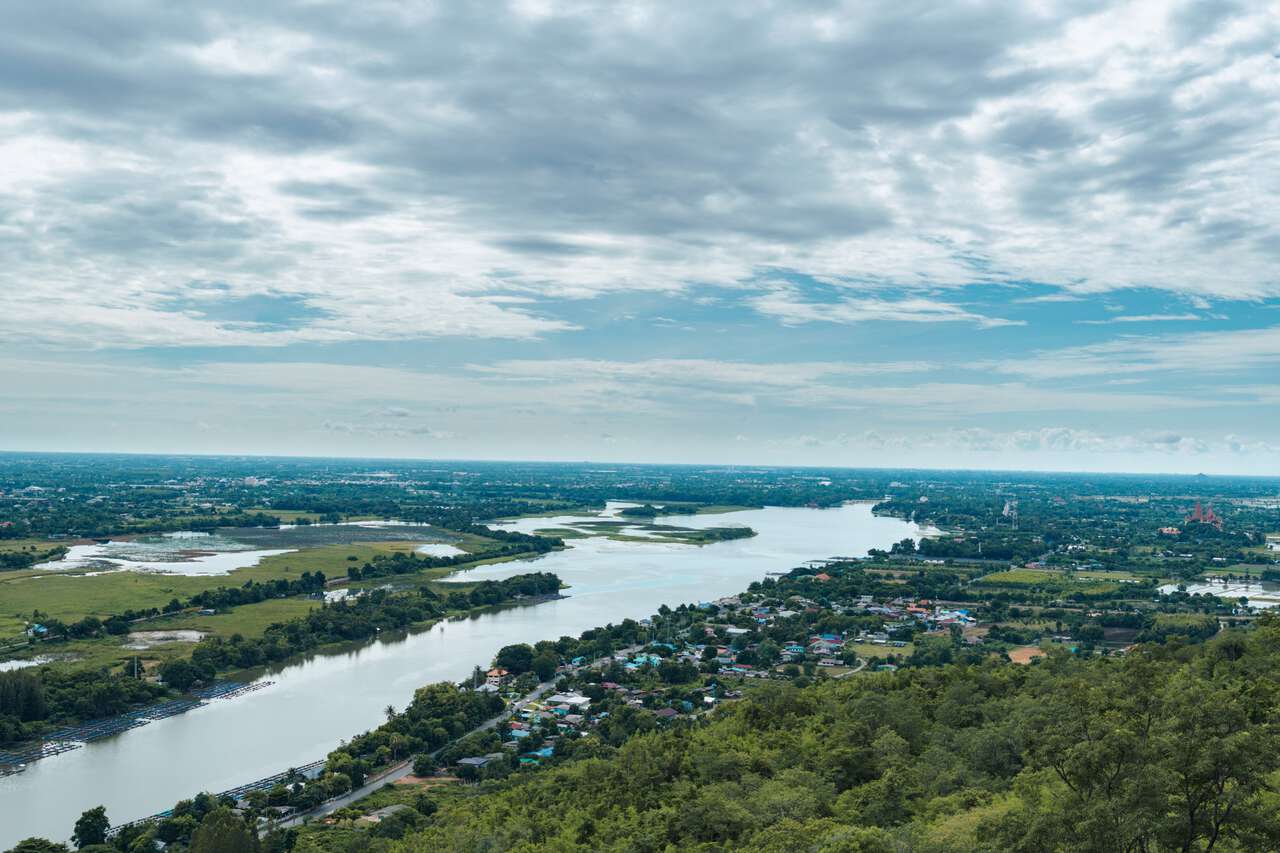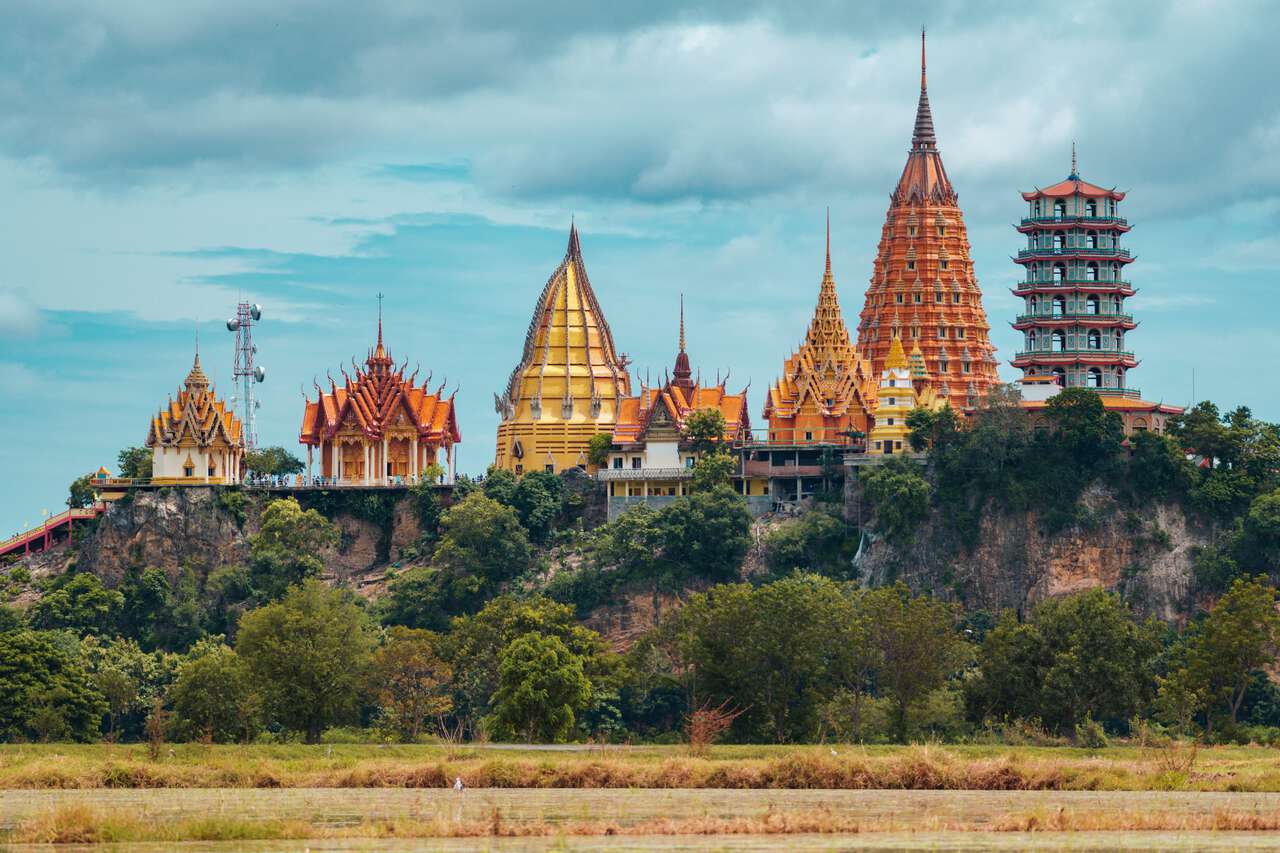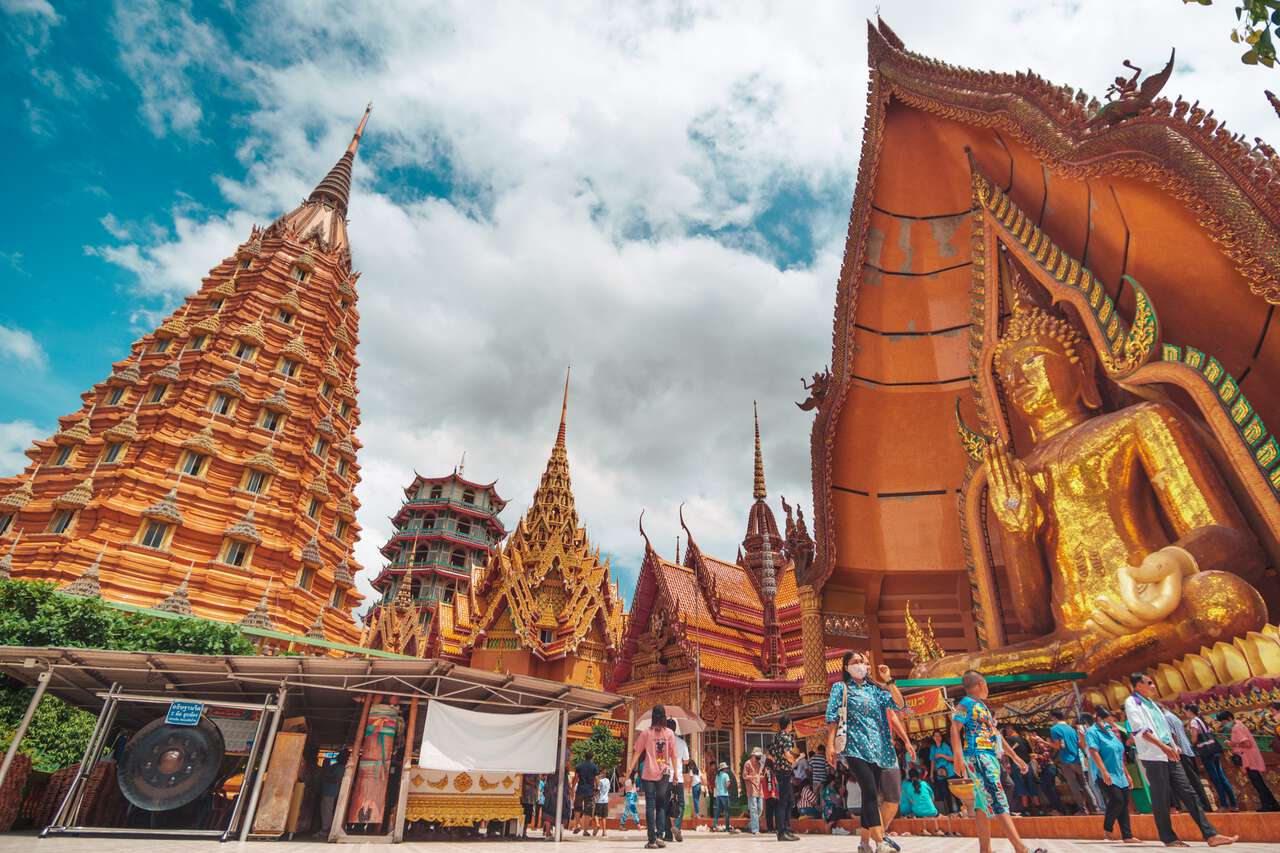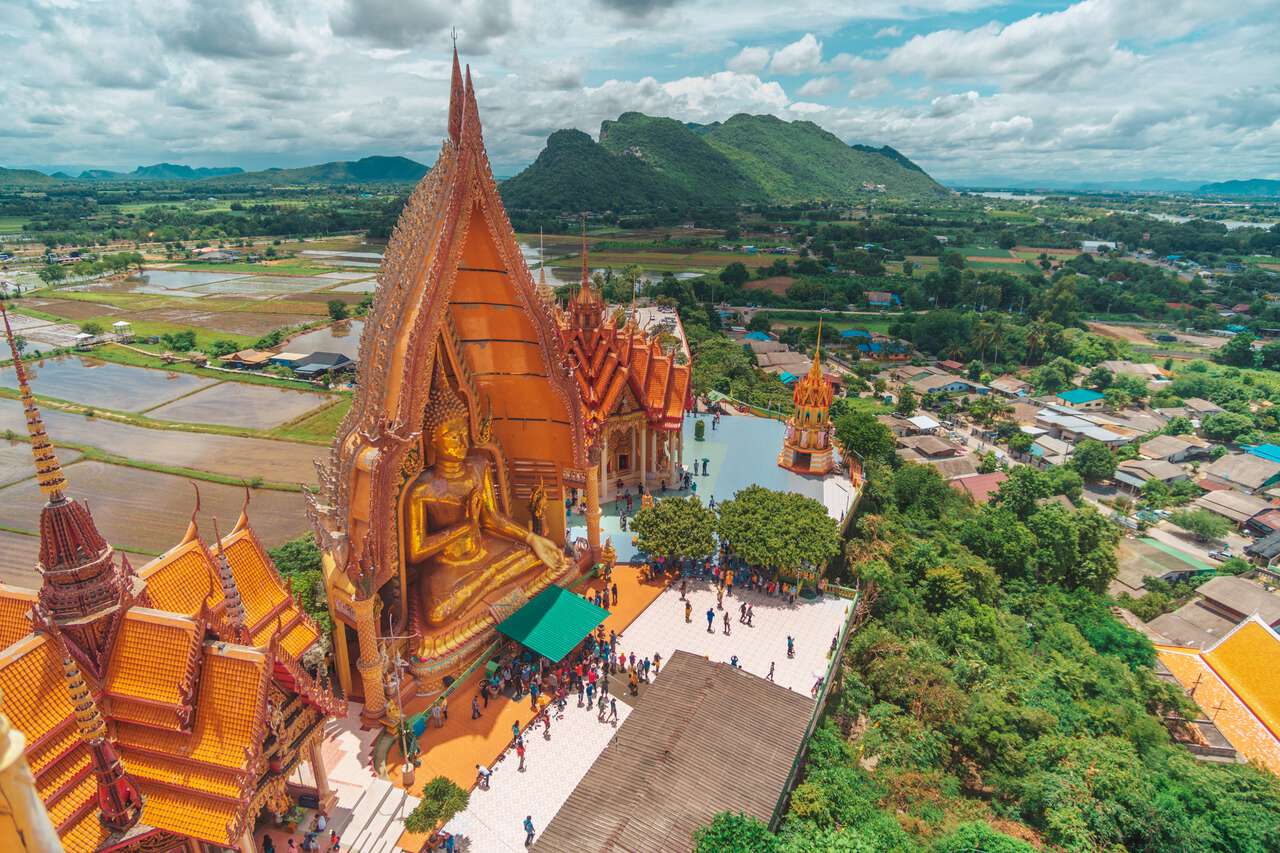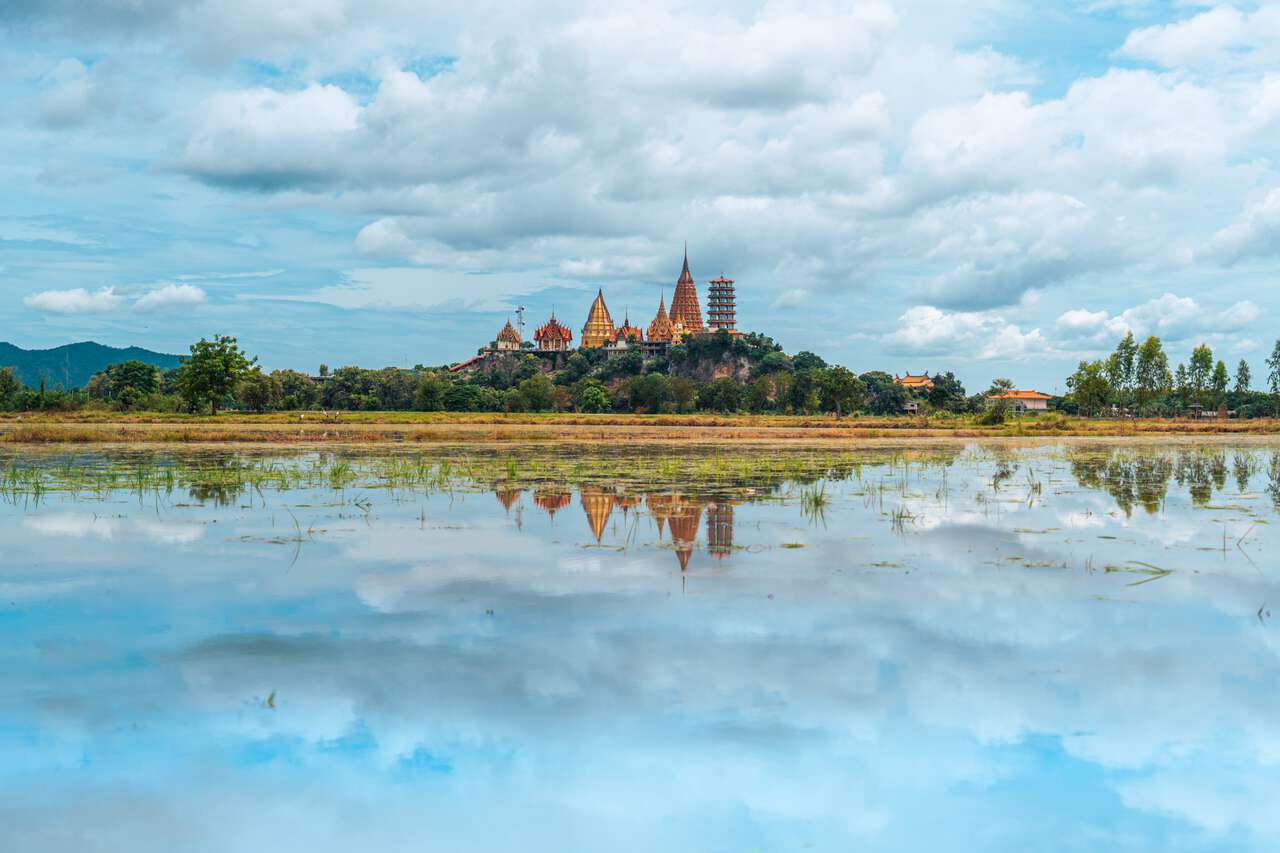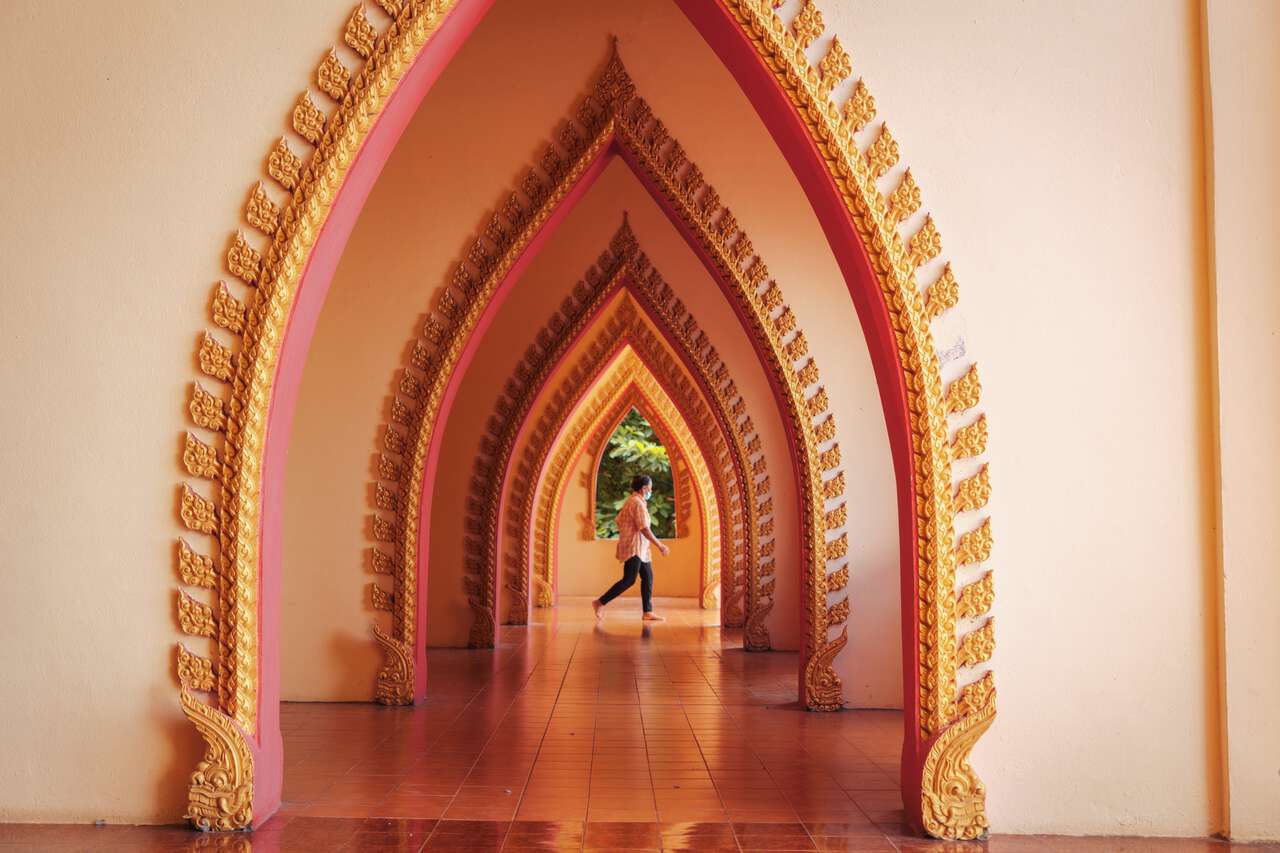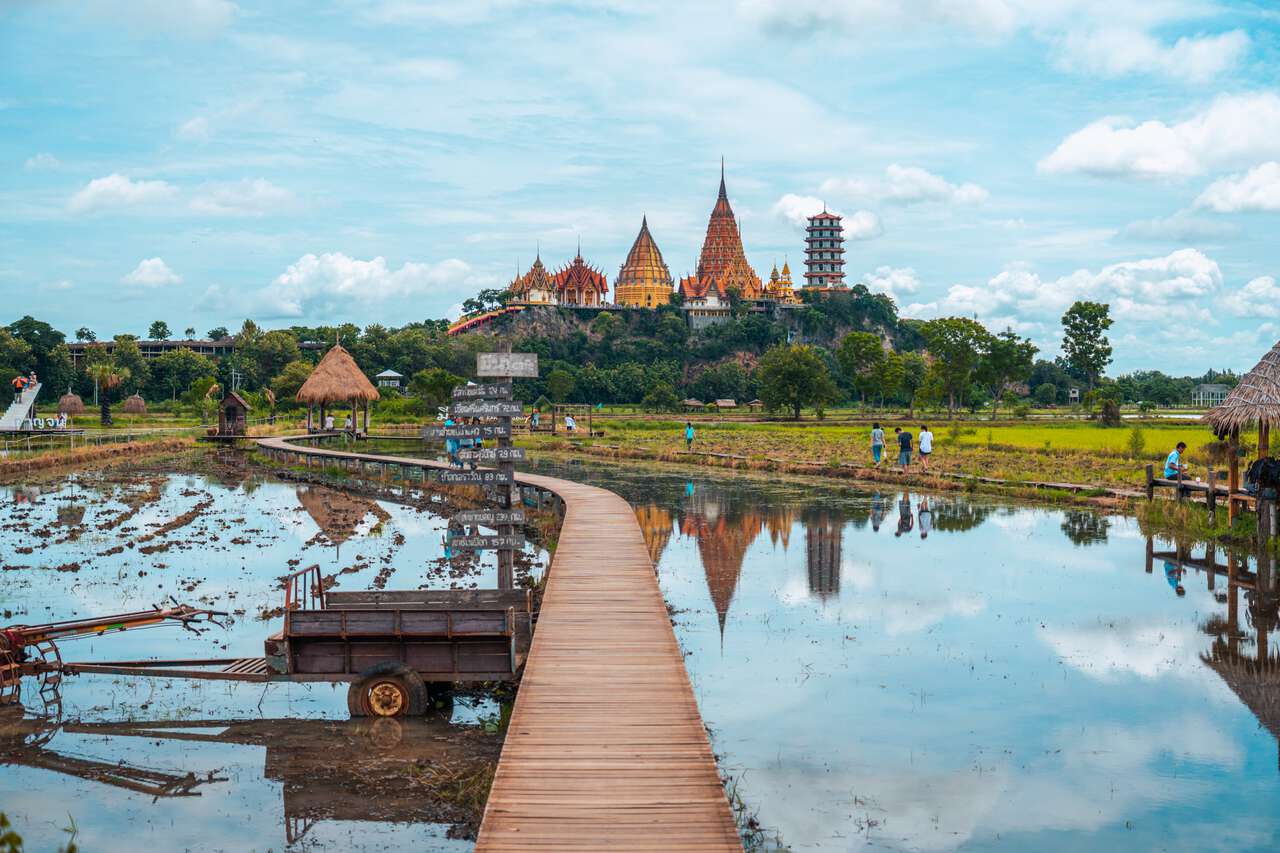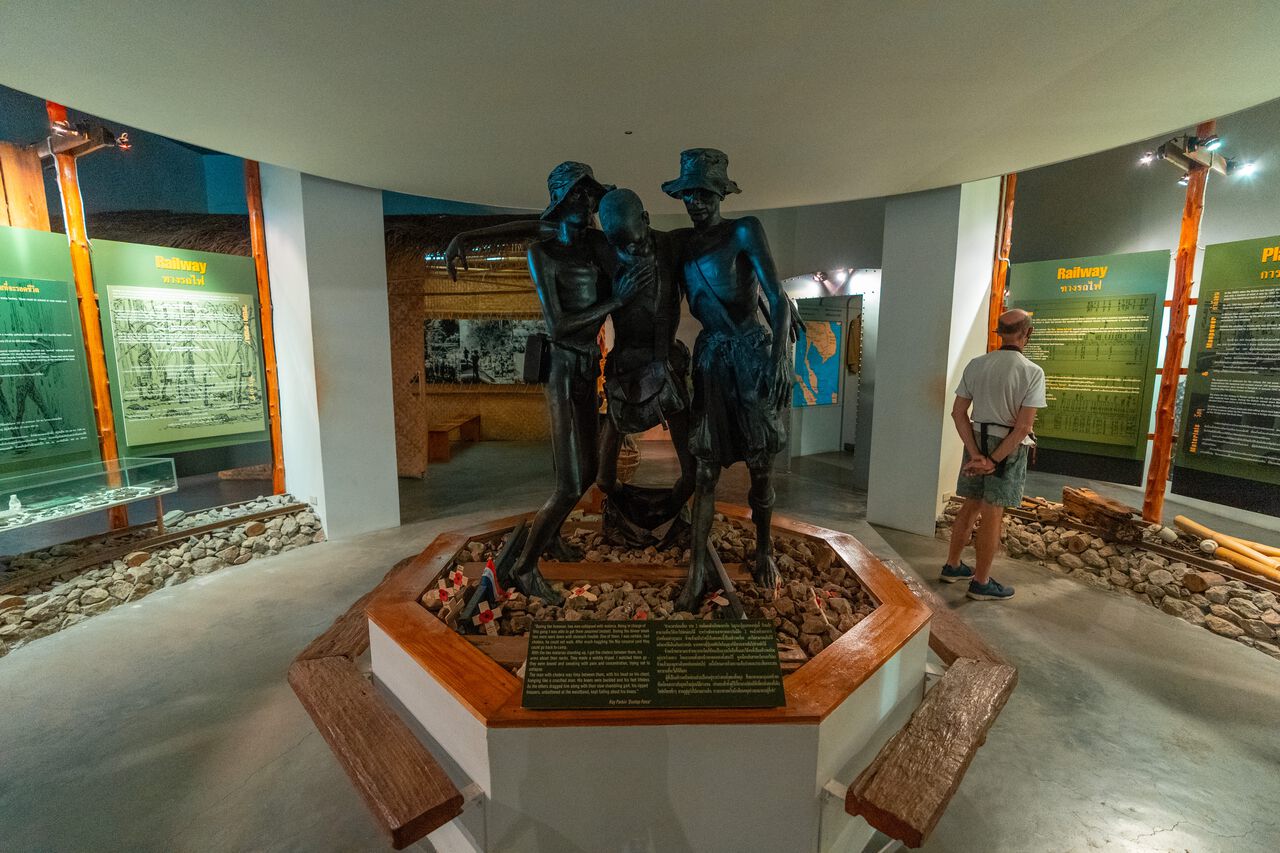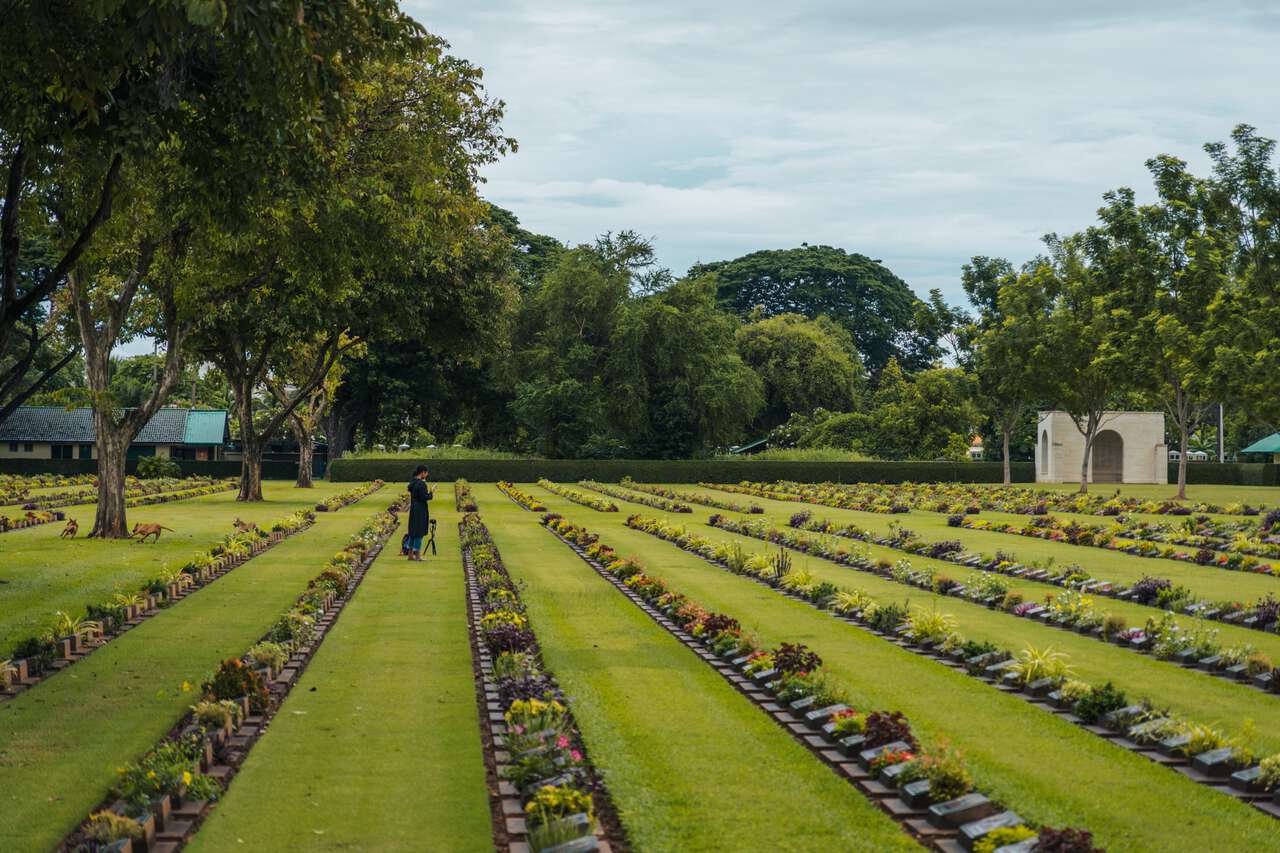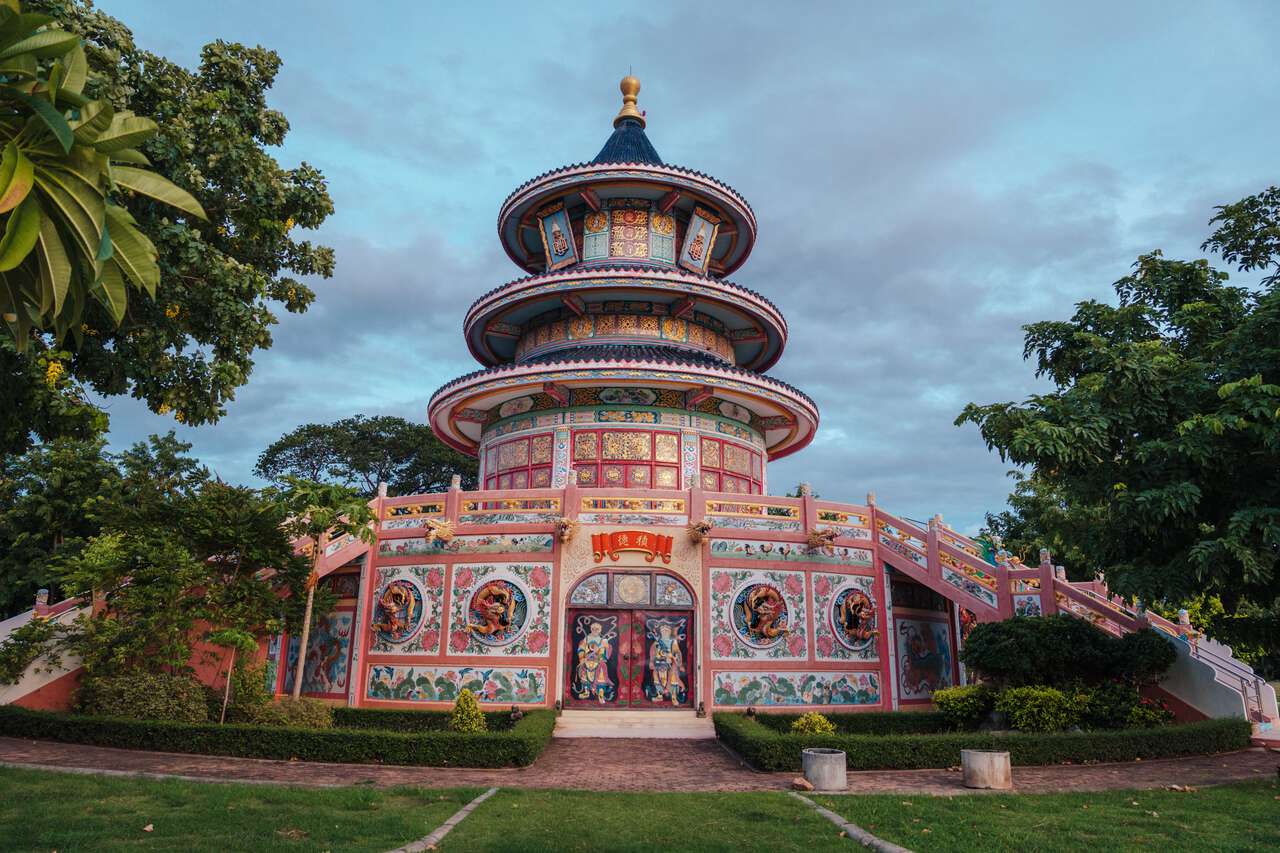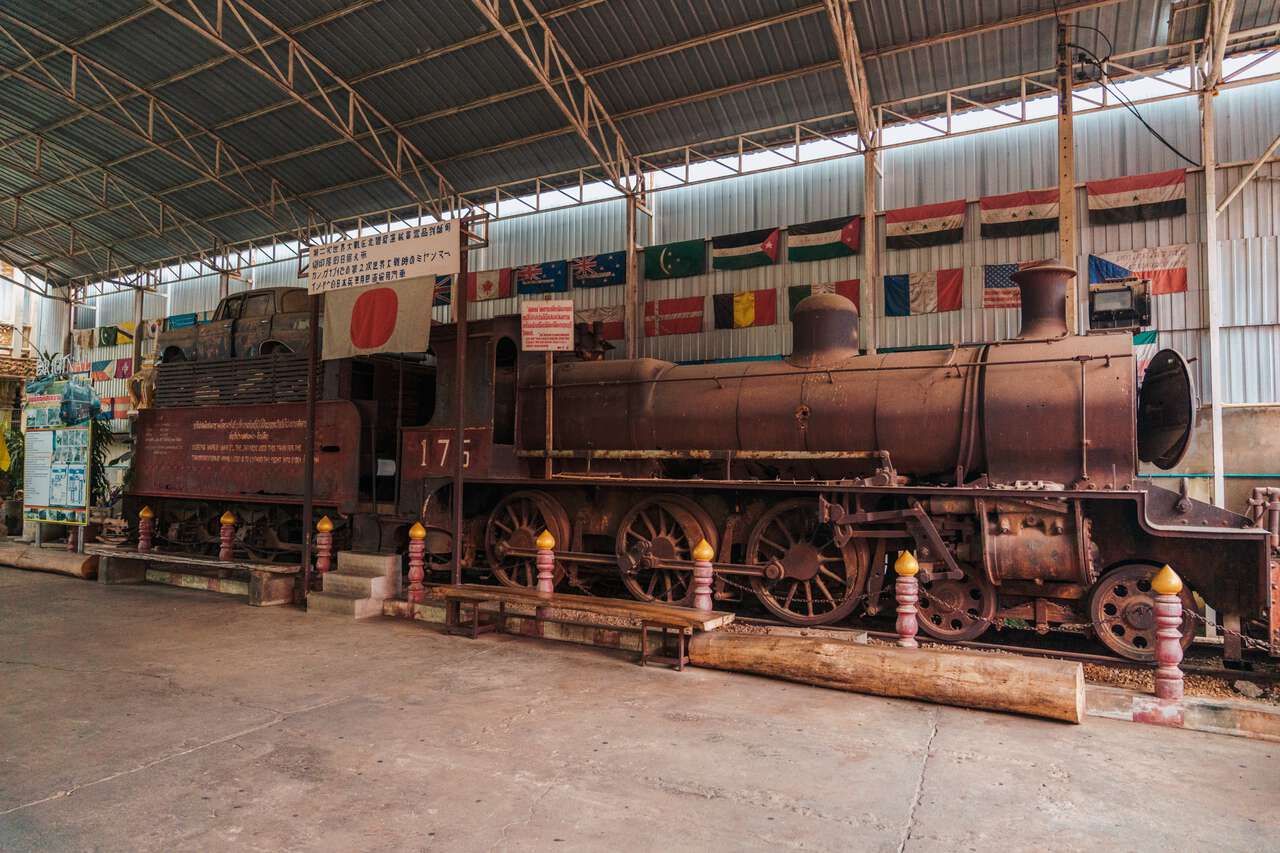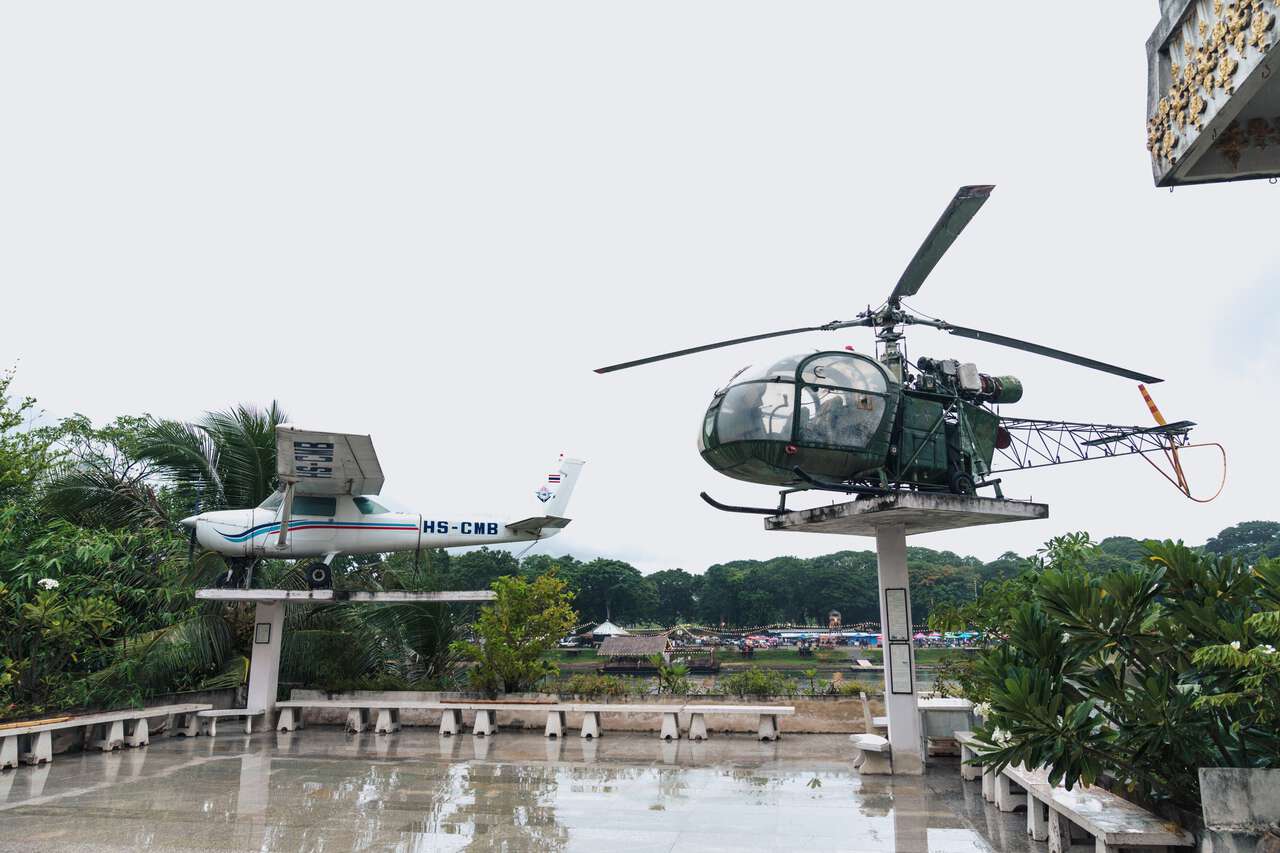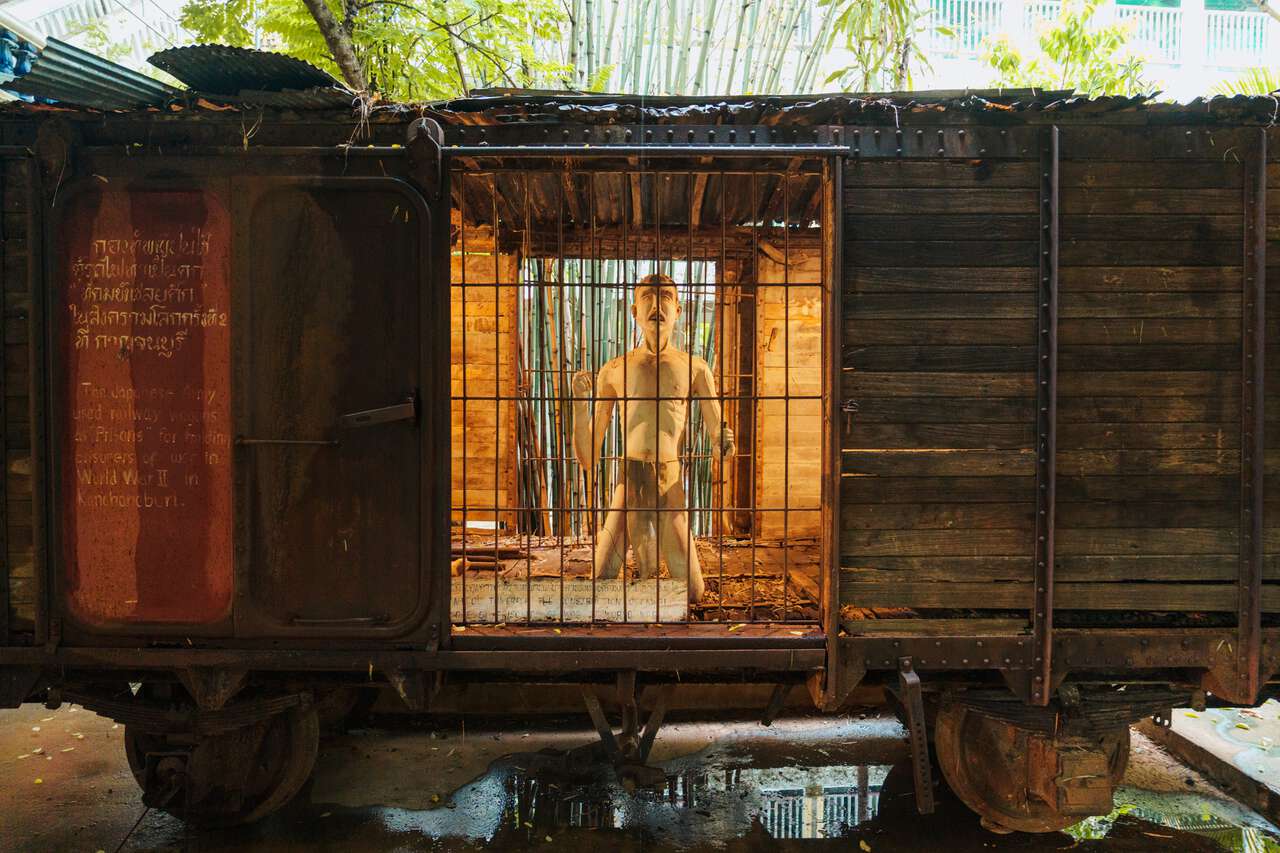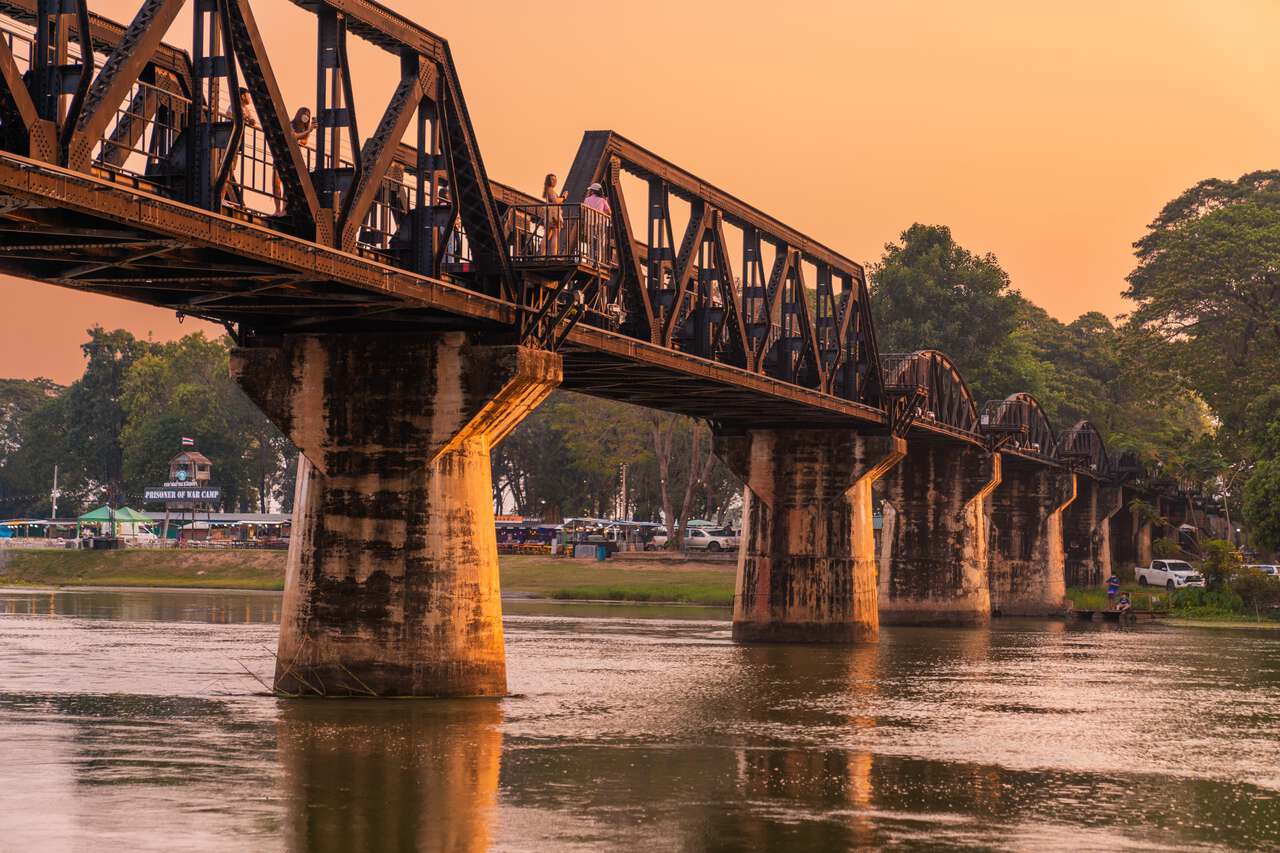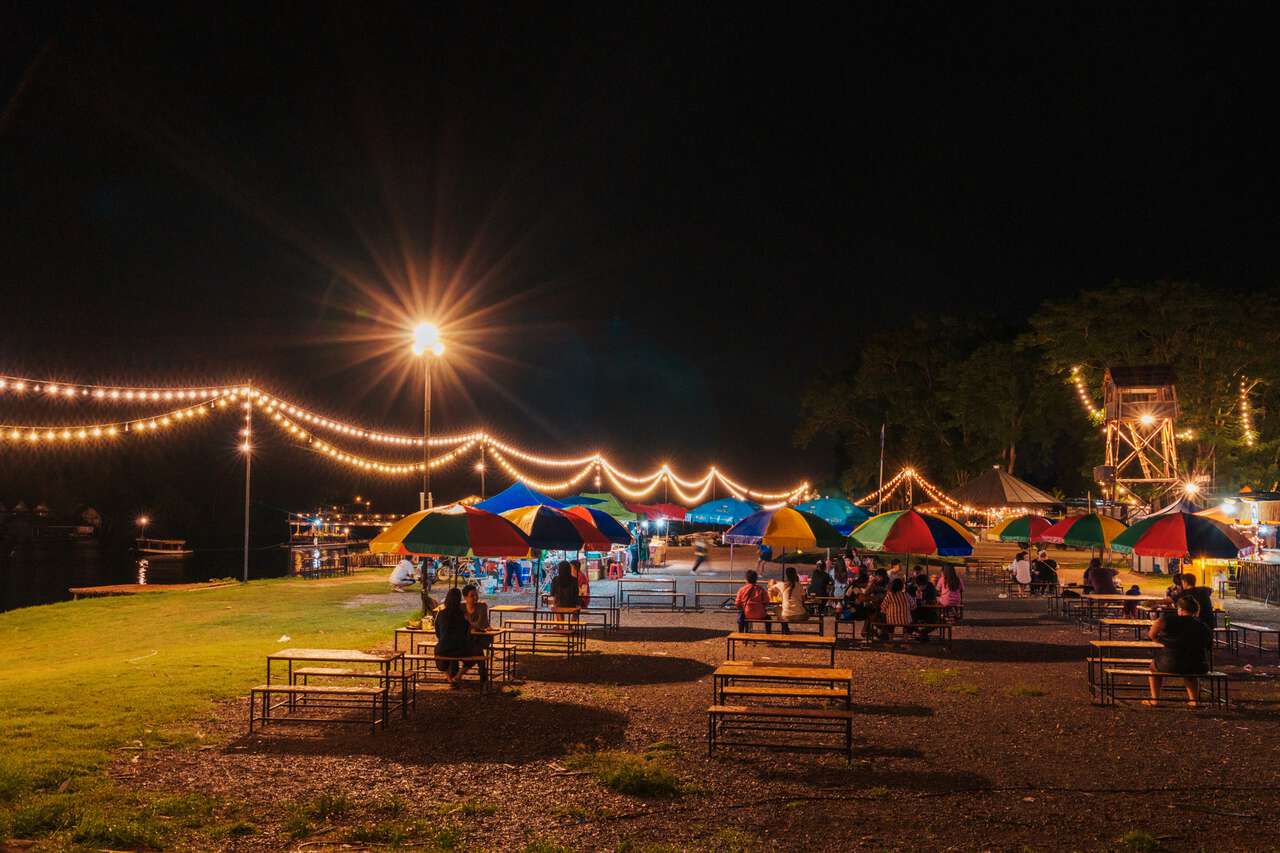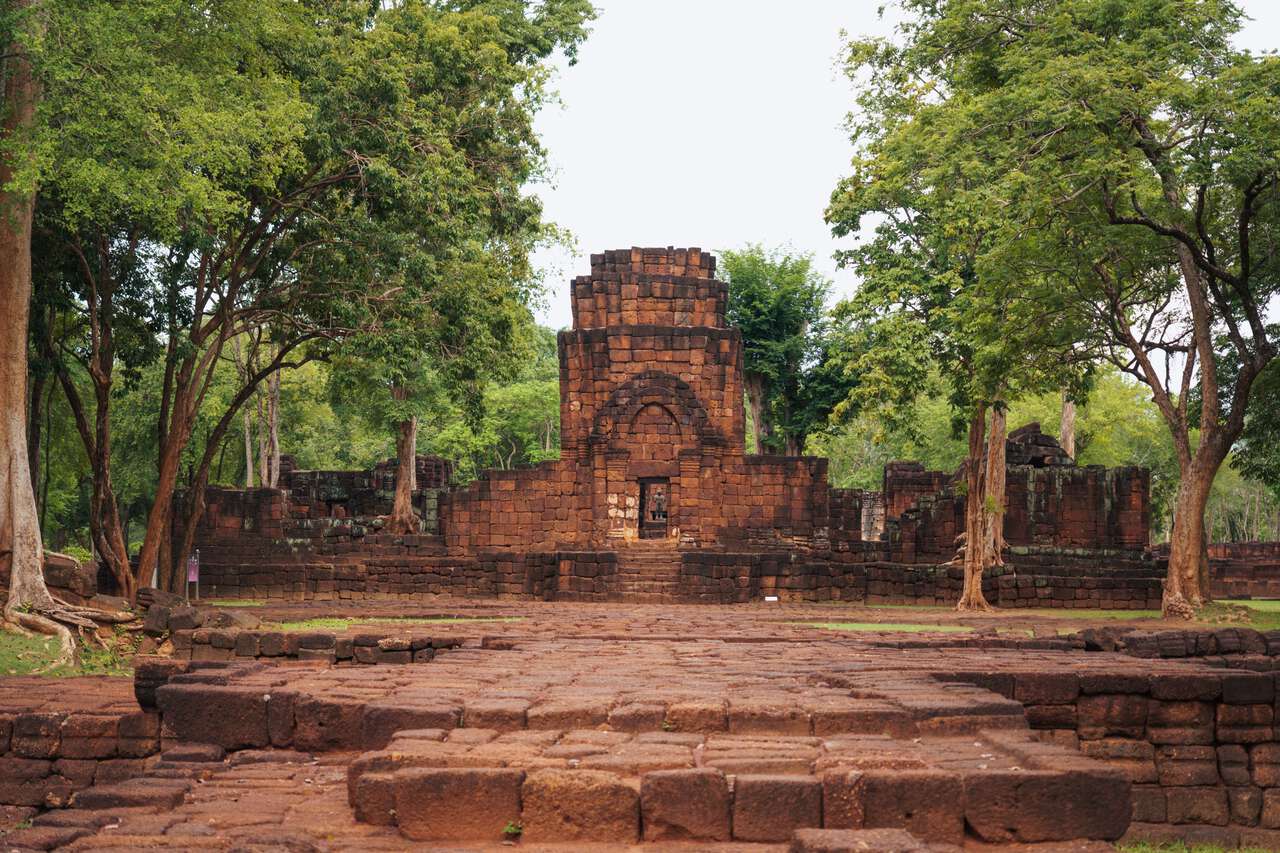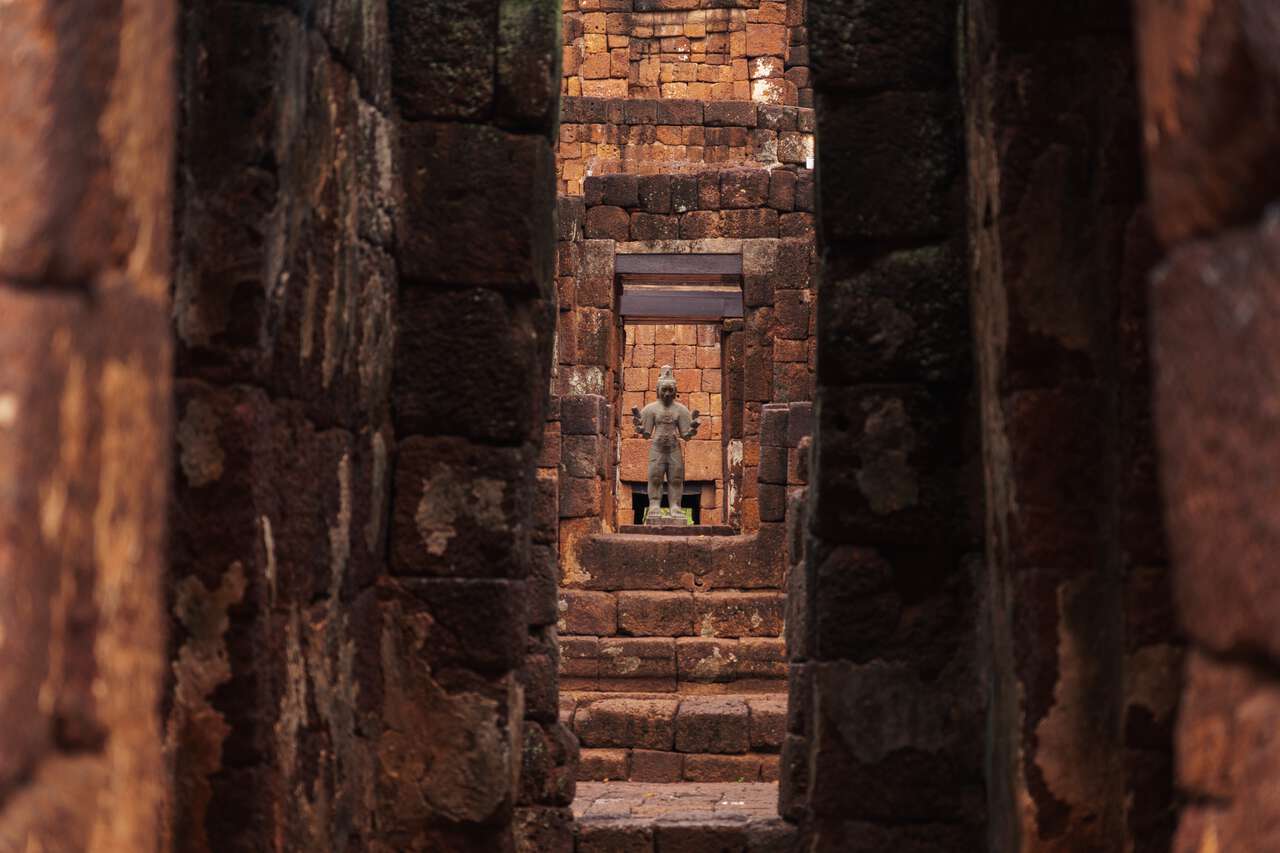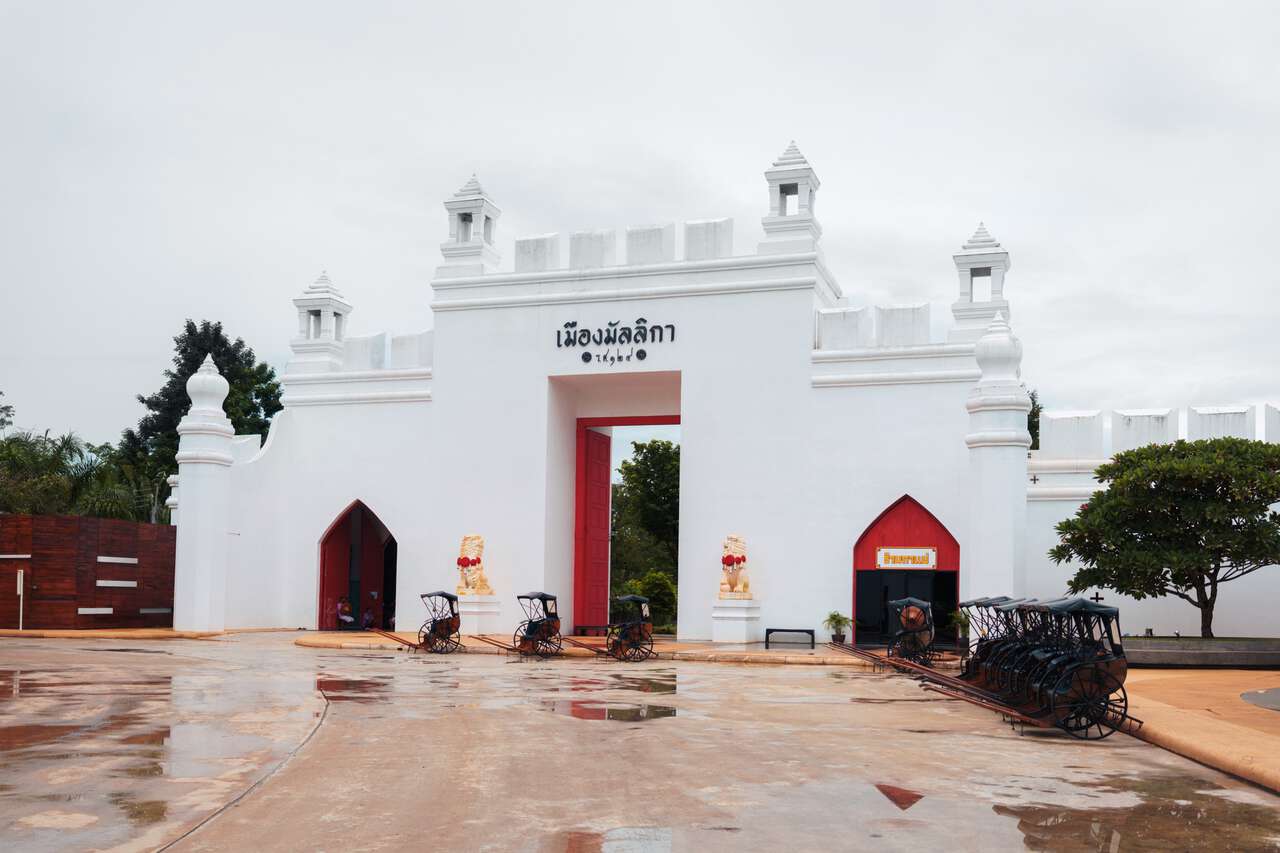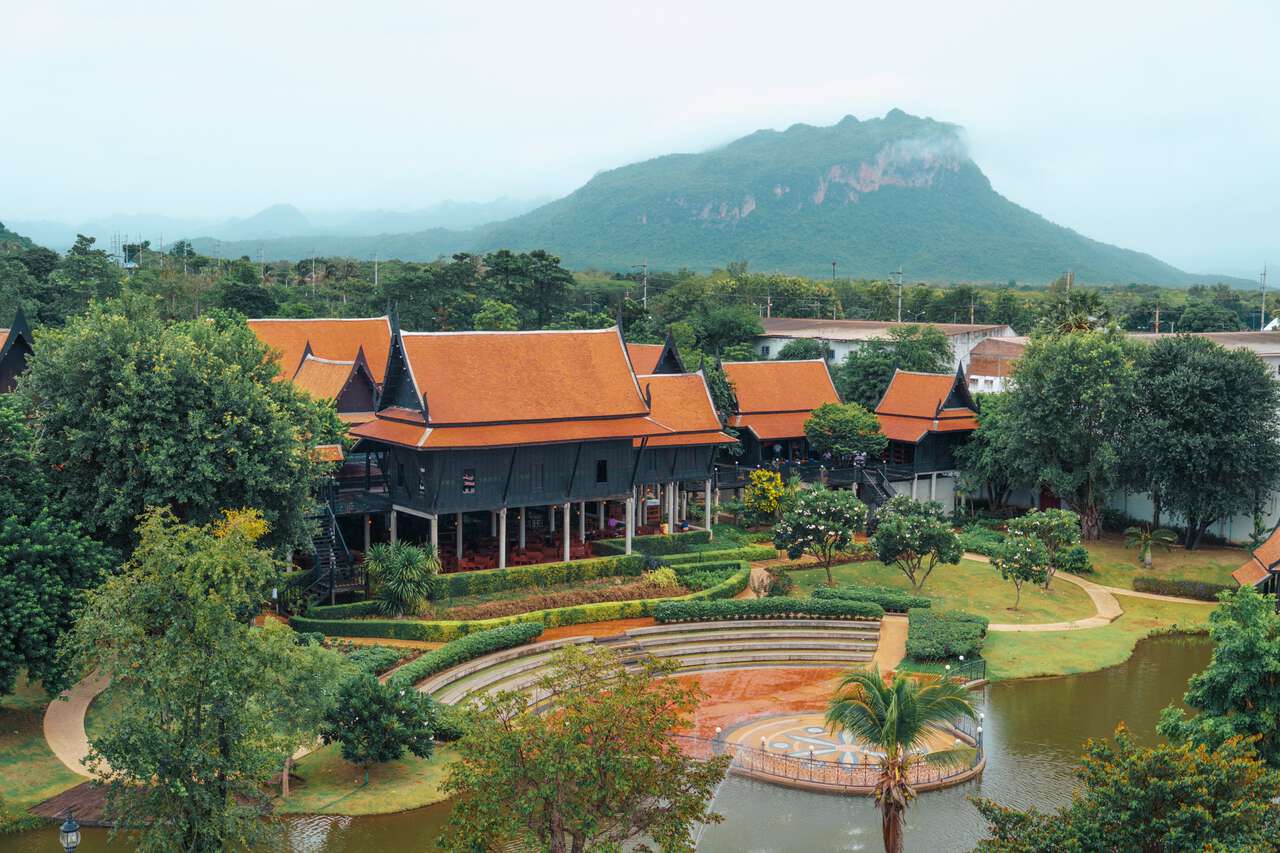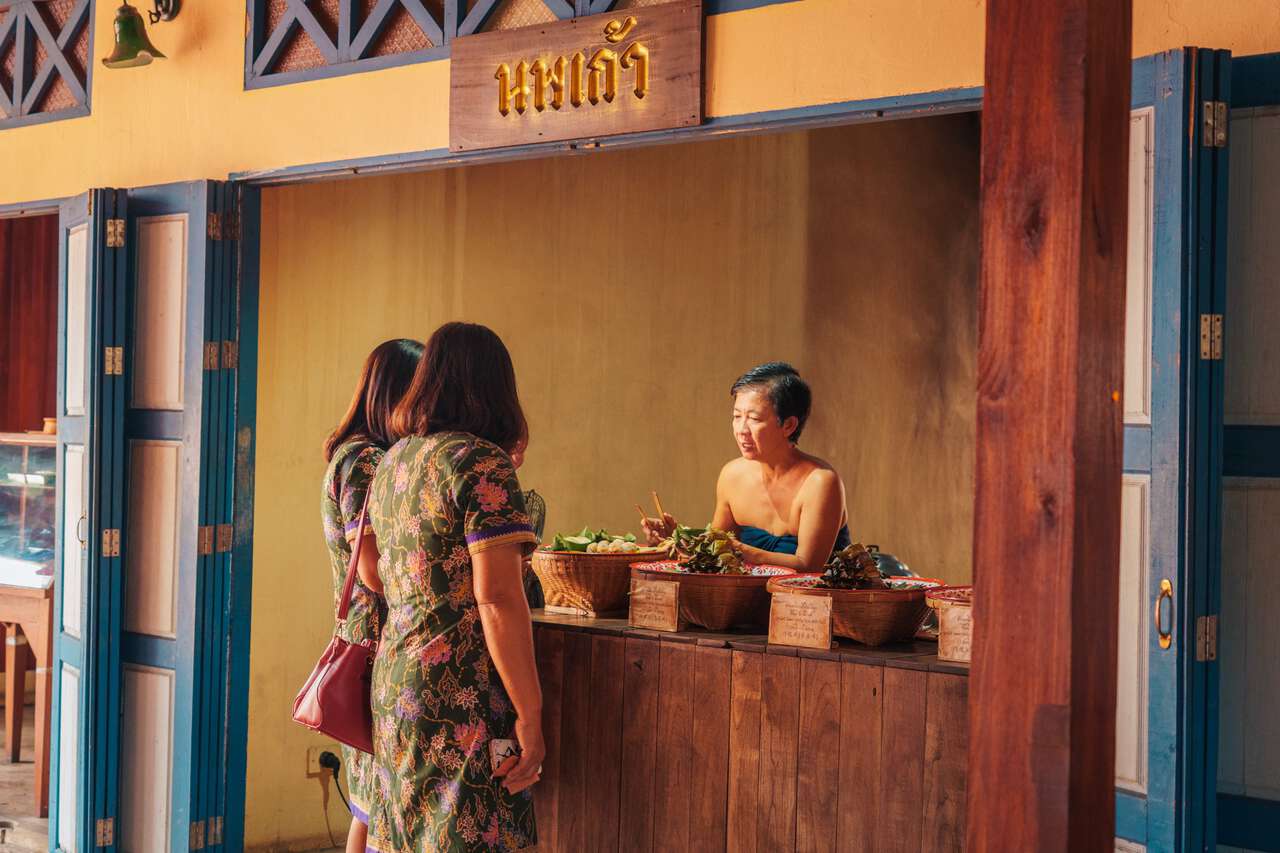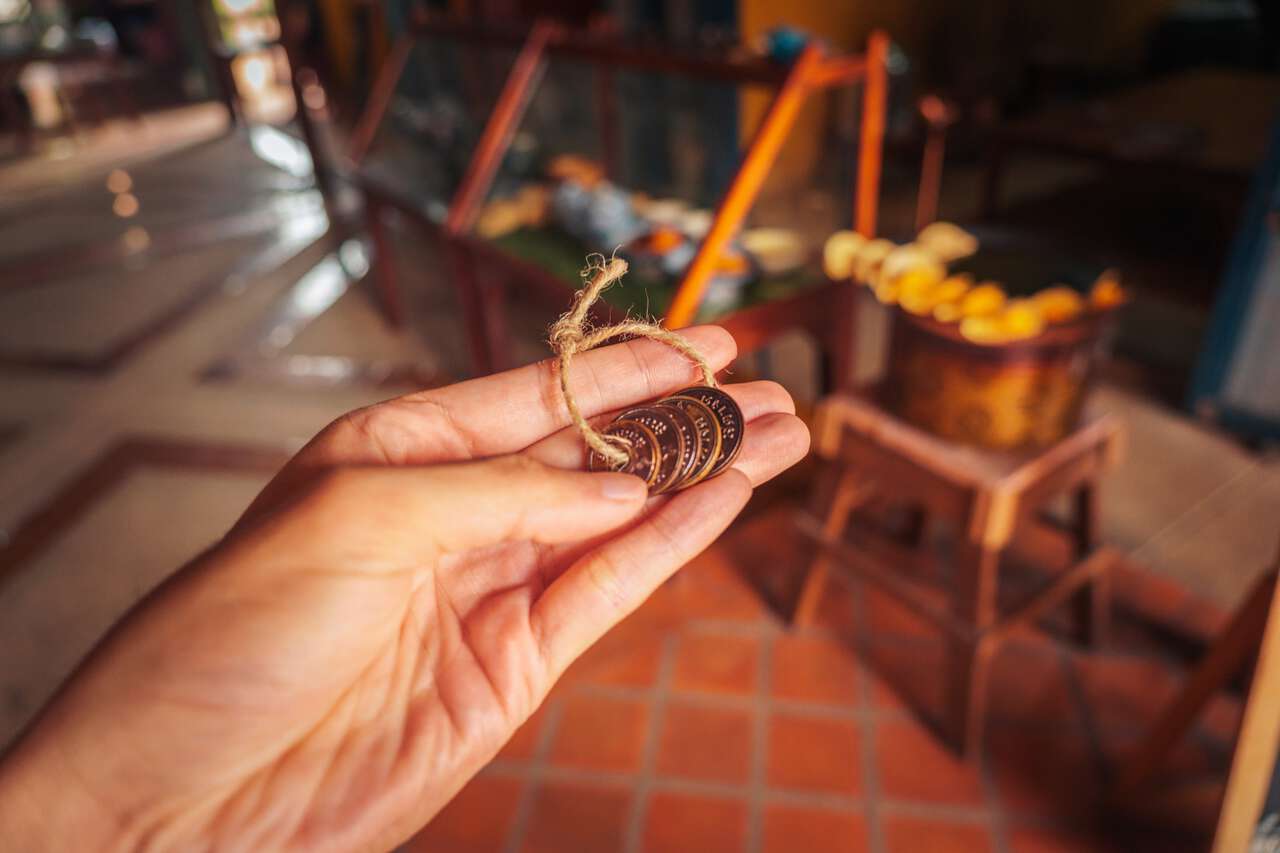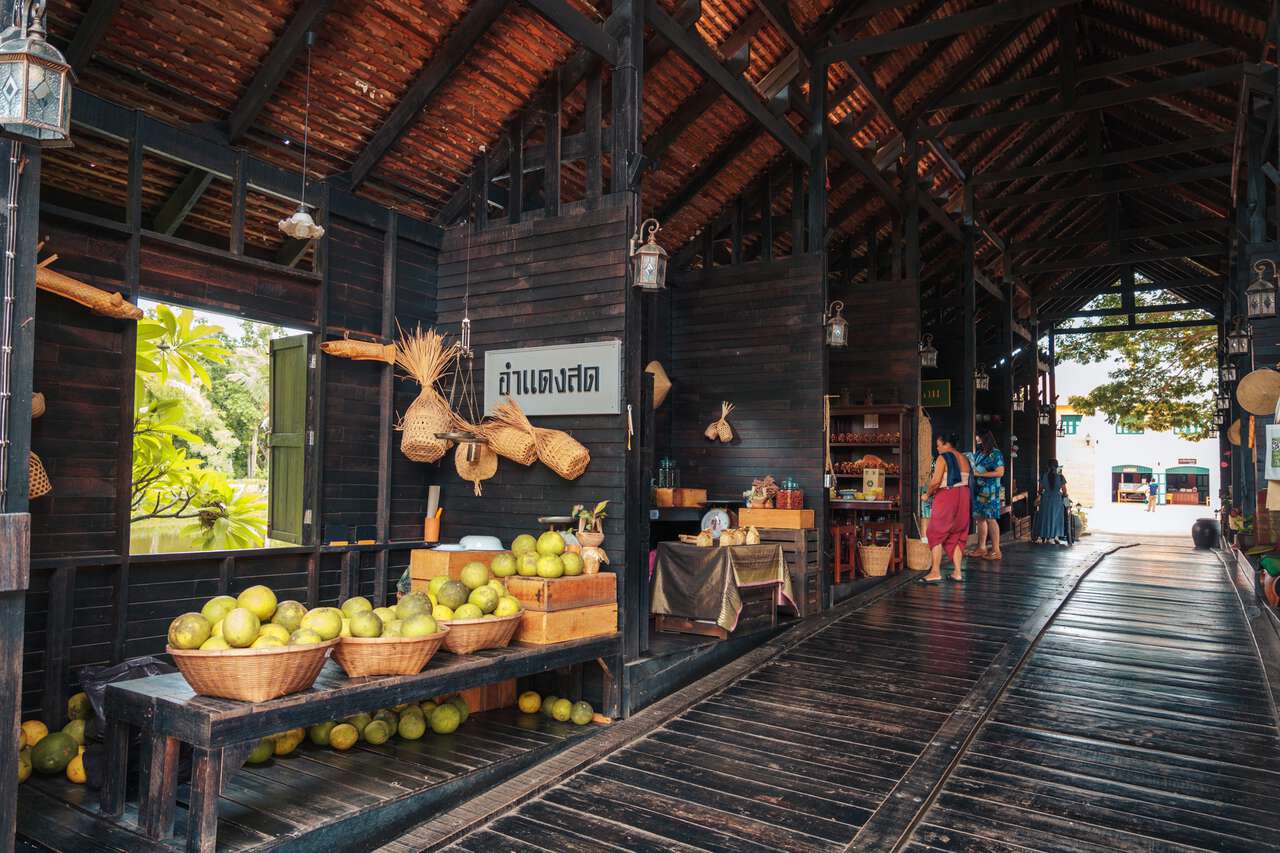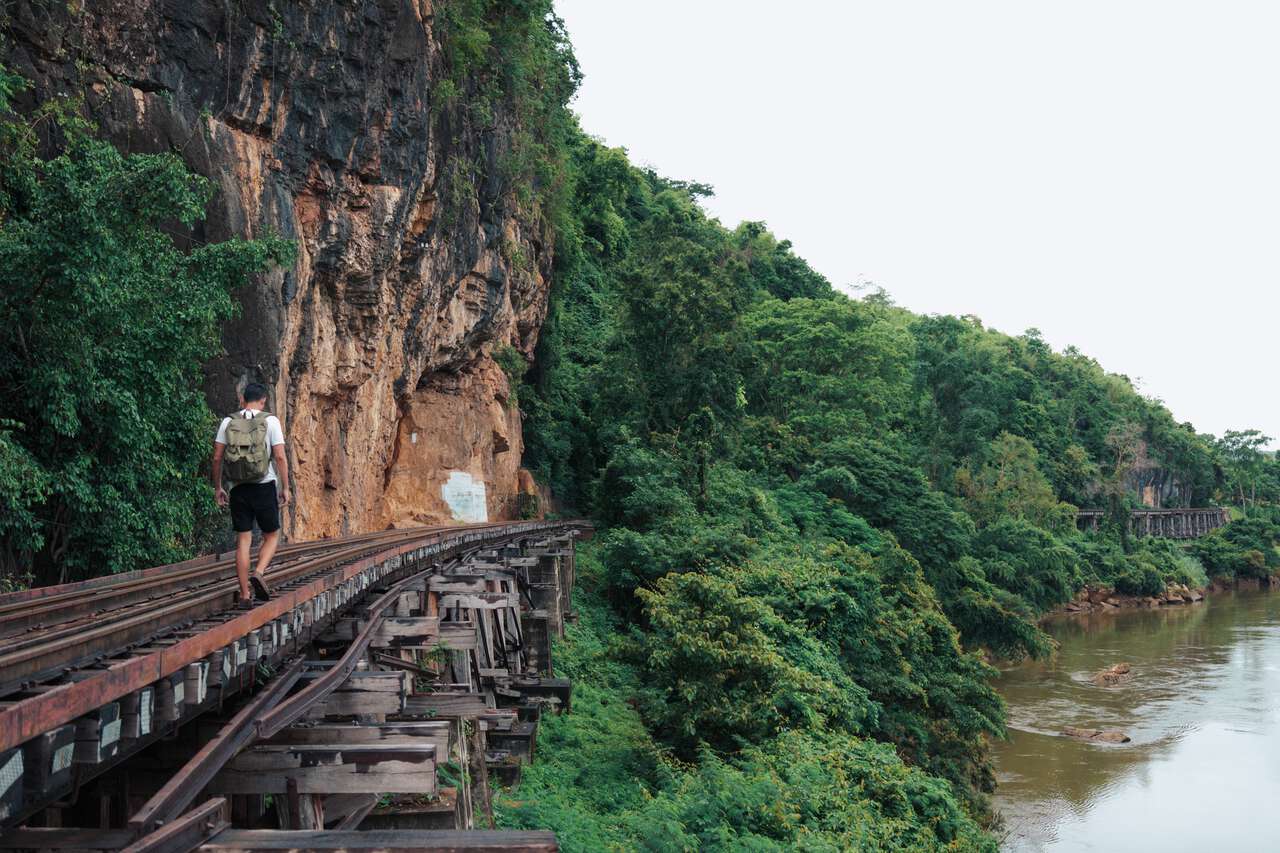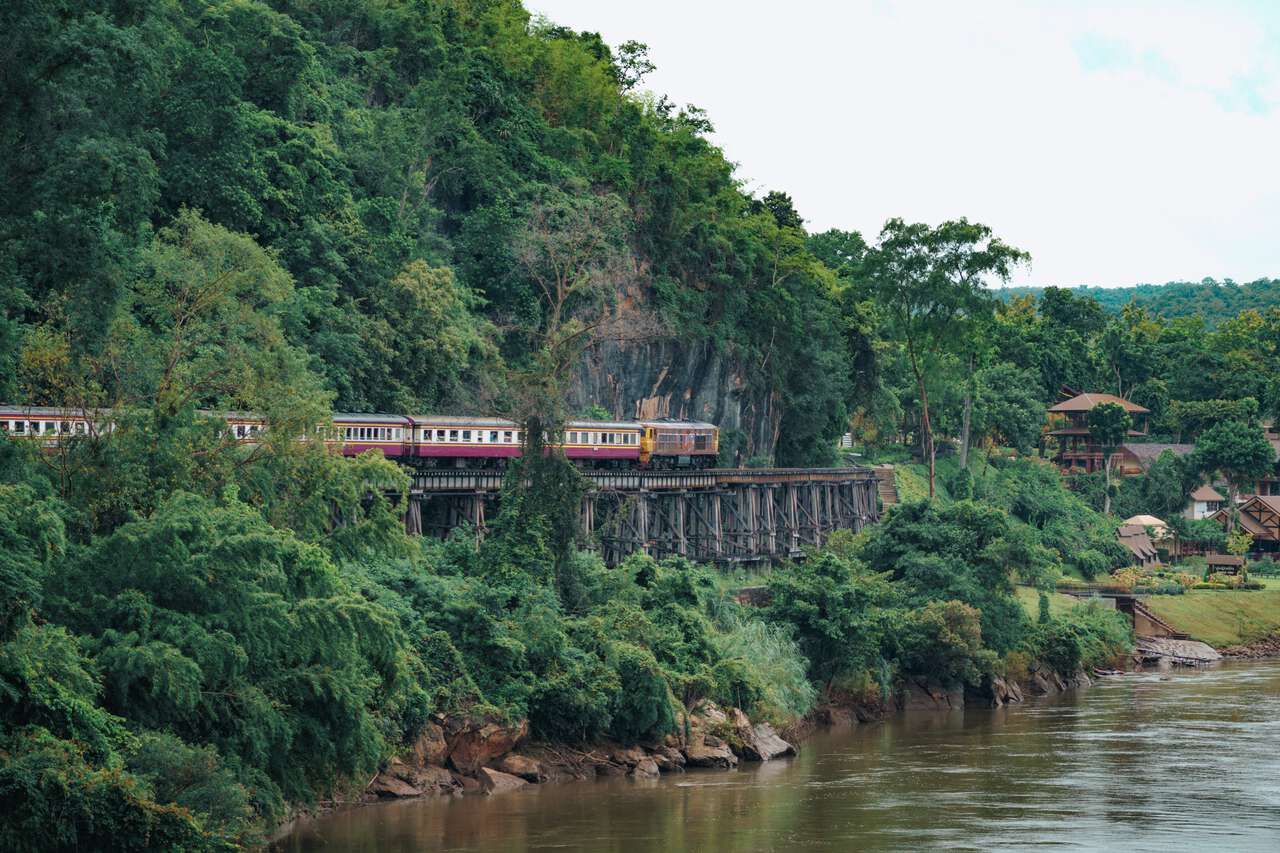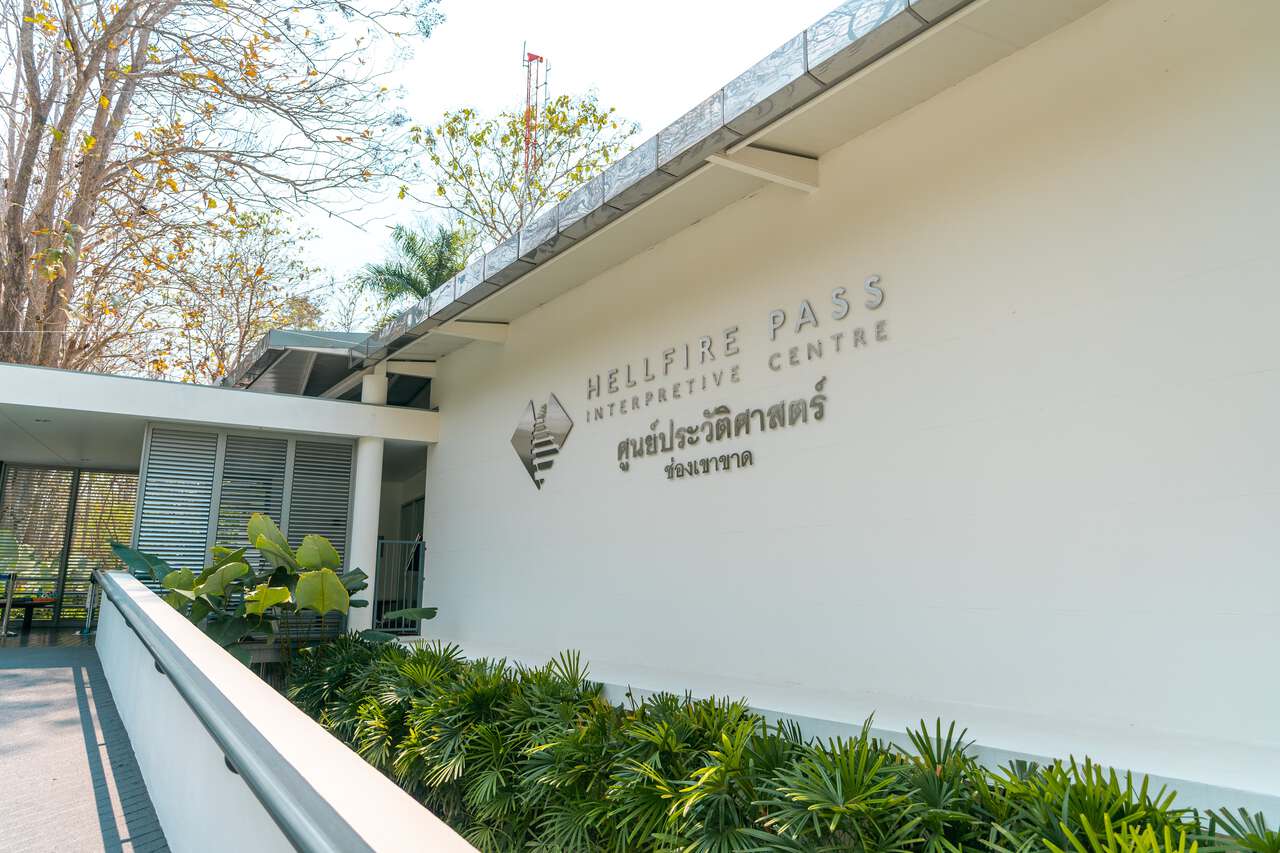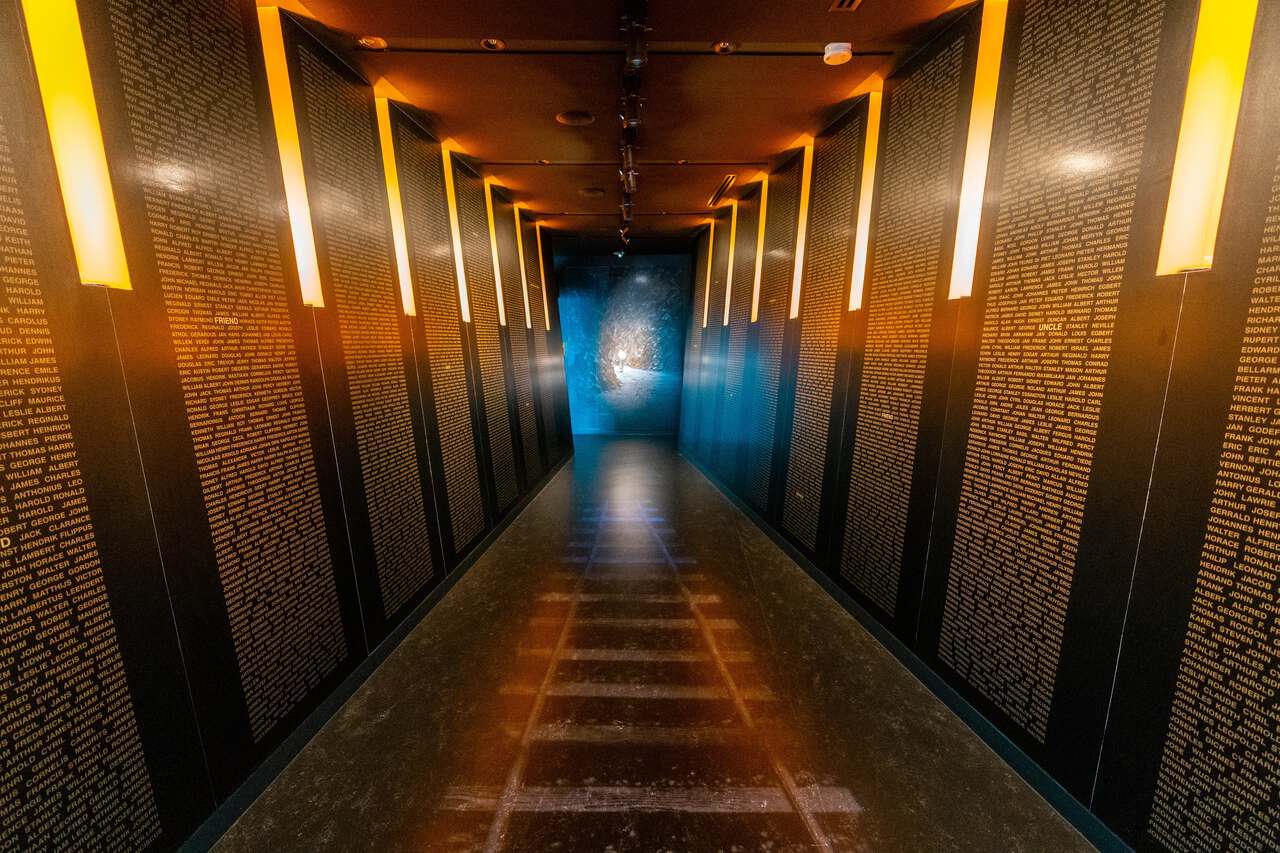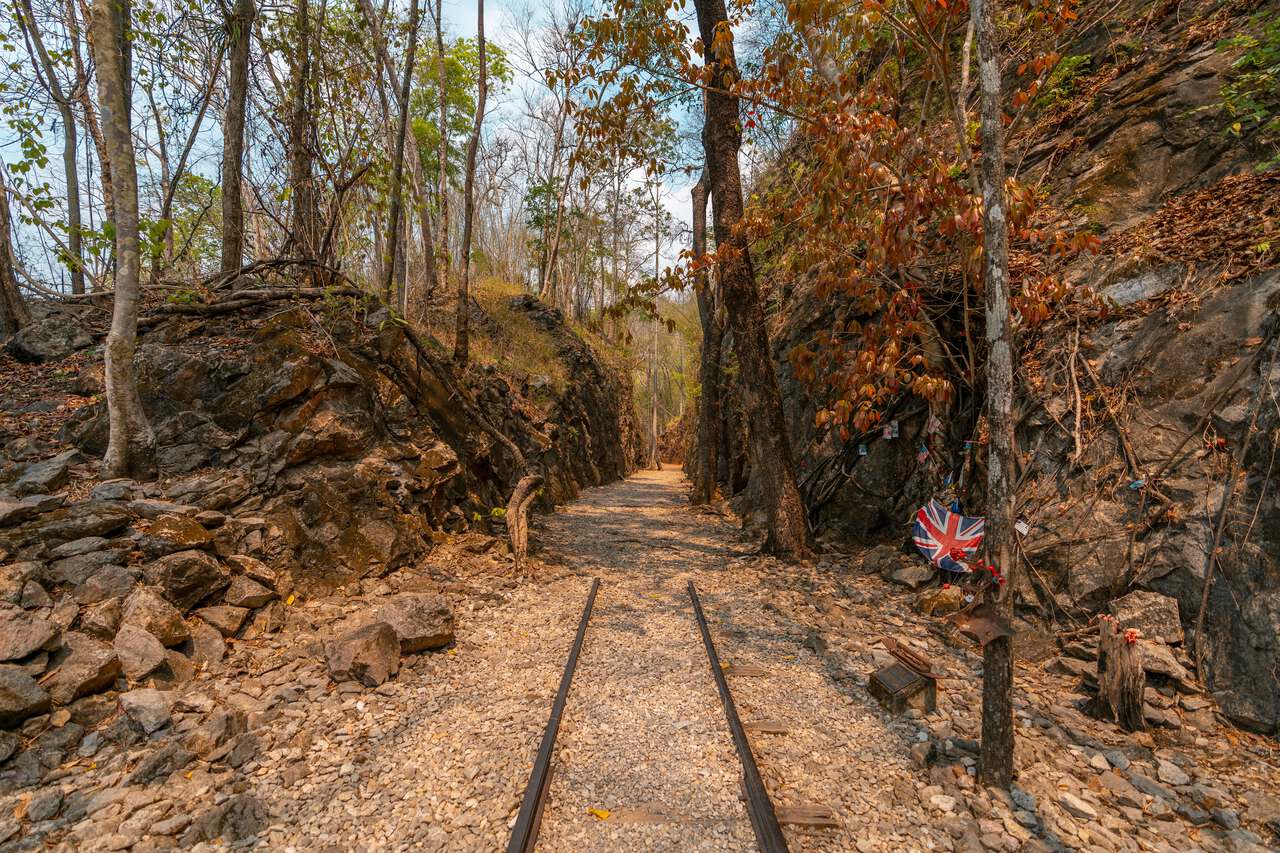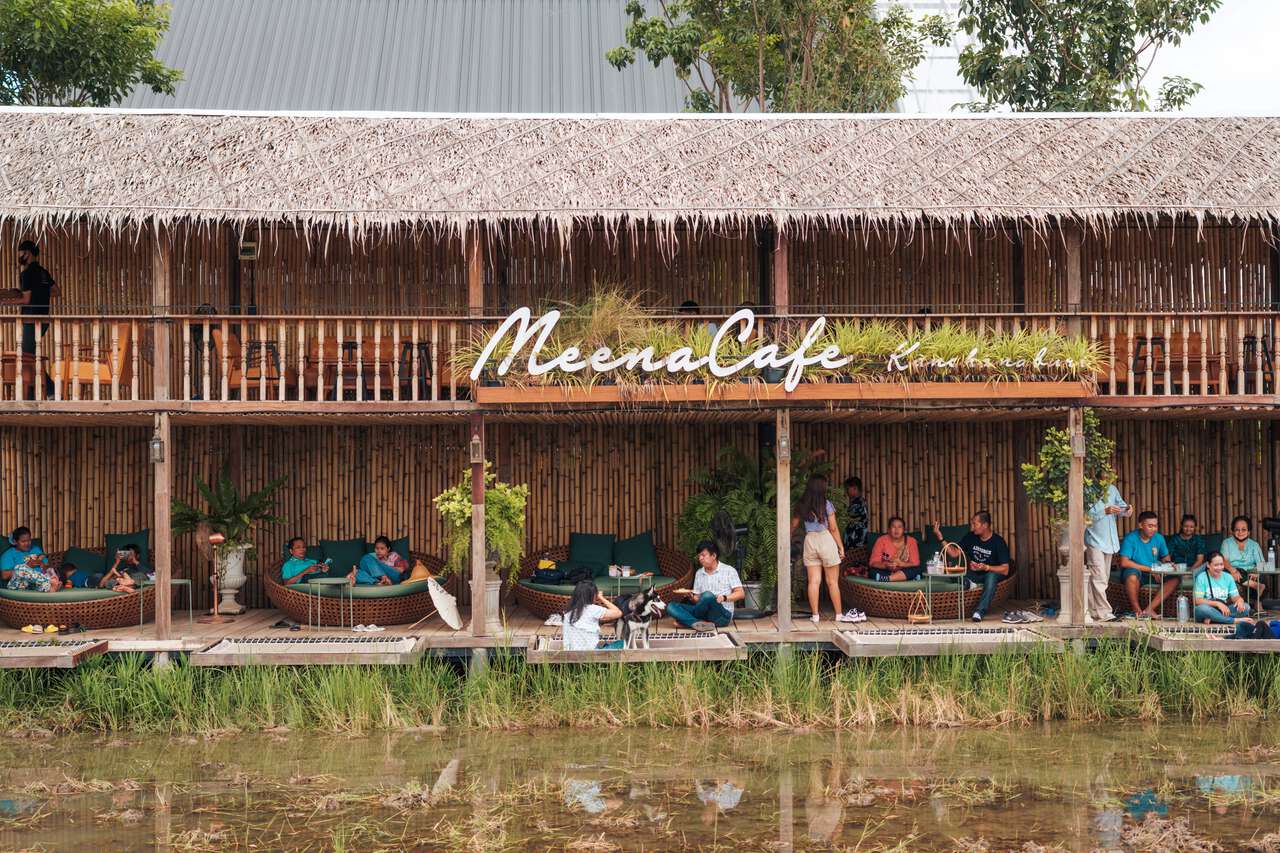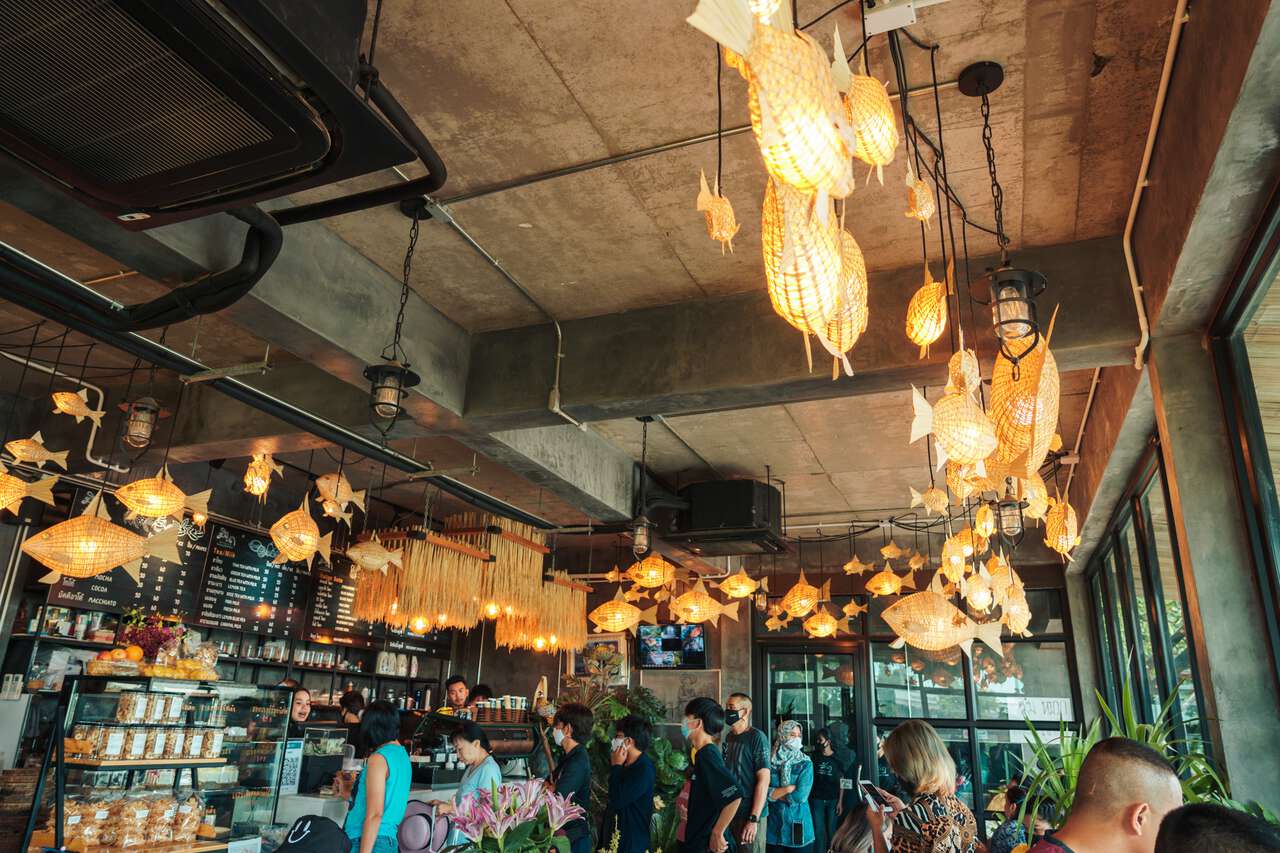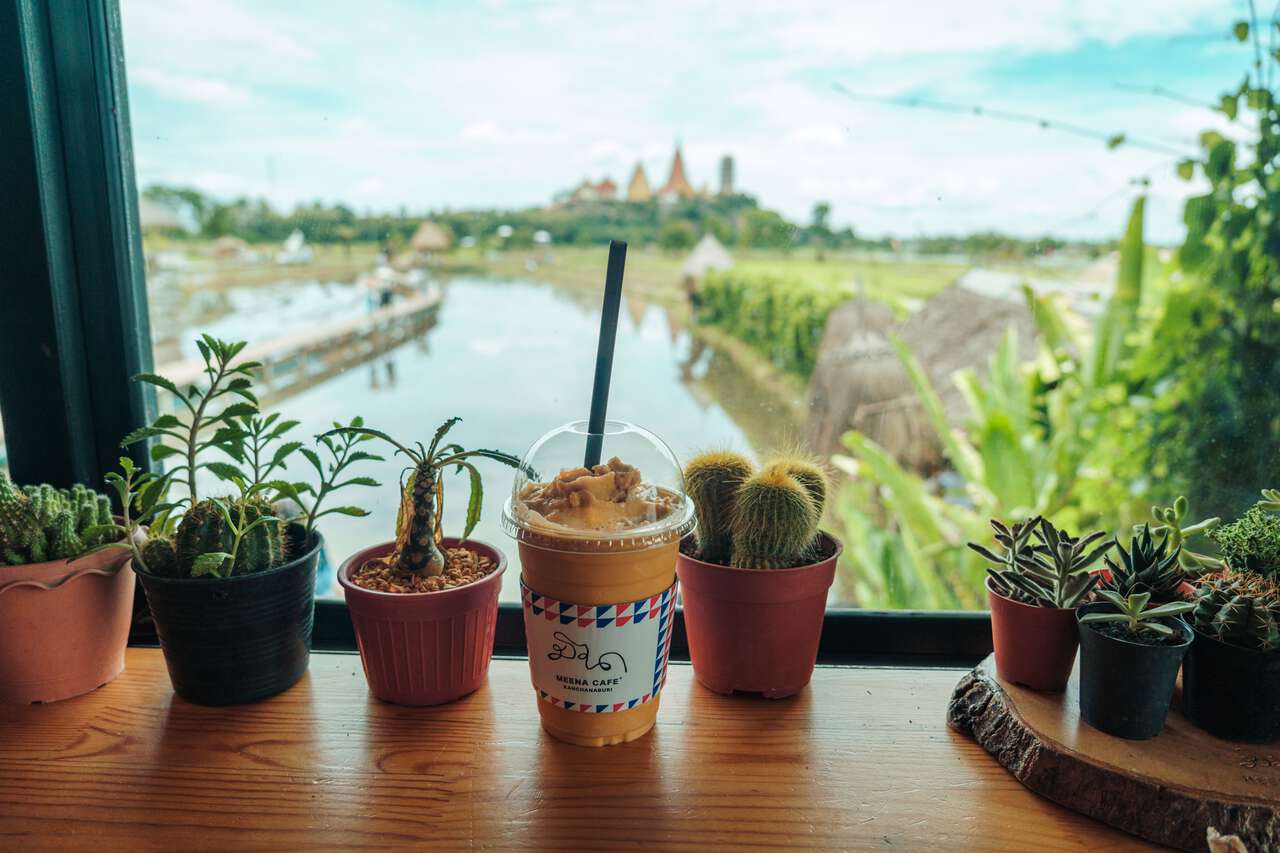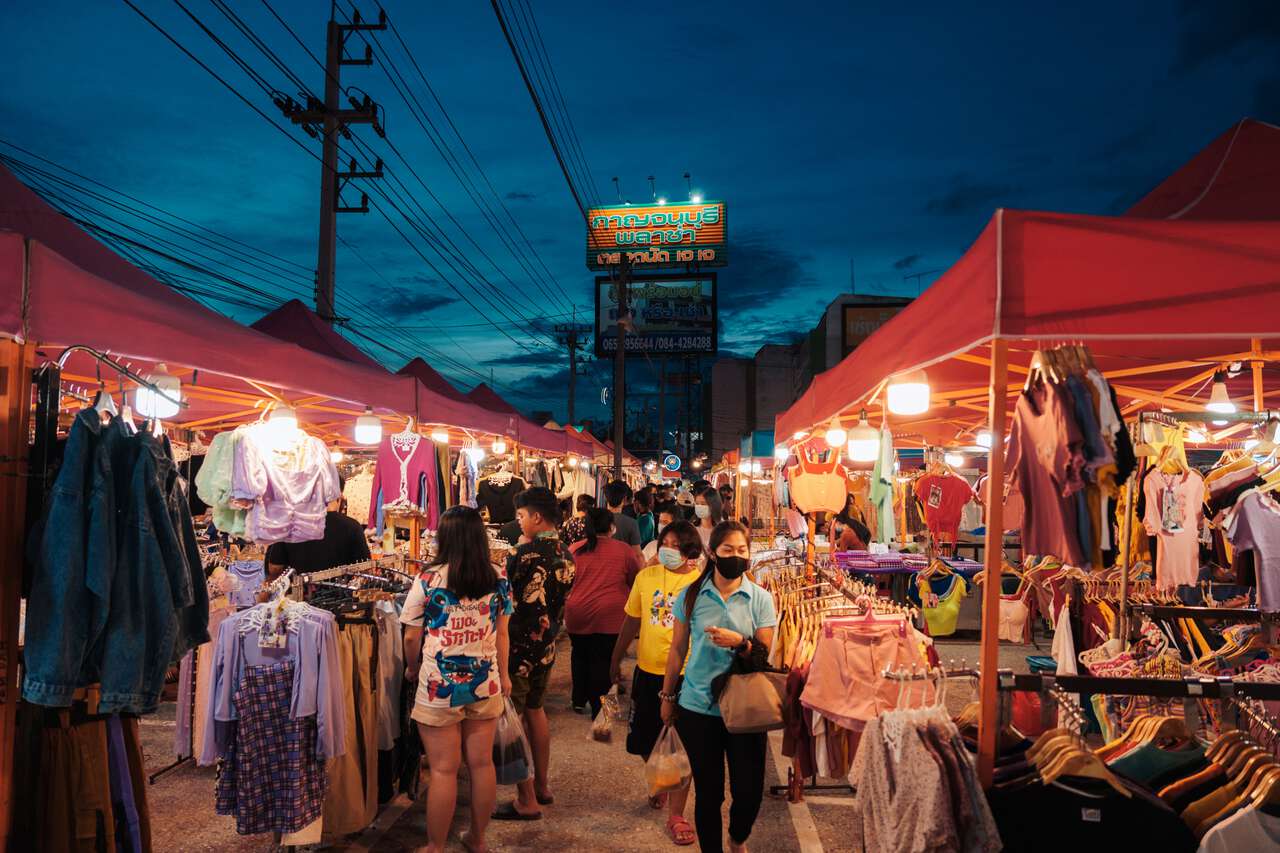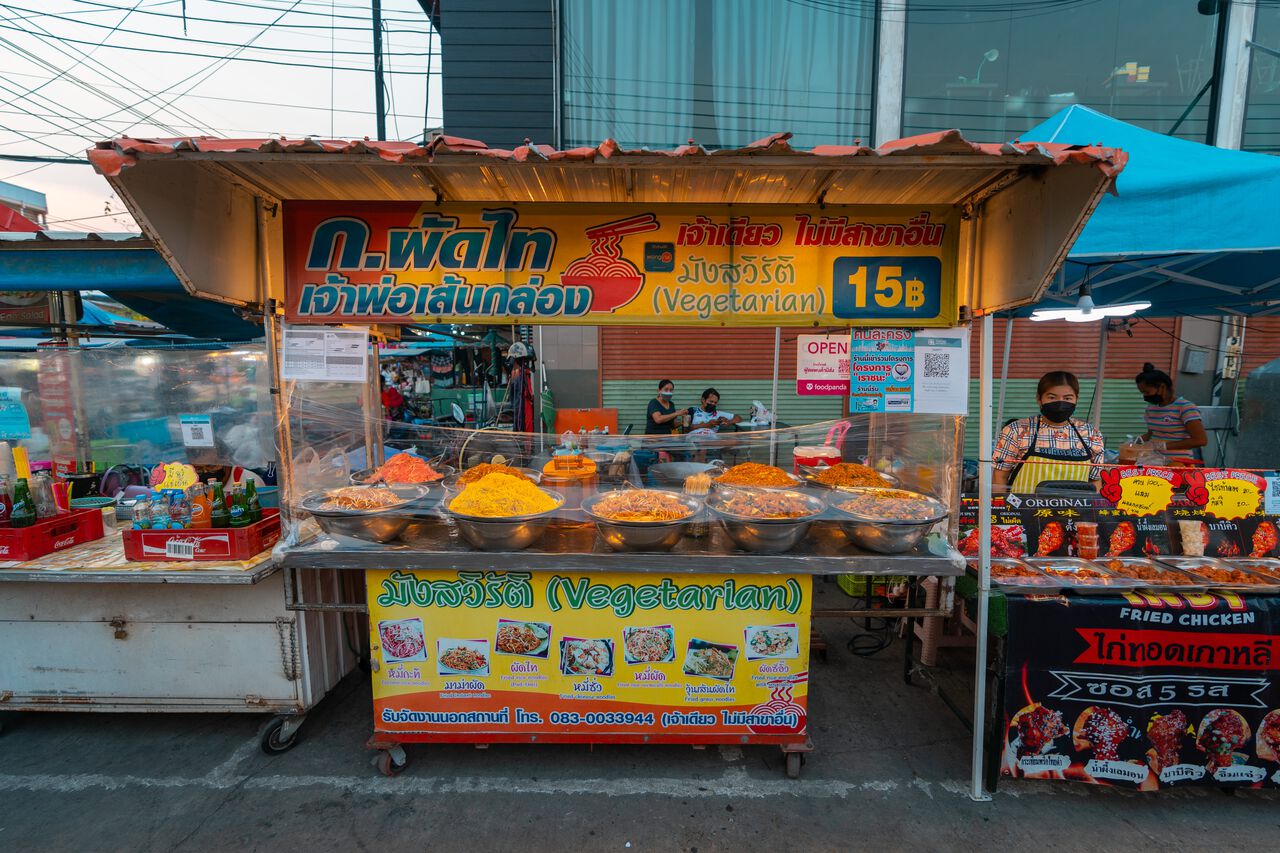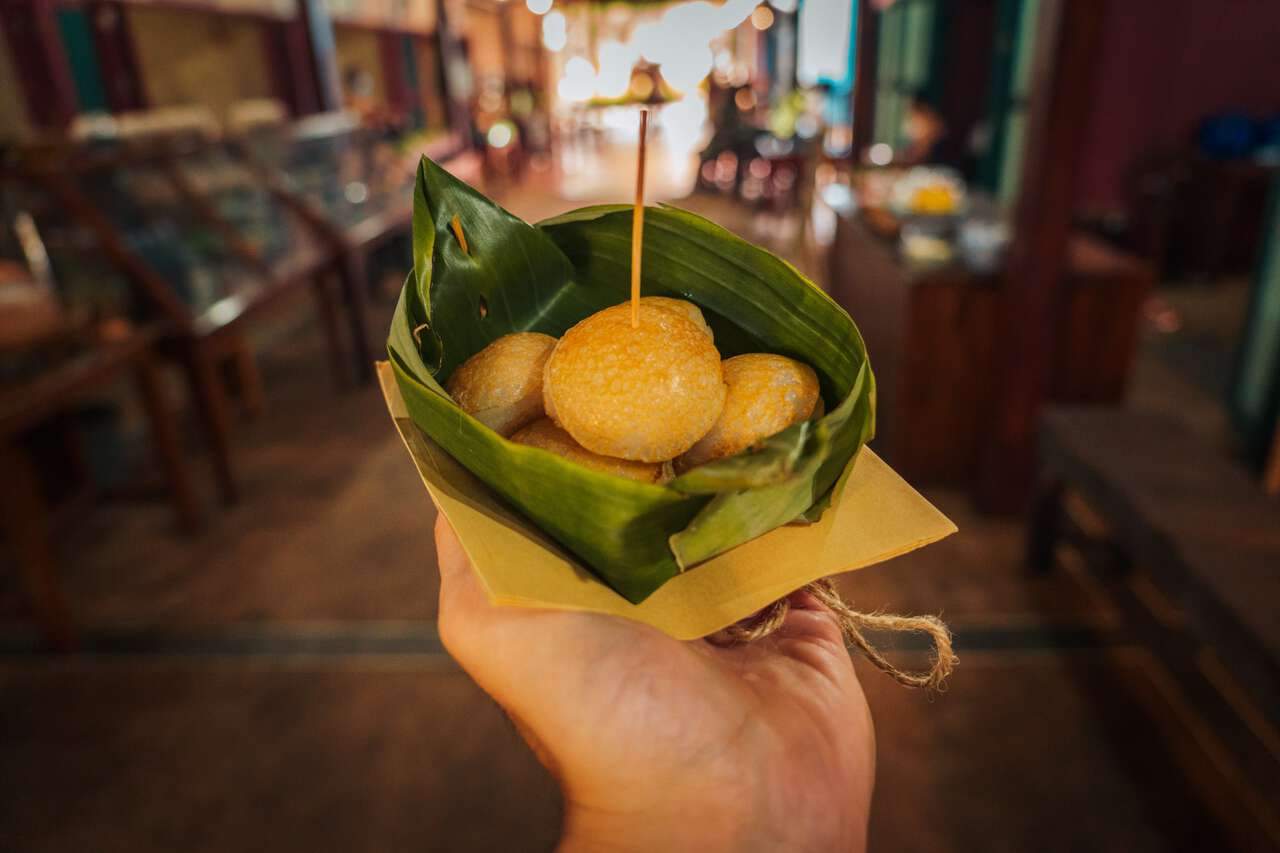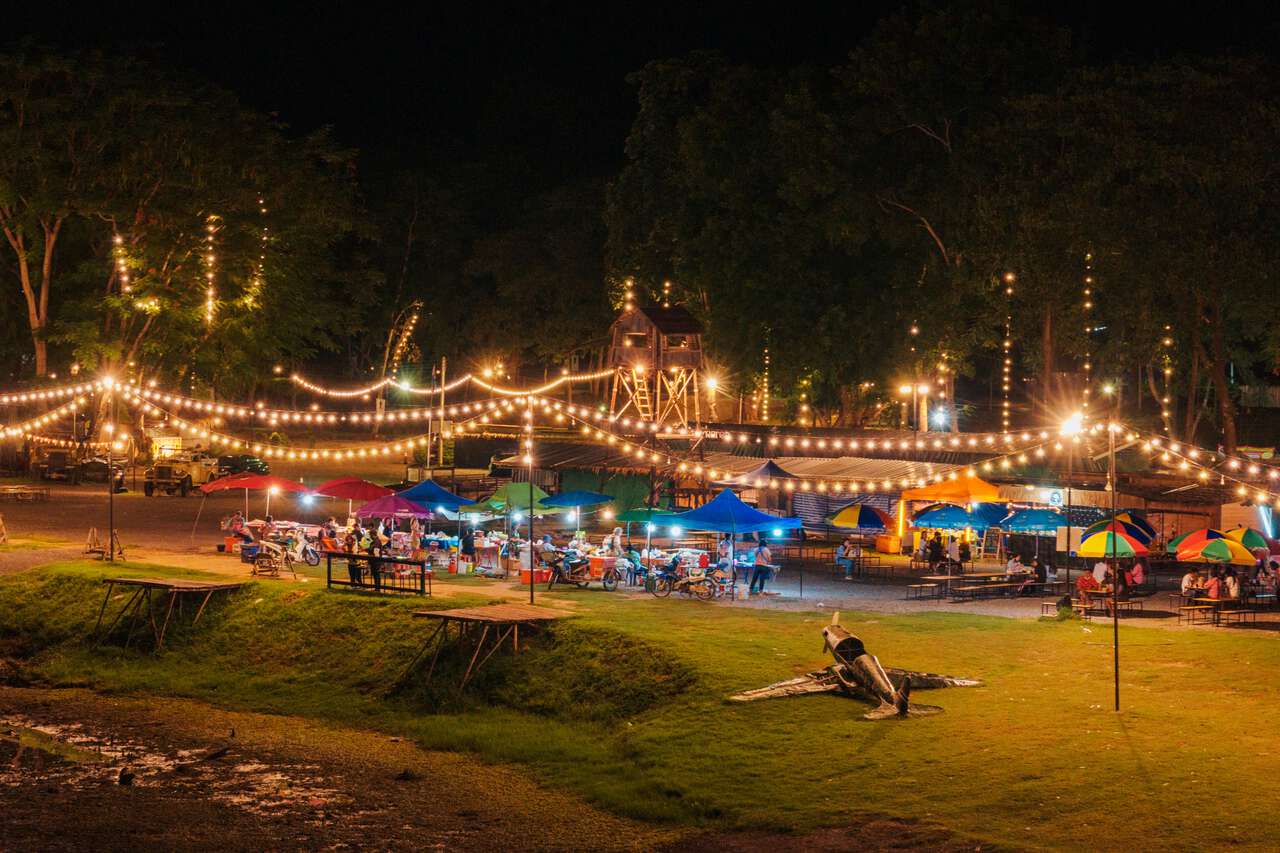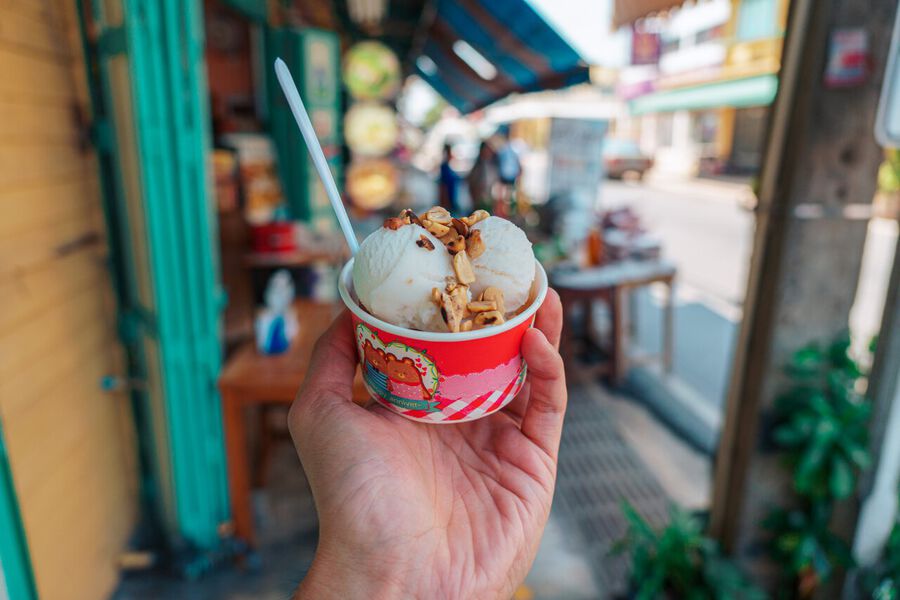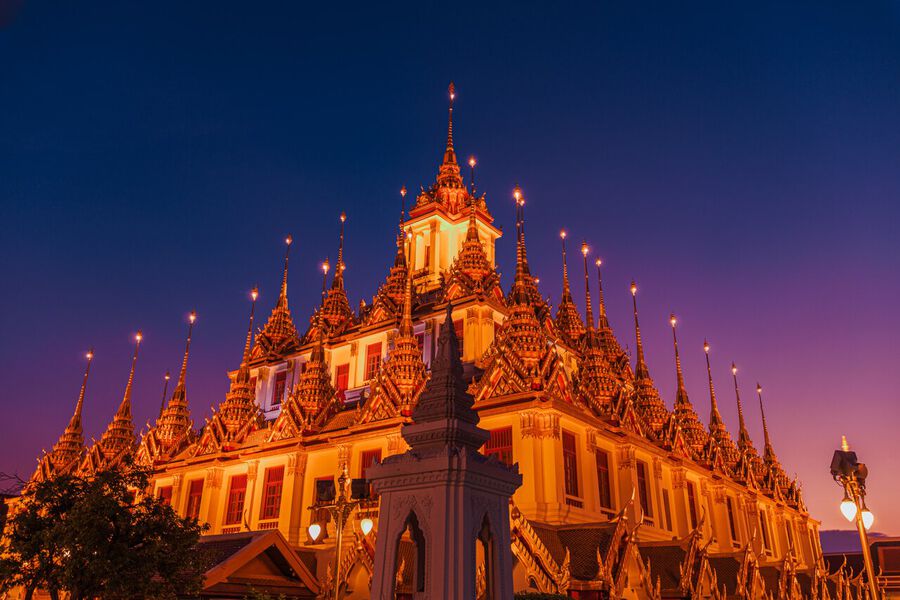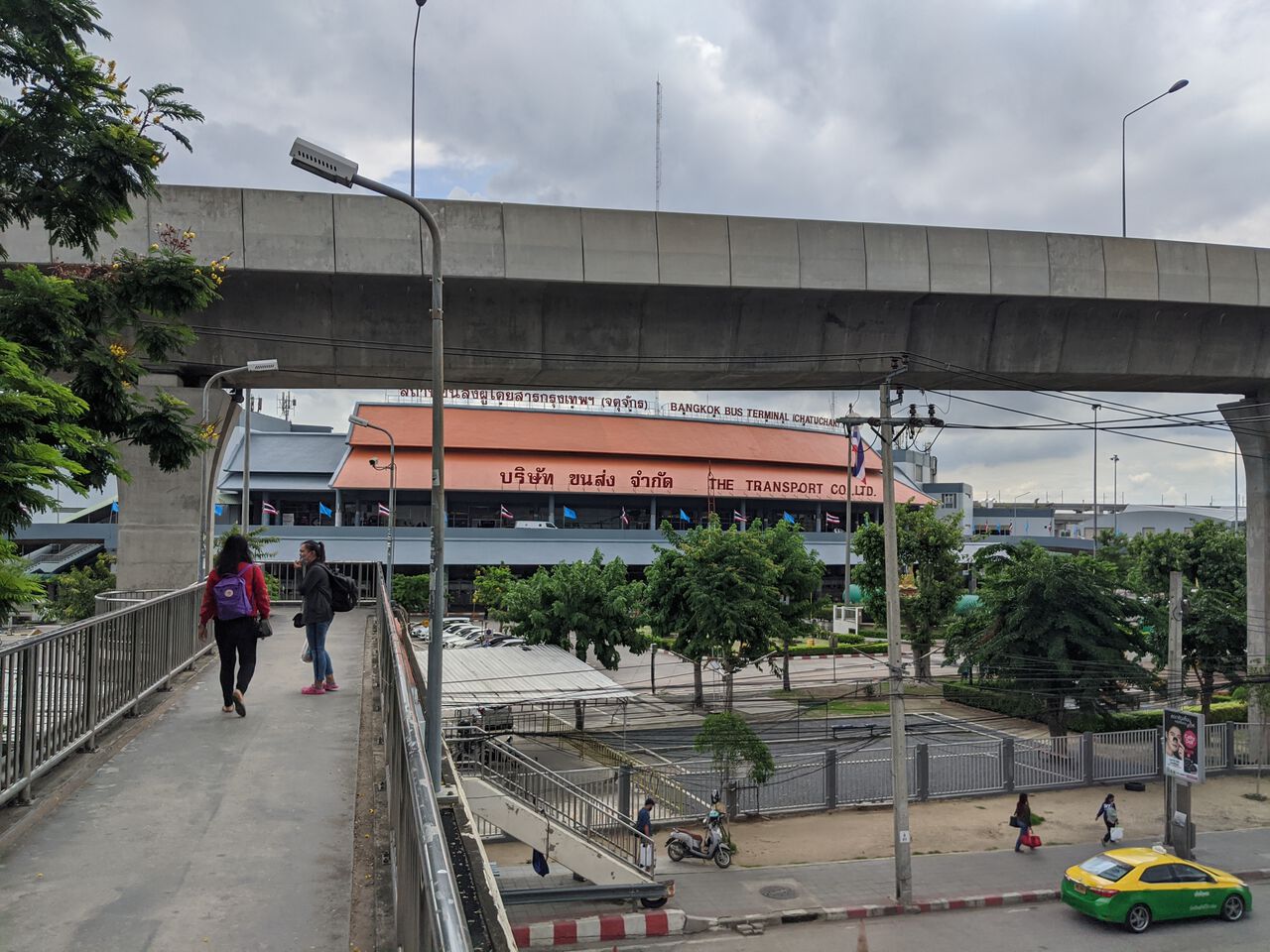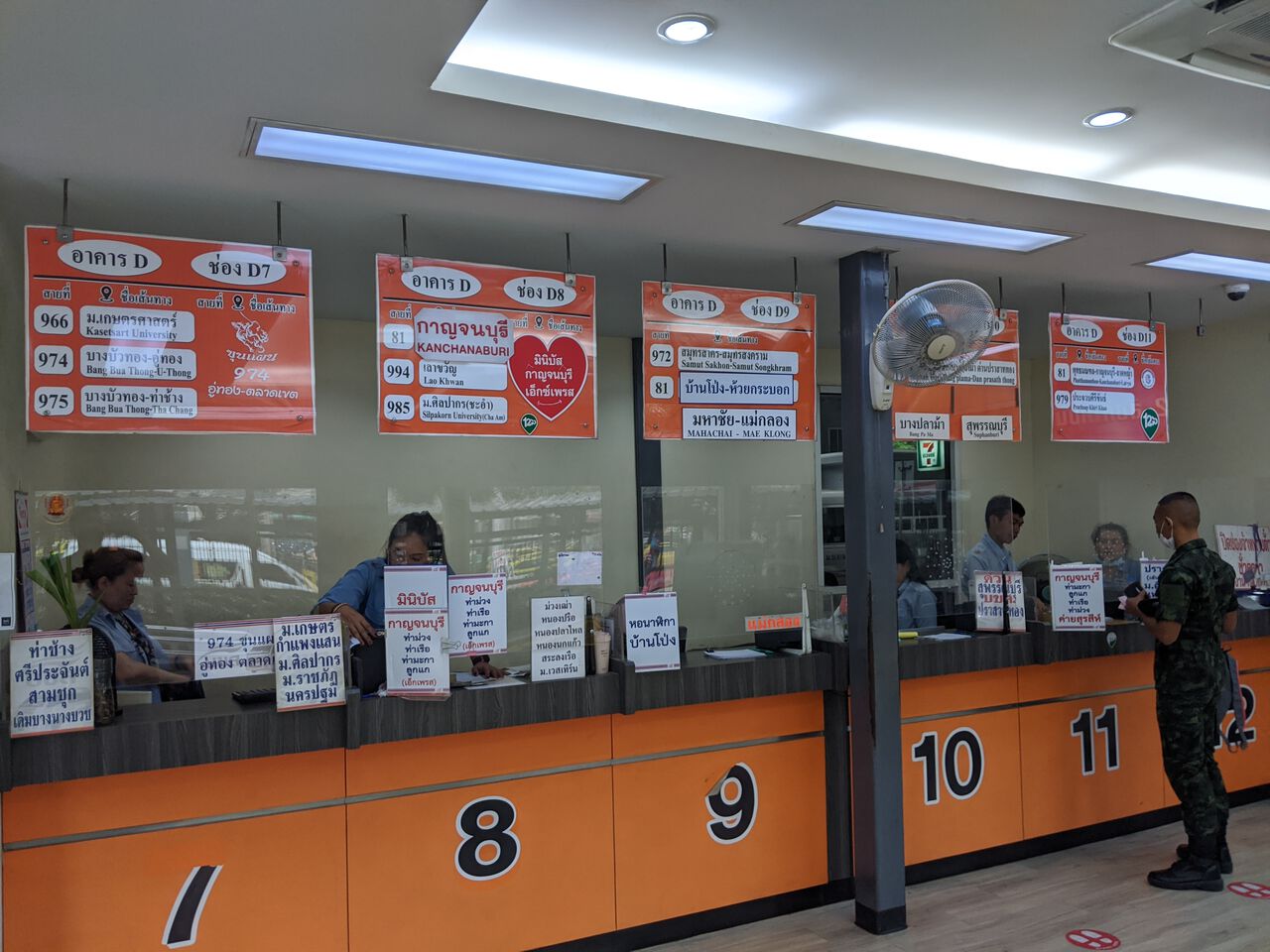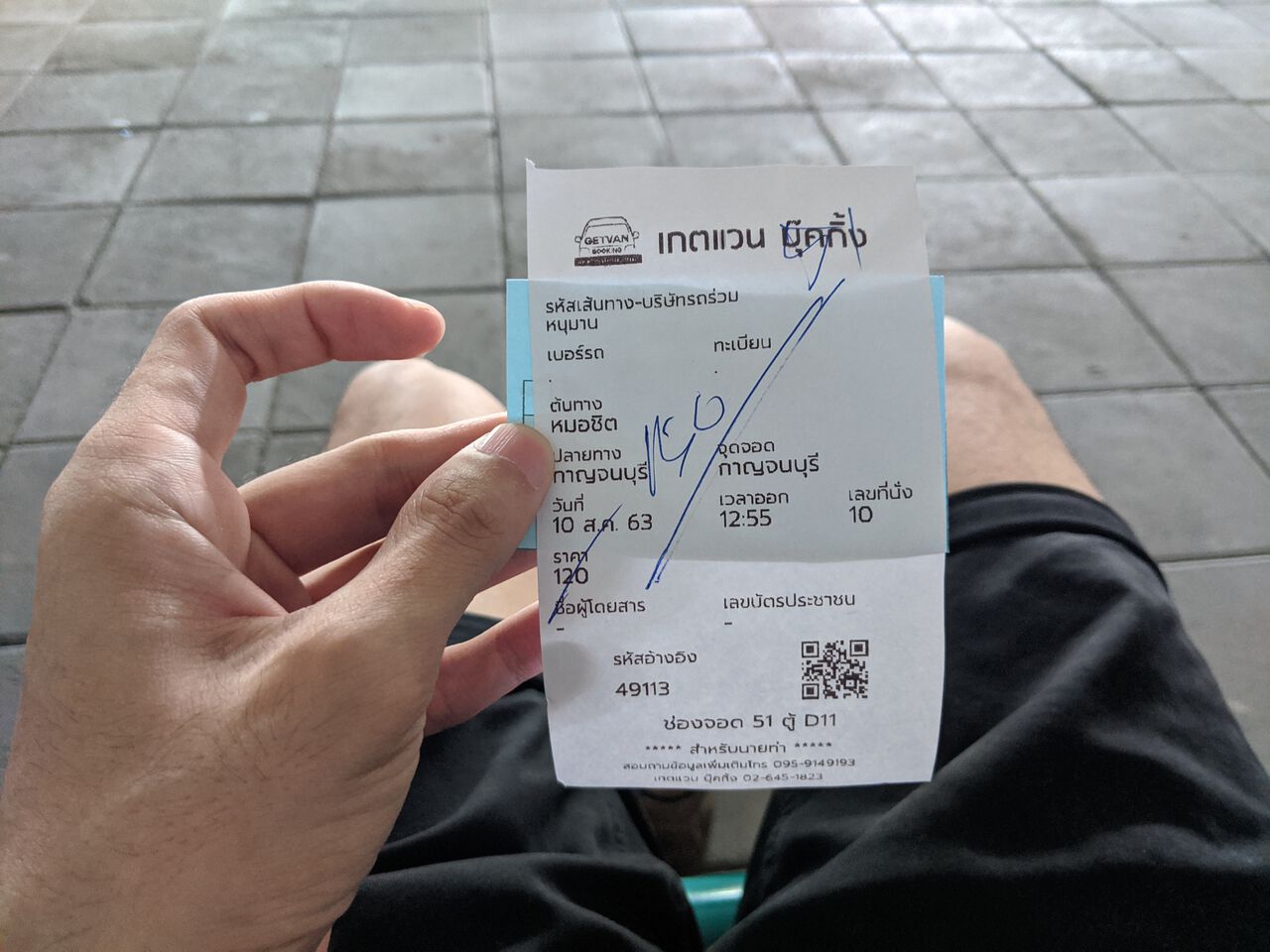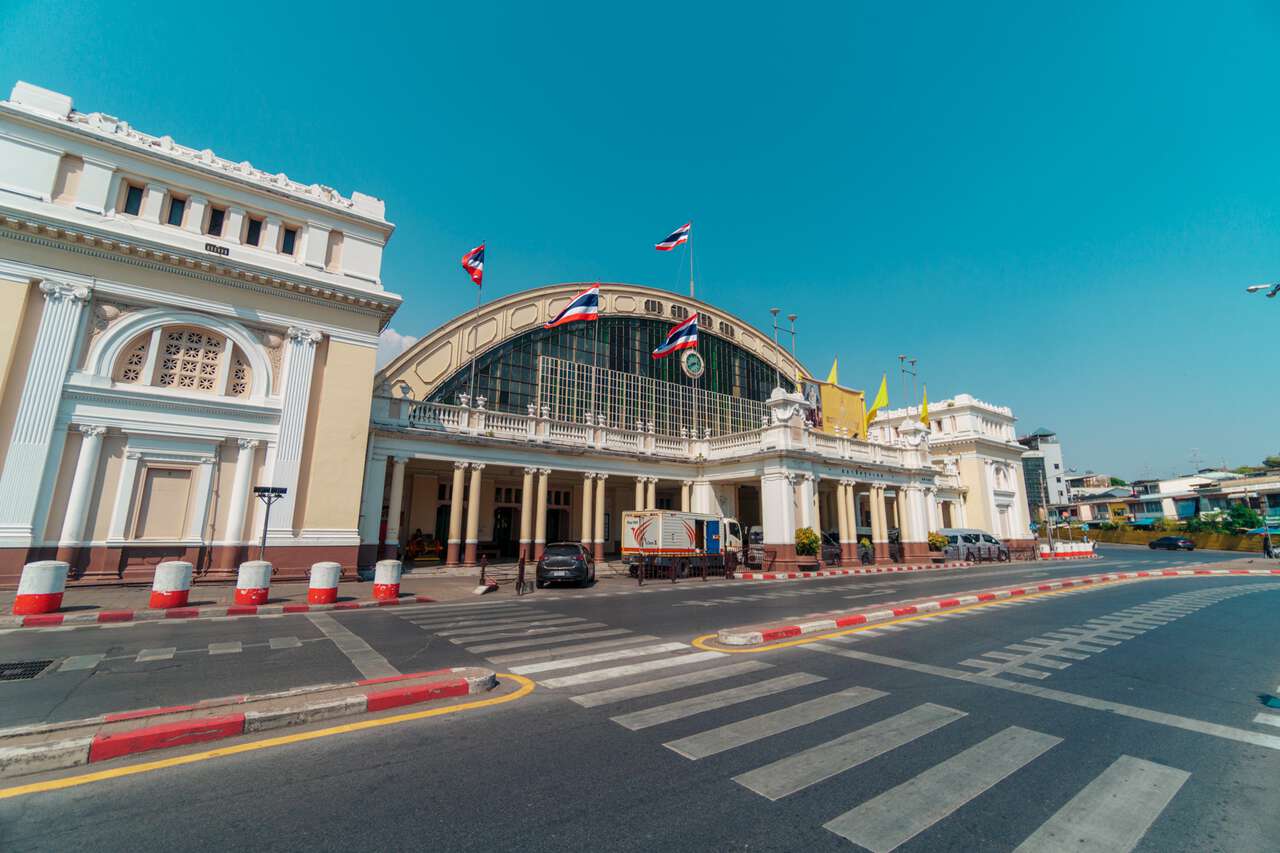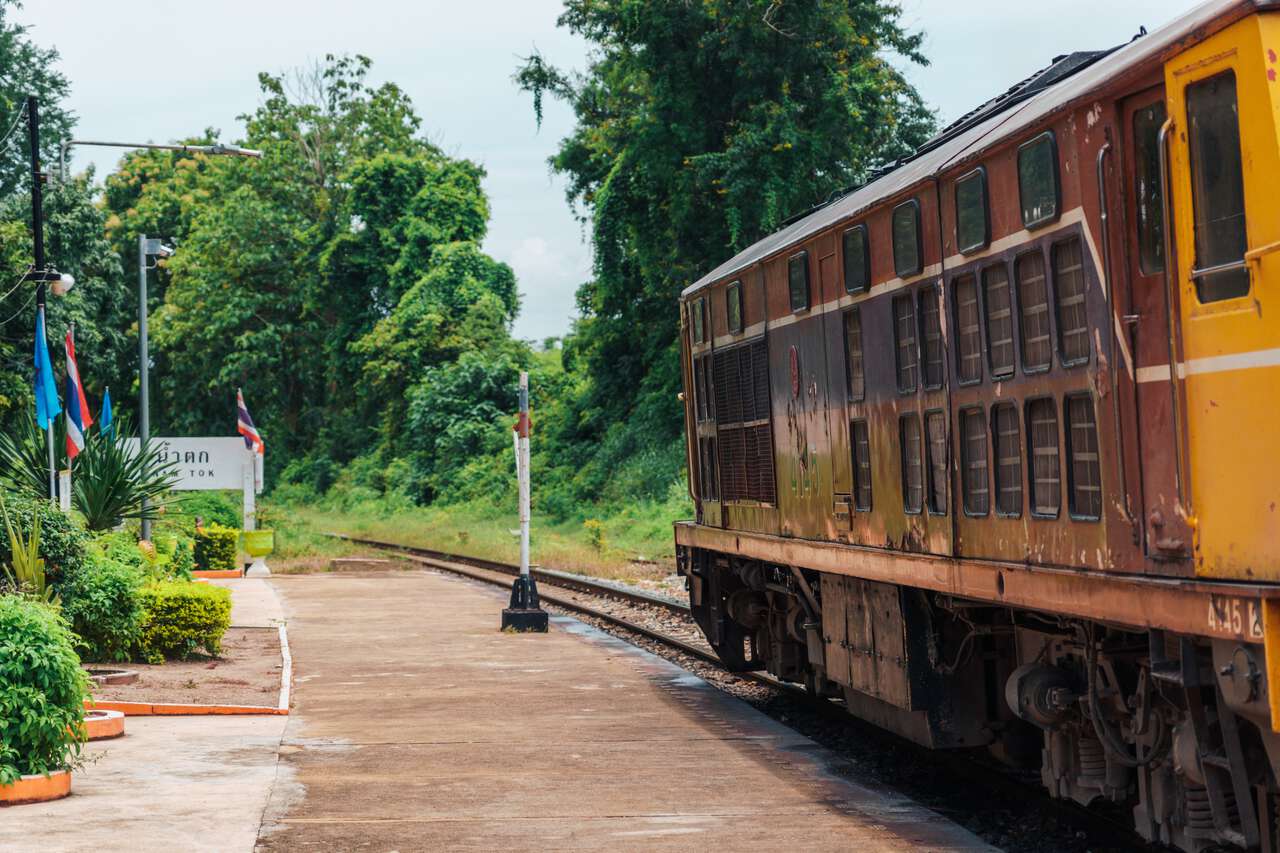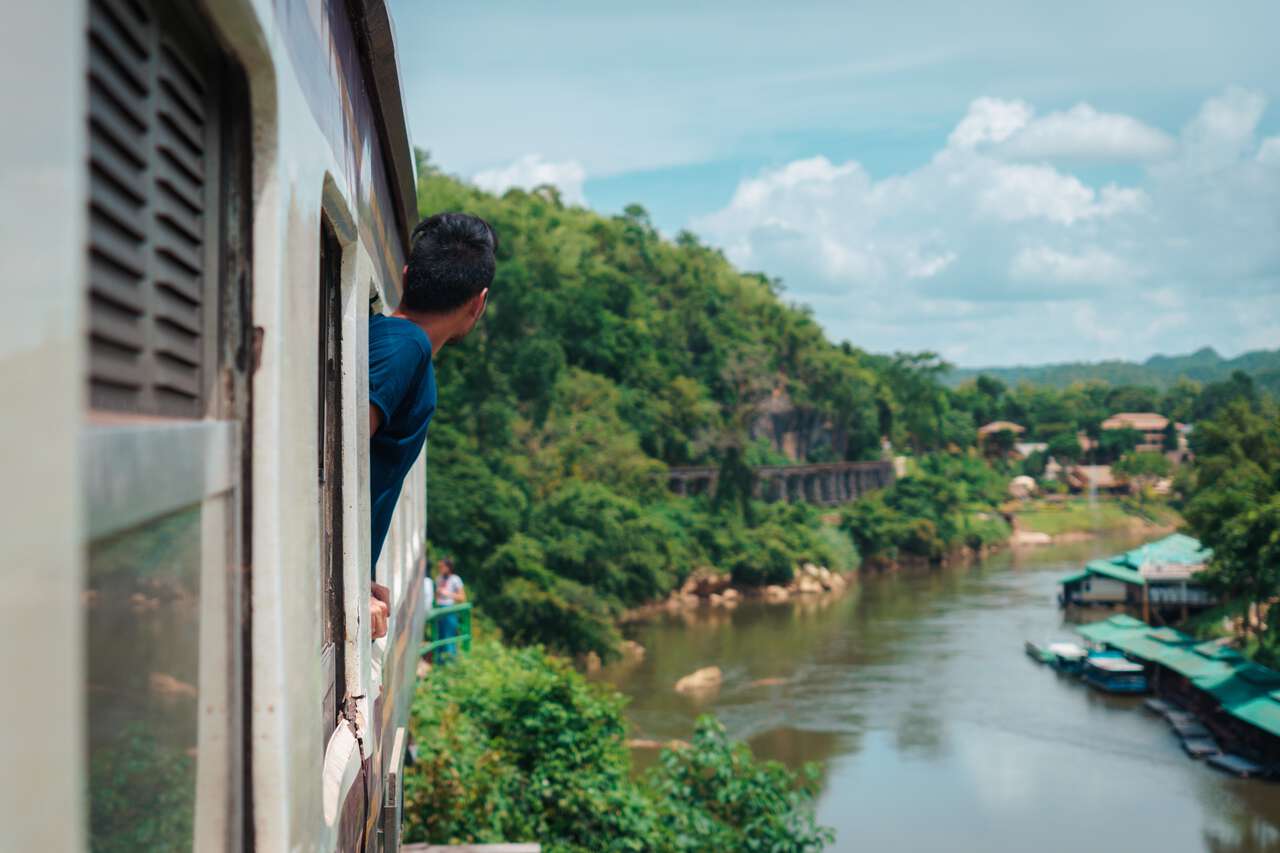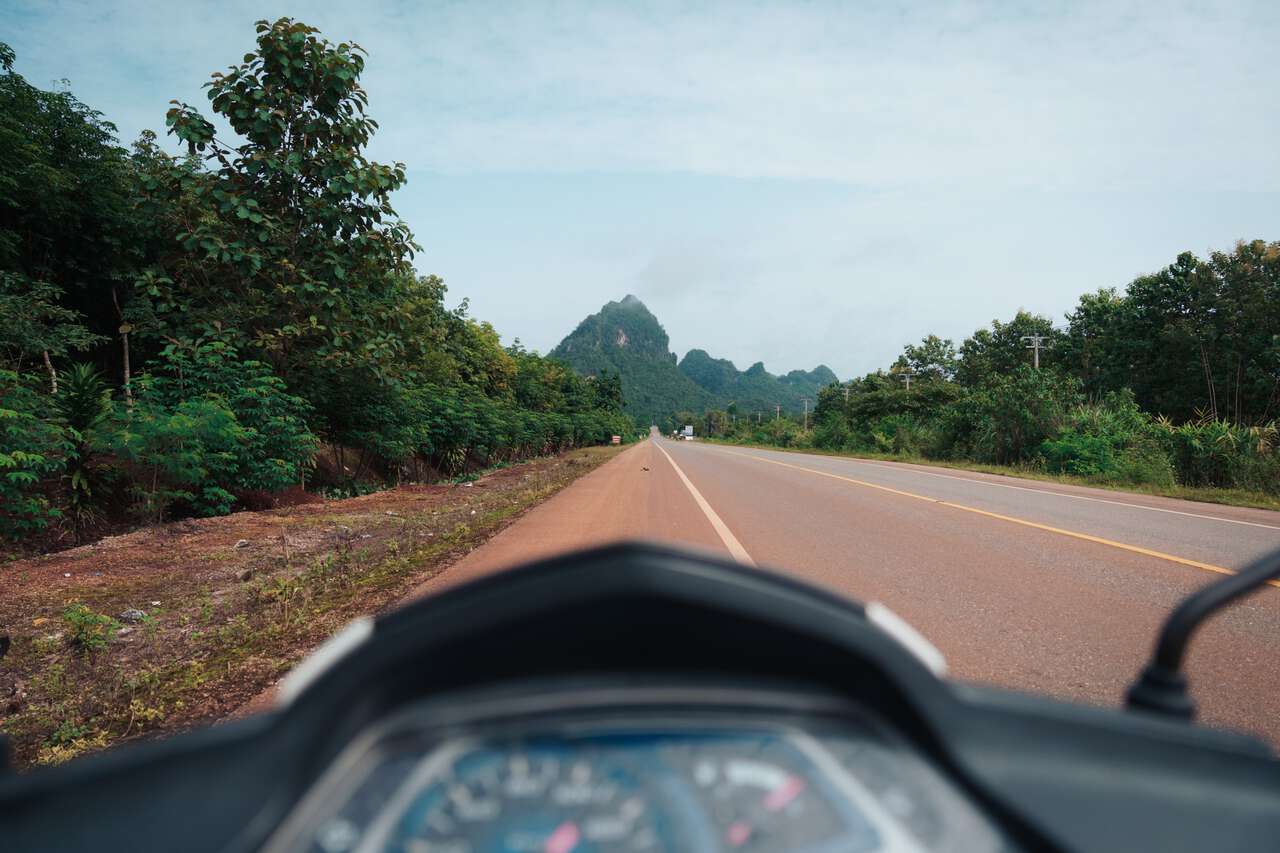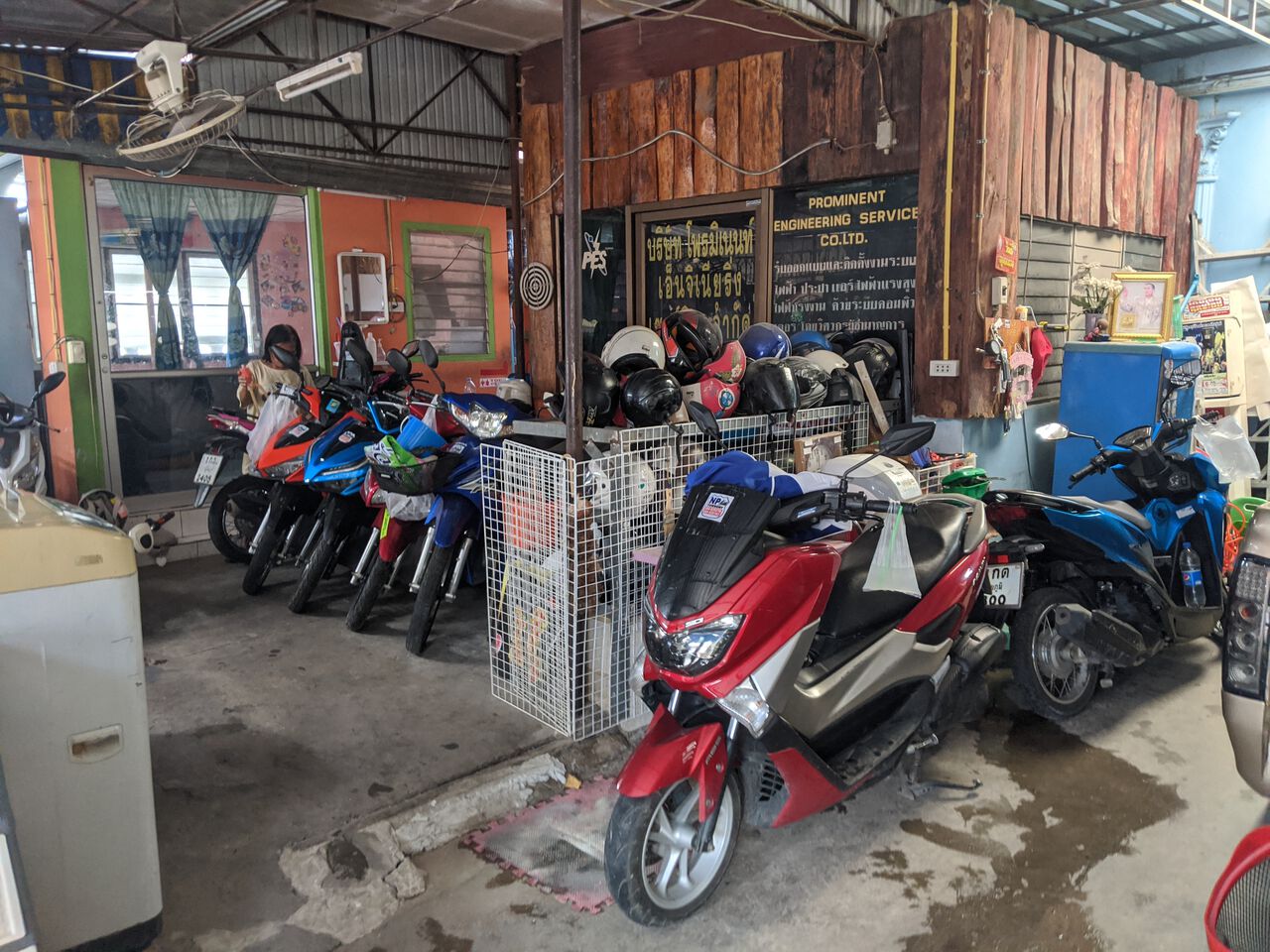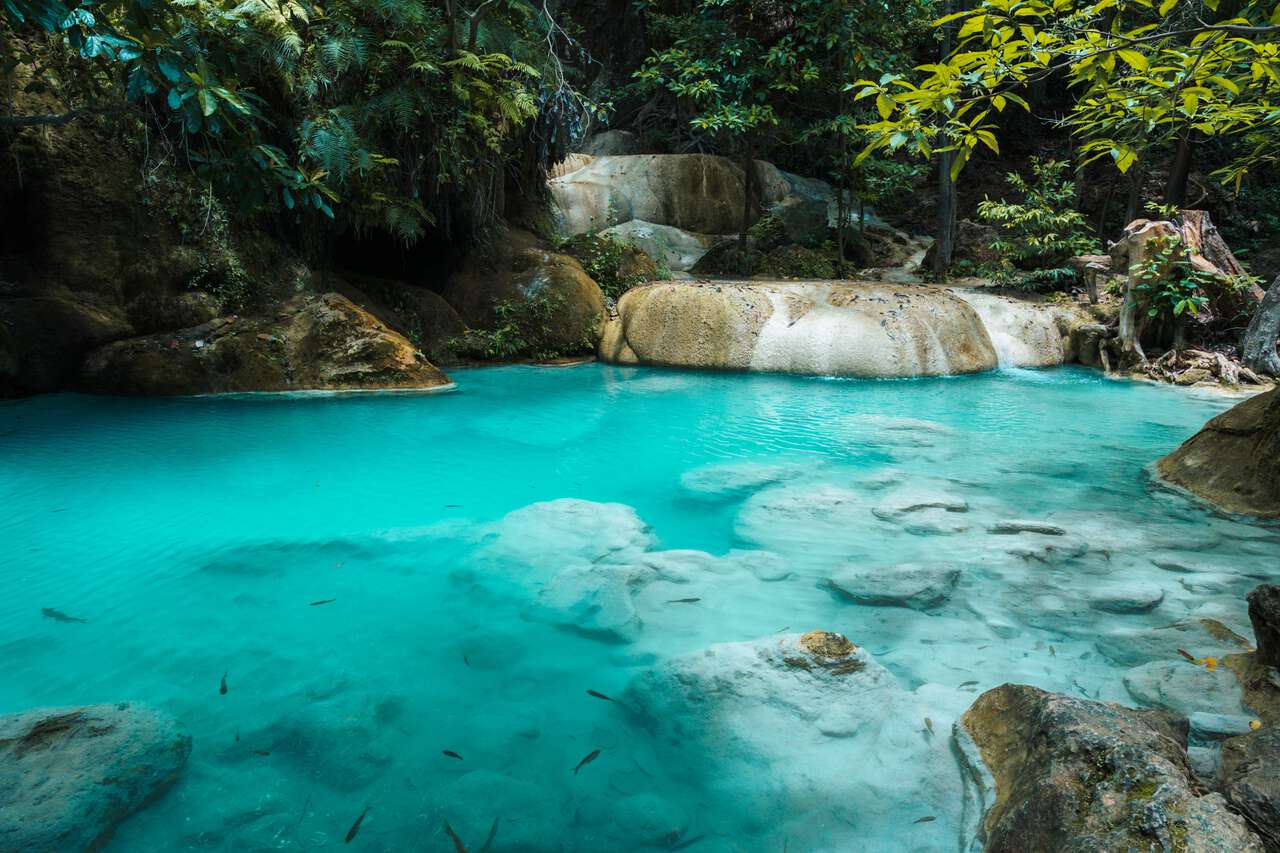Located only 140 km from Bangkok, Kanchanaburi is a great place to visit for those who are looking for a quick trip to escape the concrete walls of Bangkok and be among nature, go hiking, and swim in beautiful waterfalls. It also allows you to learn more about the historic Kanchanaburi city and see why the Thais love to visit Kanchanaburi so much.
Within this backpacking guide, you will find all the information you need for a great trip around Kanchanaburi City: from all the incredible things to do for solo travelers, to how to get to all these places. Without further ado, here is a complete backpacking guide to Kanchanaburi City, Erawan Falls, and more.
- Kanchanaburi Best Things To Do Itinerary Map
- Where to Stay in Kanchanaburi, Thailand?
- Quick Summary: Things to do in Kanchanaburi
-
17 Best Things to Do in Kanchanaburi
- Spend a Day Hiking Around Erawan Waterfalls
- Be Amazed at Phra That Cave
- Watch the Sunset at Srinagarind Dam Viewpoint
- Visit the Huay Maekhamin Waterfalls
- Watch the Sunrise at Wat Tham Khao Pun
- Climb Up to the Top of Wat Baan Tham
- Be Amazed at the Scale of Wat Tham Sua
- Check Out the Giant Raintree
- Learn About the Dark History of Kanchanaburi at the Death Railway Museum
- Visit Wat Thaworn Wararam
- Learn About World War 2 from the Thai-Japanese side at JEATH War Museum
- Visit the River Kwai Bridge
- Drop by at Prasat Mueang Sing Historical Park
- Travel back to the Time of King Rama the Fifth at Mallika R.E 124 Retro City
- Watch the Train Crossing the Tham Krasae Death Railway Bridge at 1:30 PM
- Visit Hellfire Pass Interpretive Centre
- Visit Sai Yok Waterfalls
- More Kanchanaburi Activities
- Where to Eat and Drink in Kanchanaburi?
- Thailand Travel Video
- When to Visit Kanchanaburi, Thailand?
- How to Get to Kanchanaburi, Thailand?
- How to Get Around Kanchanaburi City, Thailand?
- How Many Days to Spend in Kanchanaburi?
- How Much Money Do I Need For Kanchanaburi?
- Is it Safe in Kanchanaburi, Thailand?
- Which tourist SIM card is best for Thailand?
- What to Pack for Kanchanaburi, Thailand?
- Further Reading for Central Thailand
Kanchanaburi Best Things To Do Itinerary Map
Quick Summary: Things to do in Kanchanaburi
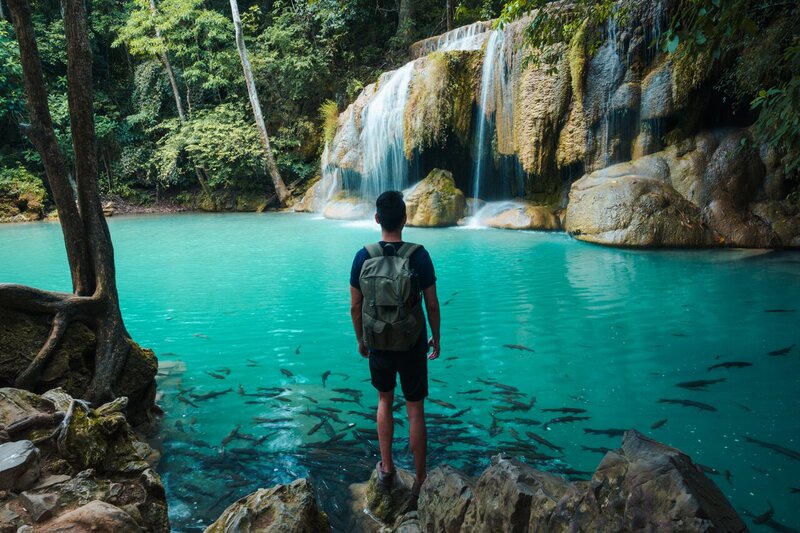





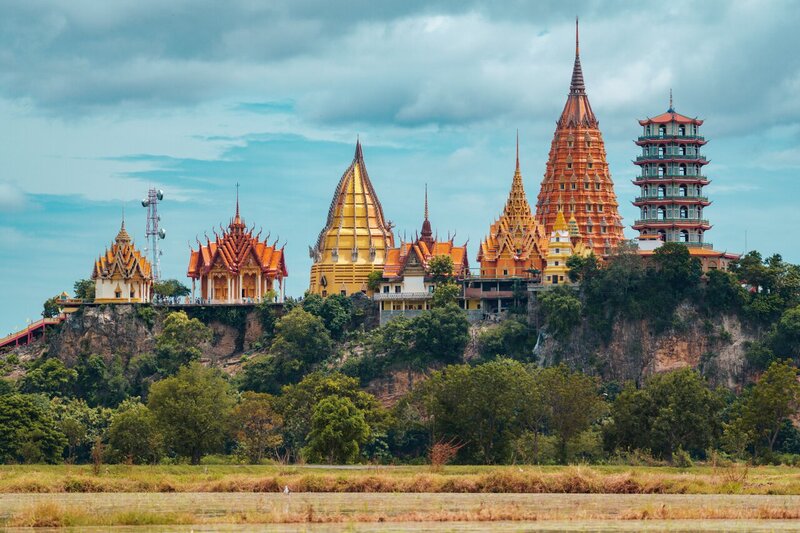










- WesTory (Budget)
- Siam Guesthouse (Mid-Range) 👍 Top Pick
- U Inchantree Kanchanaburi (High-End)
- From Kanchanaburi: Erawan Waterfalls and Hellfire Pass (8 hours) 🏅 Top Pick
- From Kanchanaburi: Erawan National Park Half Day (4 hours)
- From Kanchanaburi: Kanchanaburi City Tour Half Day (3 hours)
17 Best Things to Do in Kanchanaburi
1. Spend a Day Hiking Around Erawan Waterfalls
One of the first things the owner of the accommodation I was staying in Kanchanaburi told me is that Erawan Falls requires a traveler's full attention. He recommended that I take it slow and spend the entire day exploring the waterfalls and the surrounding attractions, so I followed his advice and I'm glad I did.
Erawan Falls is one of the most magnificent waterfalls in Thailand. With its stunning layers of cascades, clear blue water, and over 7 levels for us to explore, it is not hard to see why people consider it as such.
Since Erawan Falls is 65 km away from Kanchanaburi City, the drive there with a scooter will take you about 1.5 hours, so I recommend you start your day as early as you can. The road there is pretty straightforward, and the road is not difficult to drive on, with the majority of the way on a 4-lane road.
No time to read?
Don't worry. You can save this page to Pinterest and come back later.
You can also take a bus from Kanchanaburi Bus Terminal, which leaves every hour from 8 AM to 5 PM. Once you arrive, you will be right at the first level of the waterfall, where all the cascades are.
There are 7 waterfalls you can hike in the Erawan Falls area, stretching along the 1.5 km trail. The trail from level-1 to level-4 is pretty easy, with each level about a 5-minute walking distance apart.
The trail from waterfall #4 and onward will be a little longer and steeper through a thick forest, so make sure you have proper shoes with you if you want to hike to the top.
Each level has its own charm, and the further you hike, the fewer people you will encounter. At the top, you will be able to see the cliff from where the water comes, and if you are there when the water level is high, you might be able to witness the large waterfall itself.
Unfortunately, I was there when the water was low, so I didn't get to see the huge waterfall. That said, it is still worth the climb, as the color of the pool at the 7th waterfall is so vivid and clear; it kinda makes you want to jump into it. Sadly, due to COVID-19, swimming is prohibited at the moment of writing.
The trail takes about an hour to an hour and a half to hike to the top and about an hour or less to get down. The opening hours are from 8 AM to 4:30 PM, so do prepare accordingly if you plan to hike the whole stretch. The entrance fee is 300 THB (100 THB for Thais), plus 20 THB if you are there with a scooter.
Where to Stay in Kanchanaburi, Thailand?
2. Be Amazed at Phra That Cave
After you are done with Erawan Falls, if you have a few hours to spare, be sure to continue on for about 10 km and visit Phra That Cave, one of the many mountain caves tucked away in the thick forest of Kanchanaburi.
When you arrive at the entrance, you will have to show your Erawan National Park ticket to a ranger, and they will point you to a trailhead where you will have to hike up the steep 600 m stairs for about a 30-minute hike until you arrive at the cave.
Within the cave, you will be guided by a national park ranger to each of the 5 caverns in Phra That Cave, where you will see some of the most stunning rock formations out there, with one looking like a Buddha image and another like a coral reef.
There is an elevated walking path, and the ranger told me that there used to be a working artificial light system. However, it was broken due to a lightning strike a year ago, and the government has yet to release funds to fix it.
The entire walk around the cave should take about half an hour, and the hike up and down should take around 1 hour in total. The cave opens from 8 AM until 4 PM, and it is free if you hold the Erawan National Park ticket.
3. Watch the Sunset at Srinagarind Dam Viewpoint
After visiting Phra That Cave, you can backtrack your way to the Srinagarind Dam viewpoint, where you will be able to relax at the Srinagarind Dam recreational area and enjoy the stunning view of the Srinagarind Dam from the ridge.
There is a small shop as well as a place to sit and eat if you want to sit and rest here for a while after a long scooter ride. The view is pretty nice, and you do not have to pay anything to get in, which is great. That said, be sure to spare some daylight time for your drive back, as you will have another 1.5-hour drive to go.
Tours & Tickets You Might Like
4. Visit the Huay Maekhamin Waterfalls
Huay Maekhamin Waterfalls is, hands down, one of the best waterfalls for swimming in Thailand and a totally hidden gem tourist attraction in Kanchanaburi that not many people know about.
Huay Maekhamin Waterfalls are just like Erawan Falls, with 7 levels of waterfalls you can hike around. All of these levels are as magical as you could imagine.
Best of all, it is way less crowded than Erawan Falls. It has more spacious swimming areas, and the waterfalls at each tier are way prettier. All in all, Huay Maekhamin Waterfall is a prettier, less crowded version of Erawan Falls that nobody knows about.
Why is it not known, you asked? Well, due to its remote location, traveling to Huay Maekhamin Waterfalls and back is a full-day ordeal. It is located even deeper into the national park than Erawan Falls.
The journey from Kanchanaburi city to Huay Maekhamin Waterfalls takes almost 2 hours one-way, so a total of 4 hours of travel time. The area is pretty big, with around 3-4 km worth of hiking to do.
When you first arrive, you will be at the fourth tier of Huay Maekhamin Waterfalls. You can either go left and hike to the upper levels (5th, 6th, 7th tiers) or go right and hike to the lower levels (3rd, 2nd, 1st tiers). Both ways are definitely worth the hike.
But if you are short on time, I highly recommend going for the lower levels trail instead. The 3rd, 2nd, and 1st tiers are some of the most stunning waterfalls you will see in Thailand, with beautiful cascades, lovely water to swim in, and not a whole lot of people around.
The upper levels are a little longer to hike, taking about 30 minutes one-way, but they are not as steep, and the waterfalls aren't as pretty as the lower levels. However, it is still a beautiful nature trail to hike and lose yourself in the untouched nature of the Sri Nakharin National Park.
To access Huay Maekhamin Waterfalls, you will need to pay an entrance fee to the Sri Nakharin National Park, which is 300 THB for adults and 100 THB for children.
The national park is open from 6 AM to 5 PM every day. Expect to spend an entire day here if you are looking to really enjoy what Huay Maekhamin Waterfalls have to offer.
If you are short on time and wondering whether you should visit Huay Maekhamin Waterfalls or Erawan Falls, I highly recommend visiting Huay Maekhamin Waterfalls over Erawan Falls if you prefer a less crowded area to swim in and do not mind a longer drive.
5. Watch the Sunrise at Wat Tham Khao Pun
I was tipped by a local to check out the viewpoint at Wat Tham Khao Pun for a stunning sunrise, and even though I didn't think much of it, I decided to check it out one day. And my god, I don't think there's a better sunrise view than here.
From the viewpoint, you will have an unobstructed panoramic view of the River Kwai and a railway track running alongside, while being surrounded by stunning mountains where the first light of the day emerges.
The viewpoint is located in a temple, and you can freely drive right to the viewpoint for free. No need to pay for parking or anything.
Once at the viewpoint, you will also find a really cozy café called The Curve, and they have a nice balcony overlooking the River Kwai where you can sit and enjoy your morning coffee. The café opens from 9 AM to 6 PM every day.
6. Climb Up to the Top of Wat Baan Tham
After spending 2 days visiting remote waterfalls, we will not be driving our scooter very far today. If you are like me, you are probably exhausted from all the rides the days before. So, we are going to stick to the tourist attractions not too far from Kanchanaburi City, starting with Wat Baan Tham.
Only 12 km away, on the opposite side of the River Kwai, Wat Baan Tham is a hidden gem I accidentally stumbled upon while I was on my motorbike. As you drive along the road, you will see a golden pagoda on top of a mountain where there are stairs leading up to it through a dragon's mouth – no, really!
The dragon caught my attention, and I thought to myself, "What could go wrong with a viewpoint on top of a mountain?" So, I decided to climb it, expecting a grand viewpoint, which it delivers.
What I did not expect to see was a temple built inside a cavern with a giant Buddha image inside it. The place blew me away, and as I was there at 9 AM, the light was shining perfectly on the Buddha image, hence why I have to include this accidental discovery on this list.
For about 15-20 minutes of climbing, you will reach the top where you will find a golden pagoda, a viewing platform, and a panoramic view of Kanchanaburi city, the River Kwai, and the stunning landscapes surrounding it.
Off to the right, you will also get a glimpse of our next destination, the grand temple complex of Wat Tham Suea, one of the most beautiful temples in the province.
Wat Baan Thum is free to enter for both Thais and foreigners, and it opens from 8 AM to 5 PM. There are over 600 steps until you reach the top, and Kanchanaburi's heat can be quite brutal, so do prepare accordingly.
7. Be Amazed at the Scale of Wat Tham Sua
From Wat Baan Tham, it is only a few kilometers until you arrive at Wat Tham Suea, a stunning temple complex consisting of multiple architectural wonders. It includes several towers and pagodas of various architectural styles, as well as an 18-meter-tall giant Buddha image that dominates the Kanchanaburi landscape.
You will have to spend at least an hour or more to see all the structures inside Wat Tham Sua. You can also climb up the two towers, the orange pagoda, and the Chinese tower.
If you are looking for the best viewpoint of Wat Tham Sua and the giant Buddha Image from above without a drone, I highly recommend climbing up to the 6th floor of the orange pagoda where you will find a few tiny windows from which you can look out. There, you can witness the true scale of Wat Tham Sua from above.
What is great about this viewpoint is that, other than the large Buddha image, you will also see all the rice paddies surrounding the area. If you are there right before the harvest season, around March, the temple will be surrounded by lush green rice fields, making it quite a sight to behold.
Wat Tham Sua is open from 8 AM to 5 PM, and it is free for both Thais and foreigners to enter. Be sure to arrive early as the towers may be closed to climbers right before the closing time.
For a great view of Wat Thum Sua from afar, you can also visit Meena Cafe to enjoy a nice cheap cup of ice coffee with a view of the rice paddies. You can also drive a little further and stop by the road here for a less obstructed view of Wat Thum Sua and the rice paddies.
8. Check Out the Giant Raintree
After Wat Thum Sua, you can continue to explore the outer rim of Kanchanaburi City with a drive to the Giant Raintree, which will take you through more remote areas, allowing you to see what it's really like for people living outside of the city.
The Giant Raintree itself is a huge raintree with massive branches that spread over 25.87 meters, providing shade and shielding people from Kanchanaburi's brutal sun for over 100 years. It is a great place to stop by, relax, and rest for a bit before heading back to the city and exploring the attractions within Kanchanaburi city.
The giant raintree is open from 8:30 AM until 4:30 PM, and it is free to enter for both Thais and foreigners.
9. Learn About the Dark History of Kanchanaburi at the Death Railway Museum
After exploring the outer rim of Kanchanaburi city, we drive back to the city itself and explore the attractions within the city's vicinity, starting with the Death Railway Museum.
The Death Railway Museum is a two-floor museum dedicated to the history of the construction of the Thailand-Burma Railway by the Imperial Japanese Army using prisoners of war during the Second World War.
You will be able to learn about the atrocities committed by the Japanese towards both foreign POWs and Asian laborers, as well as see the horrific conditions these people had to endure during the construction of the railways. It was quite an eye-opening experience for me as a Thai, since none of this was taught in schools.
The Death Railway Museum opens from 9 AM - 5 PM, and the entry fee is 150 THB for both Thais and foreigners.
10. Visit Wat Thaworn Wararam
After visiting the museum, you can take a stroll to Wat Thaworn Wararam, a stunning Vietnamese temple situated on the banks of the River Kwai. Wat Thaworn Wararam is quite spacious and features several exquisite structures along the river, including Vietnamese-style towers and a scattering of pagodas.
The place is popular among locals, especially during sunset, where you will find many jogging along the riverbank, as well as hanging out with friends, picnicking, and cooling off by the river. It is a great chance for you to see a slower side of the locals' life.
The temple is free of charge for Thais and foreigners. It is open all day and night, so you can enter anytime. Just beware of the stray dogs as they often pretend to be aggressive by barking, but that's all they do.
11. Learn About World War 2 from the Thai-Japanese side at JEATH War Museum
Right before we visit the River Kwai Bridge, I highly recommend that you visit the JEATH War Museum located right by the bridge for a little bit of history lesson about Kanchanaburi from the prehistoric time to the Second World War.
The museum is run by a local family, so you might find the navigation a little confusing, but the place is jam-packed with a ton of information and artifacts. From the old swords and stones they found in Kanchanaburi to the imperial Japanese airplane and helicopter casually sitting in the courtyard.
Here's a tip for you: If you are looking for a great viewpoint of the River Kwai Bridge, go up to the rooftop of the JEATH museum. There, you will be able to see the bridge from above, along with the view of the landscape surrounding it.
The museum opens from 8:30 AM to 6:30 PM. There is a ton to see and learn here, so be sure to spare some time before the museum closes. The entrance fee is 50 THB for both Thais and foreigners.
12. Visit the River Kwai Bridge
After 2 days of exploring all the other tourist attractions, it's time to finally see the infamous River Kwai Bridge. There's not a ton to do around the bridge except for some street food by the station and a food market across the bridge, but the bridge is pretty enchanting at night.
If you want to see a train crossing the bridge, be sure to be there around 5:30 PM, and you should see one crossing the bridge at that time.
If you are there on the weekends, the World War 2 Bridge Project Market on the other side is quite lively in the evening, so be sure to check that out before you end the day.
13. Drop by at Prasat Mueang Sing Historical Park
On our last full day in Kanchanaburi, we will take the scooter for another spin with a morning visit at Prasat Mueang Sing Historical Park, a historic Khmer-era temple and burial site where several well-preserved skeletons were found, dating back even before the Khmer reign of the area.
There is not a whole lot to see except the main temple with the gate still standing and the burial ground where they discovered the remains of prehistoric people who lived here long before the Khmer Empire reign. But since it is on the way, we might as well stop by to take some photos.
The entrance fee is 100 THB for foreigners and 20 THB for Thais, plus an additional 20 THB for a motorcycle. The historic park opens from 8 AM to 5 PM. If you don't fancy paying, you can skip it. However, if you don't mind and have time to spare, Prasat Mueang Sing offers a nice change of pace to your itinerary.
14. Travel back to the Time of King Rama the Fifth at Mallika R.E 124 Retro City
Mallika R.E 124 City is a newly built themed retro city that replicates and depicts the lifestyle of the people living around the palace during the time of King Rama the Fifth. He was known for abolishing slavery in a modern way.
I often do not like visiting themed tourist attractions that the Thais enjoy so much, as they often focus way too much on artificial props for photos. However, even though it is somewhat similar here in Mallika, the place offers way more than just props for photos.
Some of the architecture here, like the Merchant Turnable Wooden Bridge, is created in a way that is both pleasing to the eyes and enticing to your imagination of what it was like back in the day. The bridge is filled with stalls where you can actually buy items ranging from fruits to souvenirs.
Another great example of Mallika City taking it to the next level is with its ancient market zone. Within the market zone, you will find many food stalls selling Thai traditional food and desserts, from the famous boat noodle to the beloved grilled coconut hotcakes.
What is cool about this is that the food is sold not in Thai Bath but in Thai Stangs, the old currency, and you can get these old coins from one of the many exchange banks nearby, just like how the food coupons work in food courts. It's pretty creative.
You can spend hours just trying all the delicious Thai traditional street food here, and once you are full, you can shed all that fat you gained from eating and climb up to the tower to see Mallika Retro City from above.
Expect to spend around an hour or more exploring and eating food at Mallika. The place is open from 9 AM to 5:30 PM, and the entrance fee is 200 THB for both Thais and foreigners.
15. Watch the Train Crossing the Tham Krasae Death Railway Bridge at 1:30 PM
After having lunch at Mallika, if you want to see a train crossing a mountainside wooden bridge, which is a popular section of the Death Railway, you will have to get to Tham Krasae Train Station before 1:30 PM.
It isn't far from Mallika, so you should be able to get here on time if you leave Mallika around 12:30 PM. Once you arrive, you can spend your time walking along the wooden railway bridge, or you can wait for the train to go first.
Next to the Tham Krasae Train Station, you will find the Wat Krasae Cave where the train station got its name from. It isn't big, nothing like Phra That Cave we saw on our first day, but still, a great spot to step away from the railway for the train to go.
After the train leaves, you can then walk along the railway to the next station and back. It's a nice little walk with metallic plates installed on the railway for people to walk on. Just be careful not to step off the path, and you should be fine.
16. Visit Hellfire Pass Interpretive Centre
After visiting Thum Krasae, you can then continue on with your scooter for another hour and visit Hellfire Pass Interpretive Centre, a highly acclaimed museum dedicated to the event where the Japanese forced the Allied prisoners of war and Asian laborers to cut through this treacherous section of the Pass, resulting in a heavy loss of life.
The museum is beautifully designed, with excellent displays of information, presentations, and videos that help guide you through the gruesome history of what took place at Hellfire Pass.
After a 30-minute stroll around the museum, you will have the option to choose between 2 nature walks at the end. The shorter one goes to the monument through sections of the pass, which takes about 15 minutes to walk, and another 2.5 km trail that takes 3 hours to complete.
I went with the shorter hike, as the longer hike seemed like a bad idea since it was blazingly hot outside when I was there. If you are interested in learning more about the forgotten history of World War 2, you won't regret visiting the museum.
Hellfire Pass Interpretive Centre is open from 9 AM to 4 PM, and the entrance is free for both Thais and foreigners.
17. Visit Sai Yok Waterfalls
Last but not least, if you started your day early and still have some daylight left, you can continue on even further and check out the Sai Yok Yai and Sai Yok Noi Waterfalls.
I didn't have enough time that day, so I decided to visit the Sai Yok Waterfalls area on my way back from visiting other places further north. To me, it was quite nice but not worth riding a motorbike all the way from Kanchanaburi City, unless you plan to stay at one of the many floating bungalows along the River Kwai.
Where to Eat and Drink in Kanchanaburi?
Sip a Cup of Coffee at Meena Cafe
As mentioned previously, a great place to have a coffee with a view of Wat Tham Sua and the rice paddies is Meena Cafe. They are one of the first cafes to open up around here and have made a name for themselves with their stunning views of the rice paddies and the temple, until a bunch of other restaurants decided to copy the idea and open up nearby.
The view is stunning, especially if you go right before the harvest season in March, with an indoor seating area and several outdoor seating areas where you can be closer to nature. Like many tourist attractions catered to Thai tourists, there are tons of photography props, but if you ignore all of that, the view is still pretty nice, and the cafe offers a great refuge from the brutal Kanchanaburi sun.
Despite its amazing view, the price of coffee, drinks, and food is actually quite reasonable, with an iced coffee costing around 60 THB. The café is open from 8:30 AM to 6:30 PM and can be a great stop before you visit Wat Tham Sua.
Eat 15 THB Noodles at JJ Night Market in Kanchanaburi
One of the greatest joys of traveling in Thailand for me is walking around night markets and picking all the delicious and cheap street food to try, and you can do just that here at the JJ Night Market in Kanchanaburi.
Located not too far from the Death Railway Museum, you will find plenty of street food, snacks, and drinks for you to indulge yourself in. What caught my attention the most is a vegetarian noodle stall where you can get a box full of tasty noodles for only 15 THB, and then you can buy other things in the market to mix and match your dinner to your liking. If you like Thai street food as much as I do, you will love this place.
Try Thai Traditional Desserts and Snacks at Mallika
As I mentioned earlier, one of the best things about visiting Mallika R.E 124 City is the availability of Thai traditional snacks and food, as well as the experience that will entice your curiosity about what it would have been like to live in 1905 during Rama the 5th's rule.
There are foods like Pad Thai and boat noodle that you can eat at Mallika, but the most delicious things to try here are the snacks. The grilled coconut hotcakes and the Thai-style iced coffee are to die for, as well as Thong Yip, Thong Yod, and many other traditional snacks, to name a few.
Drink by the River Kwai at World War 2 Bridge Project Market on the Weekends
Again, if you are in Kanchanaburi on a weekend and are looking for a place to eat and drink by the River Kwai, be sure to cross the river in the evening and check out World War 2 Bridge Project Market, where you can find several small bars, street food stalls, and plenty of places to sit and enjoy the view.
When to Visit Kanchanaburi, Thailand?
The best time to visit Kanchanaburi is from November to January, when the weather is cooler and less humid due to Thailand's climate, making it much more enjoyable to ride a scooter around.
That said, Thailand has suffered a lot from air pollution in recent years due to the burning season, and it is extremely prevalent during Thailand's winter period (December - January). So, even though the weather is cooler, your visibility might not be the best. Be sure to buy a face mask if you decide to visit Thailand during this time.
March - April are the hottest and most humid periods of the year, so if you can't handle heat very well, avoid visiting during this time. The air quality may be a bit better during this time, though it's not guaranteed.
All the other months are considered to be a rainy season, which, even though the weather is a little more manageable than the summer months, you will also be seeing a lot more rain that might prevent you from enjoying the outdoors. Air quality during this time should be better due to the rain.
As you can see, the best time to visit Thailand used to be during its wintertime. BUT now that the air quality is getting worse and worse, you will have to decide which is more important to you as a traveler: good weather but bad air quality, or vice versa.
How to Get to Kanchanaburi, Thailand?
Kanchanaburi is around 140 km away from Bangkok, and there are several ways you can get to this historical city. However, first, you will have to get to Bangkok. Thankfully, Bangkok is a large hub in the region, so you should have no trouble finding a flight from your home country to Suvarnabhumi International Airport or Don Muang International Airport (budget airlines only), Thailand.
From the US, unfortunately, there are no direct flights to Chiang Mai or Bangkok, so you will have to rely on transit flights by Emirates, Qatar, or Turkish Airlines from the East Coast or ANA Airlines or Korean Air from the West Coast.
From Europe, you can fly from most popular European hubs like London, Paris, or Frankfurt via Thai Airways or local carriers such as British Airways, Air France, or Lufthansa to Bangkok. You can also choose Etihad, Qatar, or Emirates if you don't mind transiting.
From within Asia, there are several low-cost airlines offering numerous routes from several hub cities such as Singapore, Kuala Lumpur, Tokyo, Jakarta, to Bangkok. AirAsia and Thai Lion Air are excellent low-cost options.
To find a cheap flight to Bangkok, I would recommend that you use Skyscanner or Expedia to look for the cheapest route and schedule. This way, you can compare and pick the best one.
Getting from Bangkok to Kanchanaburi, Thailand
By Bus/Van: From Bangkok, the easiest way to get to Kanchanaburi is to take a van from the Mini-Bus stand across the road from the Morchit Bus Terminal.
You can reach Morchit Terminal from almost anywhere in Bangkok via either MRT station Kamphaeng Phet station or BTS Morchit station, and then from there, you can take a taxi to Morchit Bus Terminal. The taxi should cost no more than 50 THB.
Once you arrive at the Morchit bus terminal, cross the road to the mini-bus stand with the footbridge, and go to Building D to buy your ticket at either kiosk #8 or #11. Once you arrive at Building D, you can also ask around, and they will direct you to the right kiosk.
The mini-bus and vans from Bangkok to Kanchanaburi leave every hour from 5 AM to 8 PM every day. The journey will take around 3 hours and the ticket will cost about 120 THB. When you buy your ticket, they will ask you where you want to get dropped off.
If you decide to book one of the accommodations I recommended here, you can tell them to drop you off at the Kanchanaburi Train Station. If not, simply pick a large landmark near your accommodation and they will tell you where they can drop you off.
You usually do not have to reserve your ticket beforehand, but since Kanchanaburi is quite popular among locals, it might be worthwhile to book one if you decide to travel on the weekends.
Book a Van from Bangkok to Kanchanaburi
By Train: You can also travel from Bangkok to Kanchanaburi by train, and vice versa. However, it is important to note that you will only be crossing the River Kwai Bridge and not the mountainside section of the Death Railway, unless you continue your journey beyond Kanchanaburi to Tham Krasae Station.
A better way to see both is to take the train back instead. I would recommend you take the 1:35 PM train back from Tham Krasae Station to Thonburi (Bangkok) so that you will be able to witness both sections. This way, you will also get to see more of the treacherous terrain along the Death Railway.
There are two trains leaving from Tham Krasae at 5:57 AM and 1:35 PM, so basically only one is a viable option for a normal human being here. The train from Tham Krasae to Thonburi (Bangkok) will cost 100 THB for foreigners and 39 THB for Thais. It takes about 5-6 hours, and when you arrive in Thonburi, you can take the MRT Bang Khun Non Station to wherever you are staying in Bangkok.
If you still want to take a train from Bangkok to Kanchanaburi, despite it not going through much of the Death Railway, there are 2 trains from Thonburi Train Station in Bangkok to Saphan Kwae Yai Station at 7:50 AM and 1:55 PM, where it will take you directly to the River Kwai bridge.
I personally prefer taking a van to Kanchanaburi, and then on the day back, take a bus to Tham Krasae Train Station. From there, take a train through both the mountainside wooden bridge and the River Kwai Bridge back to Bangkok.
How to Get Around Kanchanaburi City, Thailand?
By Bike: If you are only planning to explore the tourist attractions around the city's vicinity like the River Kwai Bridge and the 2 museums there, a bike is a great way to go around the main tourist strip. If you stay at the Siam Guesthouse, the owner might even lend you his bike for free for a day.
That said, if you plan to go any further than that, you will have to rent a scooter, especially if you want to follow the itinerary I have here. You might be able to get away with a public bus to Erawan Falls or Saiyok National Park, but for all the other places, you are better off with your own vehicle.
By Scooter: This is by far the best way to get around Kanchanaburi city and all its attractions. With a scooter, you will be able to cover all the tourist attractions listed here in just 3 days.
To rent a scooter, I recommend NP Motorcycle Rental Store, located along the main tourist road. They have a wide selection of old and new scooters for you to choose from.
The price to rent a scooter is 200 THB per day. You will have to leave your passport (this is quite a common practice in Southeast Asia, so do not be alarmed) as well as pay a 1000 THB deposit for the scooter, and you will get them back when you return the scooter.
For this itinerary, with the scooter, you will be able to get to all the places in 3 days. The furthest you will be driving is around 80 km to Hellfire Interpretive Center or 100 km if you want to go the extra mile and visit Sai Yok National Park, which will take you around 1.5 - 2 hours, so be sure to start early.
By Bus: If you are not a strong scooter driver, you can also opt for buses for long-distance attractions like Erawan Falls and Hellfire Interpretive Center. There are buses passing through these attractions almost every hour every day from Kanchanaburi Bus Terminal, starting from 8 AM until 5 PM.
How Many Days to Spend in Kanchanaburi?
For this itinerary, to complete all of them, you will need at least 3 full days. So staying 4 nights in Kanchanaburi city is ideal. But if you do not have the time, we can easily divide the itinerary into each day, and then you can pick which days you want to follow.
Day 1: Erawan Falls, with its 7 levels that you can hike, is definitely worth spending an entire day. This is a must, in my opinion, and you can do it even when it's rainy, so I recommend you start your trip with the Falls. You can then spend the rest of the day at the Srinagarind Dam, visiting the viewpoint and the Phra That Cave, etc.
Day 2: On your second day, you can take it slow and explore the tourist attractions within the city, such as the two war museums, River Kwai Bridge, and perhaps Wat Thum Sua and Wat Ban Thum.
Day 3 (Optional): On the last day, you can drive up to Sai Yok Yai Waterfall in the morning, visit the Hellfire Interpretive Center, see the train cross the deathly mountainside bridge at Thum Krasae, and visit Mallika and Prasat Mueang Sing Historical Park on your way back to the city.
How Much Money Do I Need For Kanchanaburi?
Basing on the 3-night itinerary above, we can roughly calculate how much we will be spending for this Kanchanaburi itinerary as follows:
Accommodation: Four nights of accommodation will cost you at least 40 USD.
Food: Food in Kanchanaburi should cost about 40 THB minimum per meal, so you can expect to pay around 360 THB for 3 days in Kanchanaburi.
Transportation: For the bus journey from Bangkok to Kanchanaburi, it should cost you around 120 THB. Additionally, with the 200 THB per day for a scooter rental for 3 days, you can expect to pay around 870 THB for transportation in Kanchanaburi, including the extra 150 THB for gas.
Activities: For Erawan Falls, you will have to pay 300 THB (100 THB for Thais) plus 20 THB for your scooter. This ticket will also include Phra That Cave as well. For Prasat Mueang Sing Historical Park, you will have to pay 100 THB (20 THB for Thais) plus 20 THB for your scooter. For Mallika, it's 200 THB for both Thais and Foreigners. For Death Railway Museum and JEATH War Museum, you will have to pay 150 THB and 50 THB respectively, so in total, you will pay about 840 THB for activities.
Total Budget for 3 days in Kanchanaburi: 3,330 THB (105.6 USD)
Is it Safe in Kanchanaburi, Thailand?
Like most of Thailand, Kanchanaburi is very safe, and it is unlikely that you will meet any undesirable scammers, which you often encounter in other crowded places like the Grand Palace in Bangkok. That said, use the prices I have listed here as a base price and try to negotiate if the price is higher than what I have listed.
Which tourist SIM card is best for Thailand?
Update: If your phone supports eSIM, I highly recommend checking out Airalo, a global eSIM marketplace. It allows you to stay connected affordably while traveling in Kanchanaburi, Thailand without having to switch out your physical SIM card.
Gone are the days when you needed to scramble to find a local SIM card at an airport upon arrival. You can purchase an eSIM before your arrival, and you'll be good to go. If your phone doesn't support eSIM, here is how you can get a local SIM card in Kanchanaburi, Thailand:
There are 3 major carriers in Thailand: AIS, DTAC, and True, all of which offer a pretty similar range of traveler's packages as well as coverages. I personally use AIS as I have been with them since my first phone, and they have a lot of Support Centers around Thailand. Their coverage hasn't failed me yet, so if you are looking for a reliable carrier, I can recommend AIS.
There are 3 packages for tourists: 5 GB for 5 days at 160 THB, 15 GB for 8 days at 299 THB, and 30 GB for 15 days. Depending on how long your trip to Thailand will be, you can pick one of these 3 packages that fit your itinerary the most.
With these 3 packages, you can top up more in case you need more data or calls for your trip. More often than not, 5 GB is more than enough for me to travel around Thailand for a month.
For more information about Thailand's local SIM card: Thailand's Prepaid Data SIM Card.
Tips: To stay connected with people at home, be sure that you have a VPN, such as ProtonVPN, installed before traveling. It's FREE, and you can gain access to services that may be blocked in certain countries.
What to Pack for Kanchanaburi, Thailand?
As you may already know, I am an advocate of light traveling, and indeed, packing light for a journey like this is a unique art form. Here are some packing tips for your upcoming trip to Kanchanaburi, Thailand:
- Walking/Hiking Shoes: With all the walking and possible hiking during your travel, a comfortable pair of shoes is a must. I recommend the Timberland 3-Eye Classic Boat Shoes that are my go-to pair for long strolls and hikes.
- Breathable Shirts: Given the potential for hot weather, pack a few breathable shirts for your outdoor adventures.
- Shorts/Jeans: Anticipate lots of walking during your travels? Be sure to pack some breathable shorts and a pair of Levi's jeans for when the weather cools. For women, leggings are excellent for both hot and cold climates, so consider packing some as well.
- Outer Shell Jacket: An outer shell jacket is great for windy or rainy conditions. I highly recommend the Columbia Watertight Jacket (for women). It's lightweight, breathable, and even comes in a cool orange color.
- Microfiber Towel: A Microfiber towel is the ideal backpacker's towel due to its lightness, quick drying, and compressibility.
- Swim Suits: A swim trunk is a must-pack item if you are planning to visit Kanchanaburi, Thailand in the summer, just in case there is a body of water you can jump in.
- Camera: You should also pack a good camera for your trip so that you can capture all the beautiful experiences you might have. I recommend the Sony a7R V camera together with the Sony 24-70mm f2.8 GM II lens, which is probably the highest-performance camera and lens combination you can get right now.
- Power Bank: Keep your electronics charged on the go with a 20,000+ mAh Power Bank.
- Water Bottle: The Hydro Flask Trail Water Bottle is a great insulated water bottle to have with you in cities or on hiking trails. It is lightweight and can keep your water cold or warm for more than 12 hours. It's a total game-changer.
- Universal Adapter: You'll need just one universal adapter to plug in your electronics in any country you visit.
- Packing Cubes: Packing Cubes will help you save space in your backpack and keep all your belongings organized.
- Daypack: The Langly Alpha Globetrotter is my go-to everyday camera backpack. It's large enough to carry all my travel gear, and it comes with plenty of slots and pouches. Plus, it's stylish as hell!
- Large Backpack: You will need a large backpack to carry all of your stuff. I recommend the Osprey Atmos AG 65L backpack. With excellent weight distribution and a lifetime guarantee, you can't go wrong with Osprey.
For more information on what I pack in my backpack for this trip, check out: My Packing List: 60 Travel Essentials.
That is it for the 17 Incredible Things To Do In Kanchanaburi, Thailand for Solo Travelers. Have we missed anything? Have you found the guide useful? Let us know in the comments below!
Now that we have all the information we need, it's time to plan your trip to Kanchanaburi, Thailand! Here are some resources to help you get your trip going:
Are you planning to travel to Kanchanaburi, Thailand independently? Be sure to check out my guide on How To Plan A Backpacking Trip here.
Further Reading for Central Thailand
Looking for more information for your trip to Central Thailand? Here are a collection of articles about Central Thailand that you might find useful:
- Looking for a complete travel guide to Southeast Asia? You should check out our 3-Month Backpacking Itinerary for Southeast Asia.
- Planning a trip to Thailand? Here are the 11 Best Places to Visit in Thailand.
- Visiting a country like Thailand, you are going to need a comprehensive packing list to ensure you bring everything you need for your trip. Check out: What to Pack for Thailand - The Essential Packing List.
- Wondering when the best time to visit Thailand is? Here is a complete guide on picking The Best Time to Visit Thailand.
- Want to spend one month backpacking around Thailand? Check out: One Month Itinerary for Thailand.
- Have 2 weeks in Thailand? Check out this itinerary: 2 Weeks Backpacking Thailand Itinerary.
- Have only 10 days in Thailand? This itinerary might be more suited for you: 10-day Itinerary for Thailand.
- Thai Street Foods are among the best in the world, and to help guide you through the street food cuisine of Thailand, be sure to check out the 15 Best Street Foods in Thailand to Try.
- Learning a bit of Thai phrases will go a long way for you when you visit Thailand. Here are 15 Thai Phrases You Should Know.
- If you are traveling to Thailand, it is important for you to know what you should and shouldn't do. Here are 10 Tips for Traveling in Thailand.
- More often than not, your journey in Thailand will begin in Bangkok, and there are a ton of things you shouldn't miss in this city. Here are the 16 Best Things to Do in Bangkok.
- Want to spend a day outside Bangkok but not sure where? Here are the 9 Best Day Trips To Make From Bangkok.
- Escape the bustling city of Bangkok and cycle around Bang Krachao, the green lung of Bangkok, with this travel guide: A Complete Travel Guide to Bang Krachao.
- Don't have a lot of time in Bangkok? Check out our One Day in Bangkok Itinerary.
- Have more than one day in Bangkok? I highly recommend spending at least 3 days in Bangkok. Here is a complete 3 Days Itinerary for Bangkok.
- For the best areas and neighborhoods to stay in Bangkok, check out: 7 Best Areas to Stay in Bangkok.
- Looking to escape Bangkok for a little while? How about exploring the ancient city of Ayutthaya? Here are the 12 Best Things to Do in Ayutthaya for Backpackers.
- Looking for a unique place to visit that is not too far from Bangkok? How about Ratchaburi and its stunning mountains? Here are the 13 Best Things to Do in Ratchaburi.
- Looking for a place to visit for a short beach vacation near Bangkok? One of the best places to visit is Phetchaburi, and here are the 10 Best Things to Do in Phetchaburi.
- For the very best beaches near Bangkok, I highly recommend you visit Hua Hin, a small seaside city full of stunning mountains and secluded beaches waiting for you to explore. Here are the 10 Best Things to Do in Hua Hin.
- Here is how to visit Erawan Falls, the most beautiful waterfall in Thailand. A Complete Hiking Guide to Erawan Falls, Kanchanaburi.
- Let’s get off the beaten path and visit Sangkhlaburi, a small Mon village by the border between Thailand and Myanmar. Here are the Top 10 Things to Do in Sangkhlaburi, Thailand.
- Pilok is probably a travel destination in Thailand you have never heard of, and here is why you should visit it. Here's The Ultimate Backpacking Guide to Pilok Village.
- Have an entire week to spare and would like to go beyond the surface in Kanchanaburi and explore the less traveled route of the province? This travel guide is for you: One Week Itinerary for Kanchanaburi, Thailand.
- Nakhon Pathom offers a great day trip for those who are looking to visit some places off the tourist beaten path in Thailand. Here are the 8 Best Things to Do in Nakhon Pathom.
- Due to its proximity, Samut Prakan is also a great place to visit as a day trip from Bangkok. They have quite an impressive list of things to do that will keep you occupied for a day. Here are the 7 Best Things to Do in Samut Prakan.
- For a quick trip from Bangkok, Lopburi is a great destination to travel to. Here are 10 Best Things to Do in Lopburi, Thailand.
- Want to escape Bangkok and be with nature for a few days? How about a 2-day trip to Saraburi? Here are the 10 Best Things to Do in Saraburi, Thailand.
- Looking to do some hiking near Bangkok? Here’s a One-Day Hiking Guide to Krok E-Dok Waterfall.
- Home to one of the largest Buddha images in the country, Ang Thong is worth a visit if you are interested in seeing the best temples in Thailand. Here are the 10 Best Things to Do in Ang Thong, Thailand.
- What do you know about the brave warriors of Bang Rachan of Singburi? Well, find out for yourself with the ultimate travel guide and 8 Best Things to Do in Singburi, Thailand.
- Want to explore other parts of Thailand? How about exploring Northern Thailand or Southern Thailand?
- Wondering where to go after Thailand? How about you continue on to Malaysia, Myanmar, or Indonesia?
- For all articles about Thailand, visit the Thailand Travel Guide page.
- Looking to travel to Southeast Asia? Check out all my articles about Southeast Asia here: Southeast Asia Travel Guide page.
- You can see all my Asia-related articles here: Asia Travel Guide page.
- For more of my travel guides like this, visit my Destinations page.
